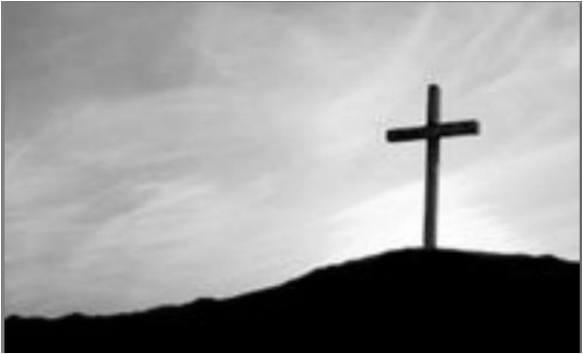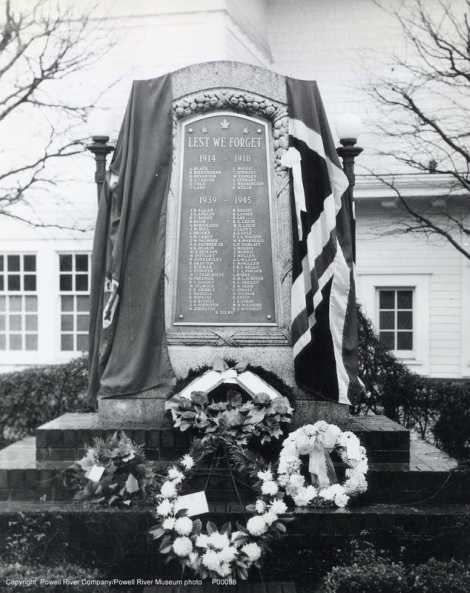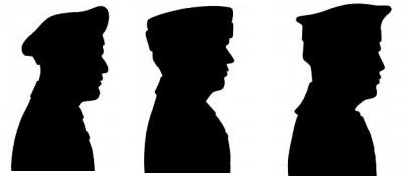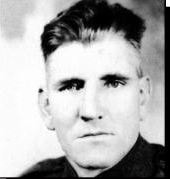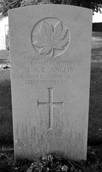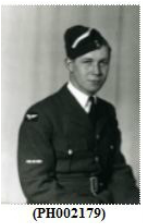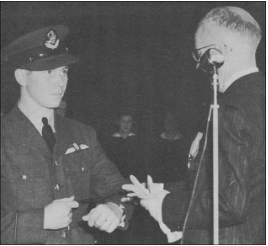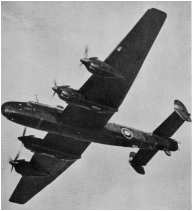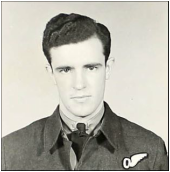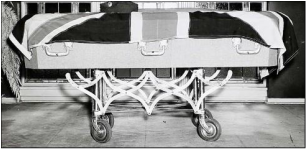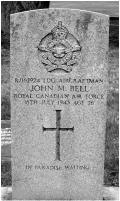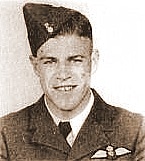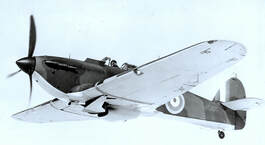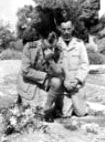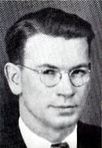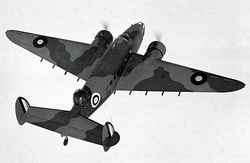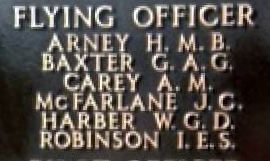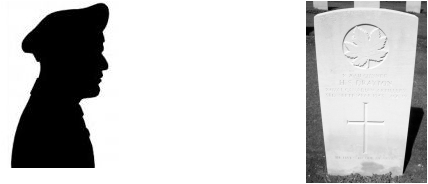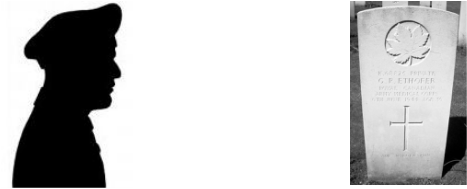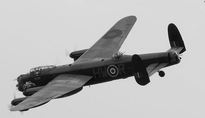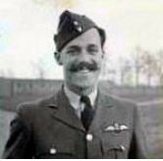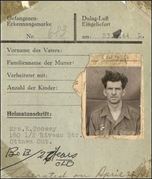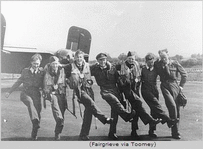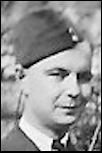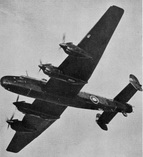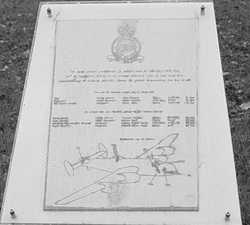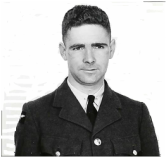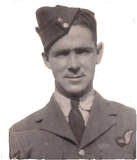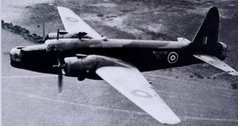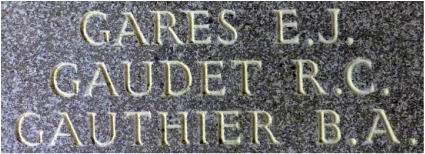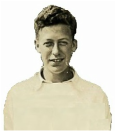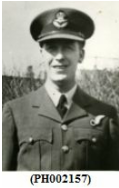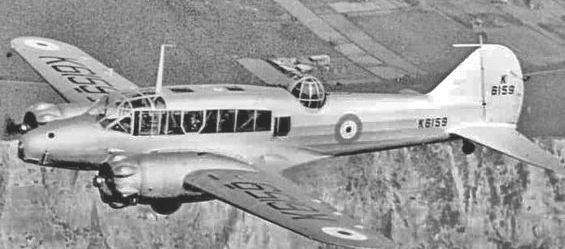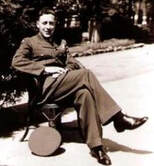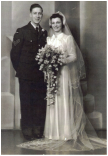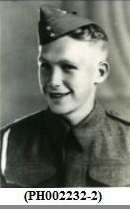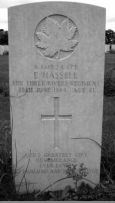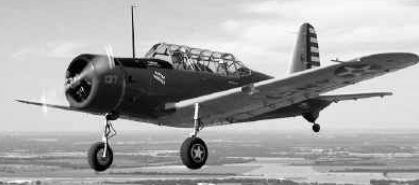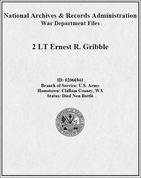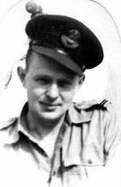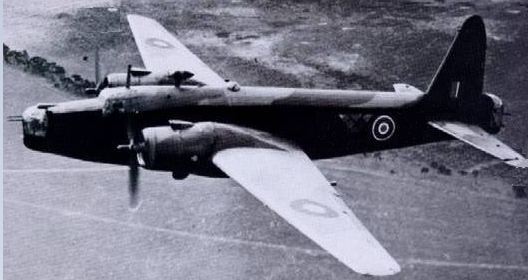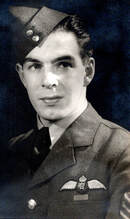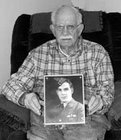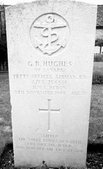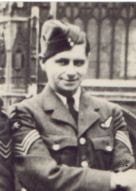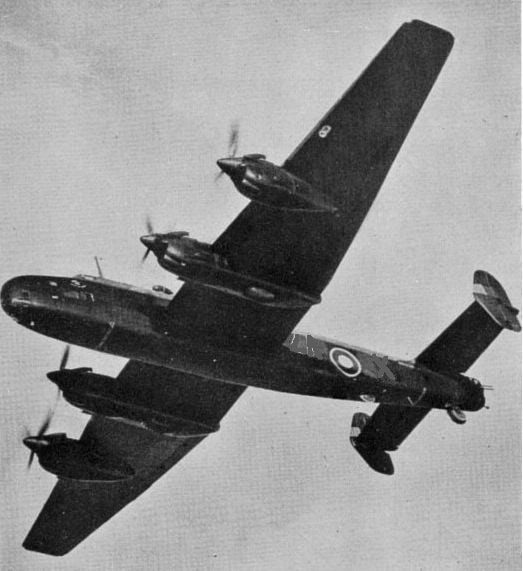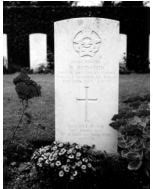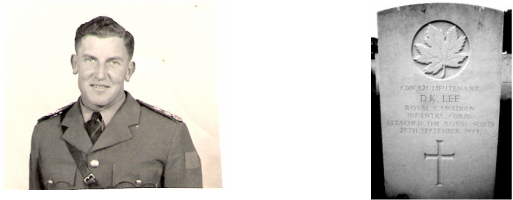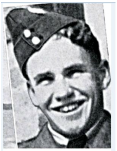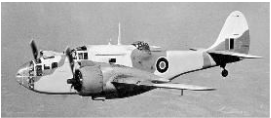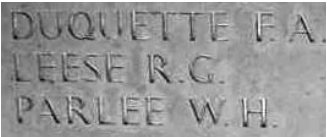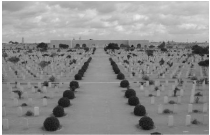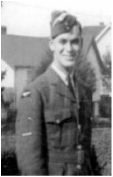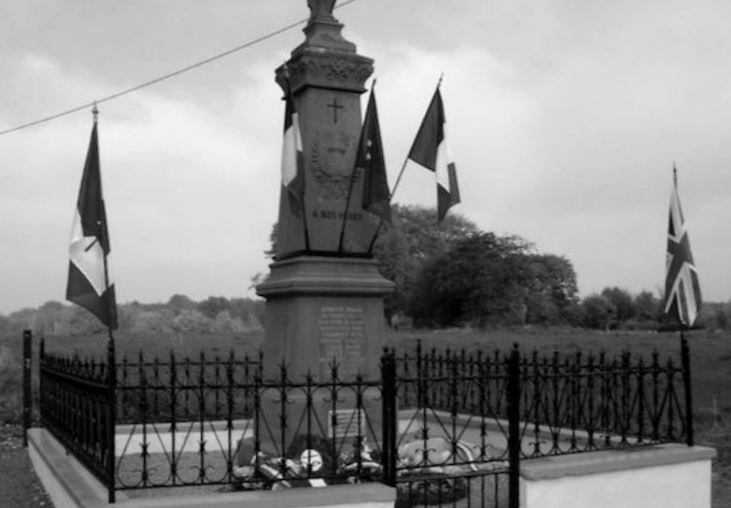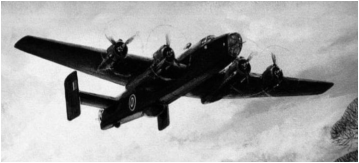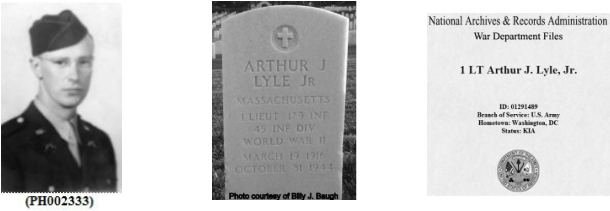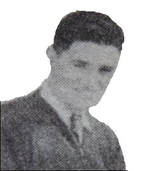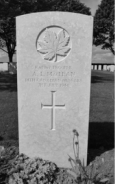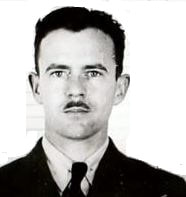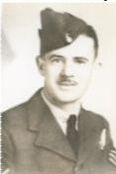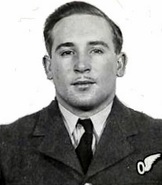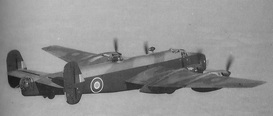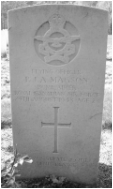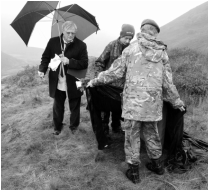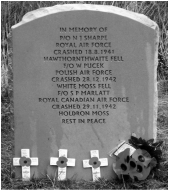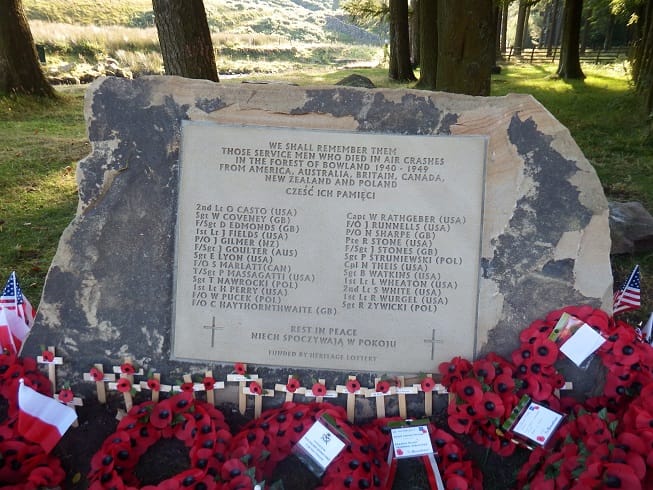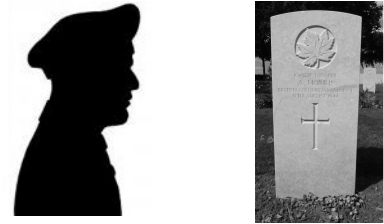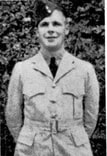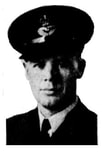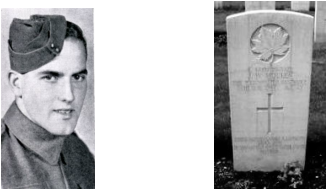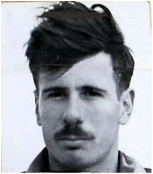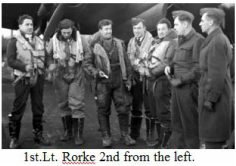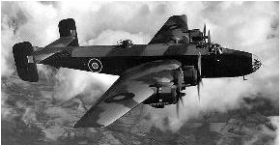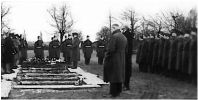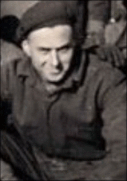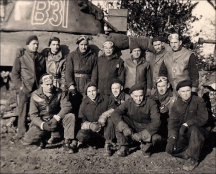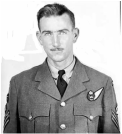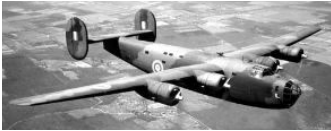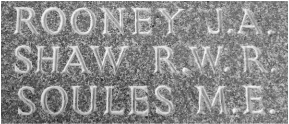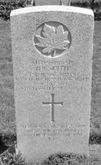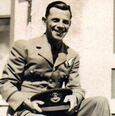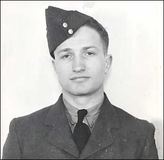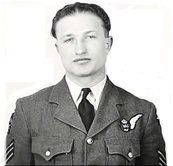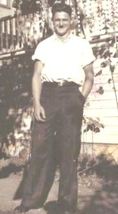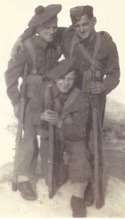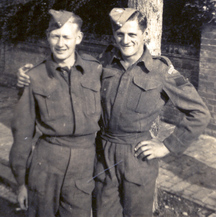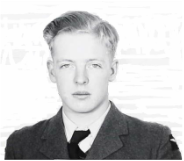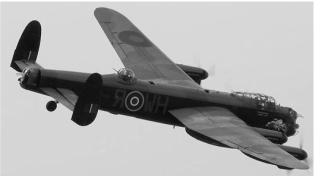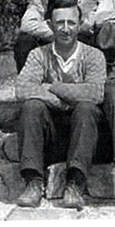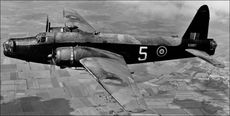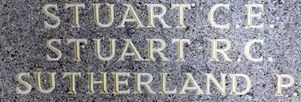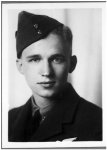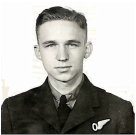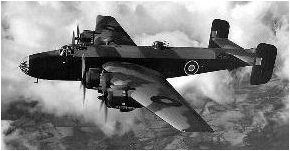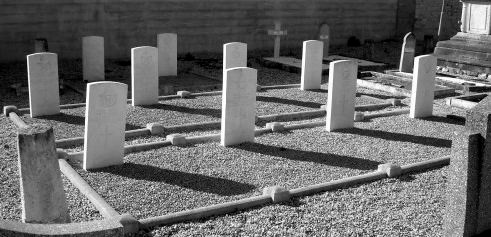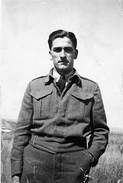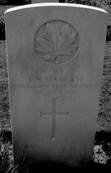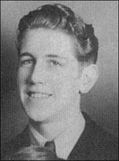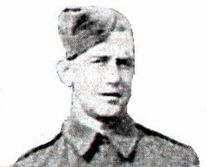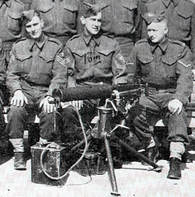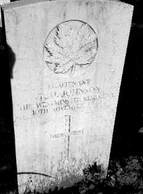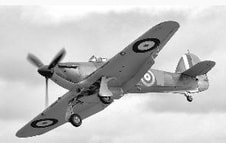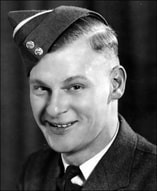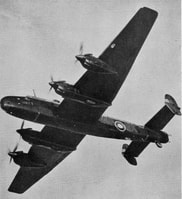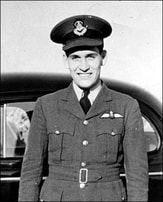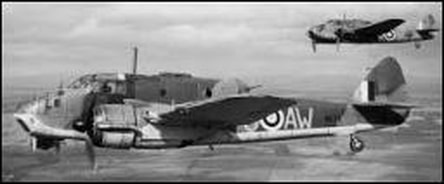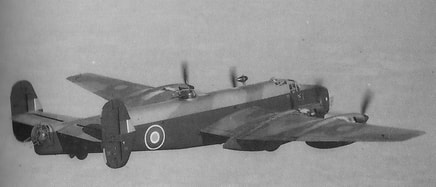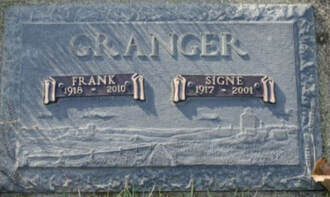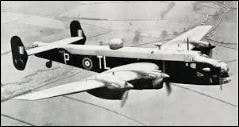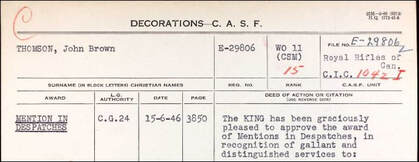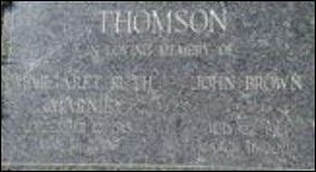Powell River's Unsung Heros Of World War II
"Never has so much been owed by so many to so few".
Sir Winston Churchill.
This site is dedicated to the 63 Servicemen who had ties to the Powell River, British Columbia, Canada area, who made the supreme sacrifice in World War II.
In 1944, Powell River had an area population of 8,000. 1,012 Men and 55 Women enlisted in WWII. 63 Men gave their lives and there were 9 Prisoners of War who returned home after the war was over.
Tragically, 5 of these men were killed in Flying Training accidents, while
10 more were killed in Flying accidents.
Over 700 of these men, were employed by the Powell River Company.
And those that wanted, had jobs waiting for them when they returned.
All of these boys were intimately known to almost everyone in the community.
These boys-those killed-the missing-the prisoners of war-
were all Bill and Harry and George and Dick to us.
Powell River Digester June, 1945.
Some time ago, I thought that there has to be a better way of remembering these brave men who made the supreme sacrifice.
Other than their last names and initials, cast onto a bronze plaque.
Who were they?.
Sir Winston Churchill.
This site is dedicated to the 63 Servicemen who had ties to the Powell River, British Columbia, Canada area, who made the supreme sacrifice in World War II.
In 1944, Powell River had an area population of 8,000. 1,012 Men and 55 Women enlisted in WWII. 63 Men gave their lives and there were 9 Prisoners of War who returned home after the war was over.
Tragically, 5 of these men were killed in Flying Training accidents, while
10 more were killed in Flying accidents.
Over 700 of these men, were employed by the Powell River Company.
And those that wanted, had jobs waiting for them when they returned.
All of these boys were intimately known to almost everyone in the community.
These boys-those killed-the missing-the prisoners of war-
were all Bill and Harry and George and Dick to us.
Powell River Digester June, 1945.
Some time ago, I thought that there has to be a better way of remembering these brave men who made the supreme sacrifice.
Other than their last names and initials, cast onto a bronze plaque.
Who were they?.
The Canadian Armed Forces:
Casualties.
42,042 men and women of Canada's armed forces died during the war : 22,917 in the Canadian Army, 17,101 in the RCAF and 2,024 in the RCN. 54,414 were wounded and 8,995 taken prisoner.
LEGEND: KIA Killed in Action- KFA Killed in a Flying Accident -KTA Killed in a Training Accident.
POW- Prisoner of War.
RCAF- Royal Canadian Air Force. RAF- Royal Air Force.
RAAF- Royal Australian Air Force. RNZAF- Royal New Zealand Air Force.
USAAF- United States Army Air Force. SAAF- South African Air Force.
RCIC- Royal Canadian Infantry Corps. RCAC- Royal Canadian Armoured Corps.
RCNVR- Royal Canadian Navy Volunteer Reserve.
RAF/RCAF/RAAF/RNZAF Ranks used in this Web Site:
G/C-Group Captain, W/C- Wing Commander, S/L- Squadron Leader, F/L-Flight Lieutenant,
F/O- Flying Officer, P/O- Pilot Officer, WO2,-Warrant Officer Second Class,
WO 1- Warrant Officer First Class, FS- Flight Sergeant, Sgt.- Sergeant. Cpl.-Corporal,
LAC-Leading AirCraftsman, LAC 1- Leading AirCraftsman Class 1, LAC 2-Leading AirCraftsman Class 2.
Canadian Army Ranks used in this Web Site:
Lt. Col.- Lieutenant Colonel, Maj.-Major, Capt.- Captain, Lt.-Lieutenant, Sgt.-Sergeant, L. Cpl-Lance Corporal.
Pte.-Private.
Royal Canadian Navy Ranks used in this Web Site:
Com.- Commander, Lt. Com.- Lieutenant Commander, Lt.- Lieutenant, P.O.- Petty Officer.
United States Army Air Force Ranks used in this Web Site
Lt.-Lieutenant, 1st Lt- 1st Lieutenant, 2nd Lt. 2nd Lieutenant.
*Please check this site from time to time as I make changes as I receive new information*
Casualties.
42,042 men and women of Canada's armed forces died during the war : 22,917 in the Canadian Army, 17,101 in the RCAF and 2,024 in the RCN. 54,414 were wounded and 8,995 taken prisoner.
LEGEND: KIA Killed in Action- KFA Killed in a Flying Accident -KTA Killed in a Training Accident.
POW- Prisoner of War.
RCAF- Royal Canadian Air Force. RAF- Royal Air Force.
RAAF- Royal Australian Air Force. RNZAF- Royal New Zealand Air Force.
USAAF- United States Army Air Force. SAAF- South African Air Force.
RCIC- Royal Canadian Infantry Corps. RCAC- Royal Canadian Armoured Corps.
RCNVR- Royal Canadian Navy Volunteer Reserve.
RAF/RCAF/RAAF/RNZAF Ranks used in this Web Site:
G/C-Group Captain, W/C- Wing Commander, S/L- Squadron Leader, F/L-Flight Lieutenant,
F/O- Flying Officer, P/O- Pilot Officer, WO2,-Warrant Officer Second Class,
WO 1- Warrant Officer First Class, FS- Flight Sergeant, Sgt.- Sergeant. Cpl.-Corporal,
LAC-Leading AirCraftsman, LAC 1- Leading AirCraftsman Class 1, LAC 2-Leading AirCraftsman Class 2.
Canadian Army Ranks used in this Web Site:
Lt. Col.- Lieutenant Colonel, Maj.-Major, Capt.- Captain, Lt.-Lieutenant, Sgt.-Sergeant, L. Cpl-Lance Corporal.
Pte.-Private.
Royal Canadian Navy Ranks used in this Web Site:
Com.- Commander, Lt. Com.- Lieutenant Commander, Lt.- Lieutenant, P.O.- Petty Officer.
United States Army Air Force Ranks used in this Web Site
Lt.-Lieutenant, 1st Lt- 1st Lieutenant, 2nd Lt. 2nd Lieutenant.
*Please check this site from time to time as I make changes as I receive new information*
P.J.B. ALLAN:
Records indicate that there was a J.B. Allan who was employed by the Powell River Company, prior to the War years.
I'm hoping that someone will be able to supply me with a few leads on this Serviceman.
12-James Albert Edward ANGLIN: Private, (K69442) KIA: Died June 6/44 (D-Day) Age 41.
Canadian Scottish Regiment RCIC.
The Allied invasion of Northwest Europe is underway. Canada suffers 1,000 casualties, including 350 dead, in D-day landings of 14,500 soldiers on Juno Beach. By the days end, it is the Canadians who have gone the farthest inland.
June 6, 1944 Operation OVERLORD. "The Invasion of Normandy".
Canadian Army lands 14,000 troops on JUNO Beach. (359 Canadian men killed, 574 wounded and 47 taken prisoner). While RCN units support British operations to land on SWORD and GOLD beaches, and US forces land on UTAH and OMAHA beaches. RCAF units and personnel operate in support of the operations on JUNO, SWORD and GOLD beaches. 414 Sqn. used for spotting for naval bombardment of French ports (RCAF Squadrons.). By the days end 150,000 Allied soldiers are ashore in Normandy, but only JUNO first day objectives are reached, and a linkup with the British forces at GOLD beach has been made. German reaction is swift, opening the Normandy Campaign.
Three German destroyers which deployed from Biscay ports to attack the Invasion Beaches are taken under prolonged air attack for 2 days until destroyed by naval forces, 404 Squadron. with rocket armed Beaufighter's were heavily involved in this action (RCAF Squadrons.).
He was killed in action during the D-Day invasion of Normandy. See 160.
Private Anglin is buried in the Bretteville-Sur-Laize Canadian War Cemetery, Cintheaux, France.
He enlisted on October 30, 1942 in Vancouver, British Columbia Canada, with the Canadian Army and served with the Canadian Scottish Regiment in France.
He was born on June 9, 1903 in Bridgewater, England. I have seen conflicting dates as to when he was actually born. Not much in known about his early years, with the exception that he was raised in Powell River, British Columbia Canada. He returned to England as a young adult and served in The Somerset Light Infantry from 1919-1928. Returning to Canada in May 1928 at the age of 25. I'm missing a 5 year span of his life from 1928-1932.
Records indicate that he resided in the Prince Rupert, British Columbia Canada and Northern British Columbia from 1932-1940. He was employed by the Kelowna Exploration Company (Nickel Plate Gold Mine) in Hedley, British Columbia as a mill worker/Miner from 1940-1942.
He returned to Powell River again from June-October 1942 and was employed by the Powell River Company during that time. He had been a School Teacher at one time. He was the son of Thomas and Anne Anglin and as the youngest of seven children. He came from a military family, having lost three brothers in France in WWI and a fourth brother who served with the Royal Marines from 1918 until after the Second World War and retired as a Captain.
He was the Husband of Norah Kathleen (Howard) Anglin, they were wed in Vancouver, British Columbia, Canada on May 15, 1943.
Private Anglin's name also appears on the Hedley Cenotaph.
"The Hedley Boys 1914-1918, 1939-1945", by Andy English and Jennifer Douglass.
He was one of 359 Brave Canadian men and one of 22 from the Canadian Scottish Regiment that died that day on "Juno Beach". He was the third oldest Canadian to die at Normandy, at the age of 41. Many more would die in the weeks ahead.
ON THIS DAY:
D-Day, approximately14,500 Canadians land on Juno Beach on France's Normandy coast and by day's end make their way farther inland than any other Allied force.
LEGION MAGAZINE.
Canadian Scottish Regiment RCIC.
The Allied invasion of Northwest Europe is underway. Canada suffers 1,000 casualties, including 350 dead, in D-day landings of 14,500 soldiers on Juno Beach. By the days end, it is the Canadians who have gone the farthest inland.
June 6, 1944 Operation OVERLORD. "The Invasion of Normandy".
Canadian Army lands 14,000 troops on JUNO Beach. (359 Canadian men killed, 574 wounded and 47 taken prisoner). While RCN units support British operations to land on SWORD and GOLD beaches, and US forces land on UTAH and OMAHA beaches. RCAF units and personnel operate in support of the operations on JUNO, SWORD and GOLD beaches. 414 Sqn. used for spotting for naval bombardment of French ports (RCAF Squadrons.). By the days end 150,000 Allied soldiers are ashore in Normandy, but only JUNO first day objectives are reached, and a linkup with the British forces at GOLD beach has been made. German reaction is swift, opening the Normandy Campaign.
Three German destroyers which deployed from Biscay ports to attack the Invasion Beaches are taken under prolonged air attack for 2 days until destroyed by naval forces, 404 Squadron. with rocket armed Beaufighter's were heavily involved in this action (RCAF Squadrons.).
He was killed in action during the D-Day invasion of Normandy. See 160.
Private Anglin is buried in the Bretteville-Sur-Laize Canadian War Cemetery, Cintheaux, France.
He enlisted on October 30, 1942 in Vancouver, British Columbia Canada, with the Canadian Army and served with the Canadian Scottish Regiment in France.
He was born on June 9, 1903 in Bridgewater, England. I have seen conflicting dates as to when he was actually born. Not much in known about his early years, with the exception that he was raised in Powell River, British Columbia Canada. He returned to England as a young adult and served in The Somerset Light Infantry from 1919-1928. Returning to Canada in May 1928 at the age of 25. I'm missing a 5 year span of his life from 1928-1932.
Records indicate that he resided in the Prince Rupert, British Columbia Canada and Northern British Columbia from 1932-1940. He was employed by the Kelowna Exploration Company (Nickel Plate Gold Mine) in Hedley, British Columbia as a mill worker/Miner from 1940-1942.
He returned to Powell River again from June-October 1942 and was employed by the Powell River Company during that time. He had been a School Teacher at one time. He was the son of Thomas and Anne Anglin and as the youngest of seven children. He came from a military family, having lost three brothers in France in WWI and a fourth brother who served with the Royal Marines from 1918 until after the Second World War and retired as a Captain.
He was the Husband of Norah Kathleen (Howard) Anglin, they were wed in Vancouver, British Columbia, Canada on May 15, 1943.
Private Anglin's name also appears on the Hedley Cenotaph.
"The Hedley Boys 1914-1918, 1939-1945", by Andy English and Jennifer Douglass.
He was one of 359 Brave Canadian men and one of 22 from the Canadian Scottish Regiment that died that day on "Juno Beach". He was the third oldest Canadian to die at Normandy, at the age of 41. Many more would die in the weeks ahead.
ON THIS DAY:
D-Day, approximately14,500 Canadians land on Juno Beach on France's Normandy coast and by day's end make their way farther inland than any other Allied force.
LEGION MAGAZINE.
21-Ronald (Ron) Clinton BAKER: Private, (K513)
KIA in Germany on March 28/45 Age 20.
Stormont, Dundas and Glengarry Highlanders RCIC.
March 28, 1945 Eisenhower unilaterally changes the plans for the attack on Germany, orders British and Canadian armies to abandon their drive east to Berlin and attack north to the coast to clear Holland while US forces will drive into Germany to prevent German forces from organizing a last ditch resistance in southern Germany (which Hitler had no intention of doing). This decision sidelines Commonwealth forces and Montgomery (who had argued that the political importance of capturing Berlin outweighed it's strategic value) in favour of US armies. Eisenhower also sends a message to Stalin proposing US forces would ignore Berlin and break across Germany in a column to the south to meet Russian forces at Dresden (Oxford).
Pvt. Baker is buried in the Groesbeek Canadian War Cemetery, Groesbeek, near Nijmegen in the Netherlands.
He was born on September 18, 1924 in Coleman, Alberta Canada and was the son of Robert William and Emma Baker.
Prior to enlisting on October 12, 1943 in Vancouver he had just completed grade 12 at Brooks High School in Powell River, British Columbia, Canada.
Ronald Baker-That laugh--it echoes thru' the hall, but Fay's alright--if here at all. 1943 Brooks High School annual. Article courtesy of Doug Love.
The family lived in Wildwood Heights, British Columbia, Canada. He worked 2 summers, 1941/1943 for the Powell River Company as a Pipe Fitter's Helper.
Private Baker was a Driver/Mechanic and died of his wounds, received in action in Germany.
He had seen service in the United Kingdom, France, Germany, and Holland.
Check this website for a tour of the beautifully maintained Groesbeek Canadian War Cemetery.
http://www.facestograves.nl/index.html
ON THIS DAY:
The Royal Canadian Engineers complete the longest Bailey Bridge of the war, over the Rhine River in Germany.
LEGION MAGAZINE.
KIA in Germany on March 28/45 Age 20.
Stormont, Dundas and Glengarry Highlanders RCIC.
March 28, 1945 Eisenhower unilaterally changes the plans for the attack on Germany, orders British and Canadian armies to abandon their drive east to Berlin and attack north to the coast to clear Holland while US forces will drive into Germany to prevent German forces from organizing a last ditch resistance in southern Germany (which Hitler had no intention of doing). This decision sidelines Commonwealth forces and Montgomery (who had argued that the political importance of capturing Berlin outweighed it's strategic value) in favour of US armies. Eisenhower also sends a message to Stalin proposing US forces would ignore Berlin and break across Germany in a column to the south to meet Russian forces at Dresden (Oxford).
Pvt. Baker is buried in the Groesbeek Canadian War Cemetery, Groesbeek, near Nijmegen in the Netherlands.
He was born on September 18, 1924 in Coleman, Alberta Canada and was the son of Robert William and Emma Baker.
Prior to enlisting on October 12, 1943 in Vancouver he had just completed grade 12 at Brooks High School in Powell River, British Columbia, Canada.
Ronald Baker-That laugh--it echoes thru' the hall, but Fay's alright--if here at all. 1943 Brooks High School annual. Article courtesy of Doug Love.
The family lived in Wildwood Heights, British Columbia, Canada. He worked 2 summers, 1941/1943 for the Powell River Company as a Pipe Fitter's Helper.
Private Baker was a Driver/Mechanic and died of his wounds, received in action in Germany.
He had seen service in the United Kingdom, France, Germany, and Holland.
Check this website for a tour of the beautifully maintained Groesbeek Canadian War Cemetery.
http://www.facestograves.nl/index.html
ON THIS DAY:
The Royal Canadian Engineers complete the longest Bailey Bridge of the war, over the Rhine River in Germany.
LEGION MAGAZINE.
27-William George Rex (Bill) BAUM: Flying Officer (Pilot) ( J14701/R110235) RCAF
KIA August 24/43 Age 22 #427 (Lion) Squadron.
At 20:52 hours, Halifax V, aircraft #DK 184 (ZL-? ) Based at RAF Station Leeming, target was Berlin. Aircraft was shot down near the Prisoner of War Cemetery at Neuruppin, Germany.
CREW MEMBERS
F/O William George Rex Baum, RCAF (J14701/R110235) age 25, Pilot, from Powell River, British Columbia.
F/O Ward Bray, RCAF (J21541) age 25, Bomb Aimer, from Verdun, Quebec, Canada.
F/O Richard Chester Day, RCAF (J14885) age 24, Navigator, from Duncan, British Columbia, Canada.
F/S Everett Elmer Stuart McCulloch, RCAF (R130254) age 25, Air Gunner, from Three Rivers, Quebec.
F/S Frederick George Painter, RCAF (R188003) age 20, Air Gunner, from Toronto Ontario, Canada.
Sergeant Phillip James Peter Murphy, RAF (1331482) age 22, WAG, from Sidcup, Kent, England.
They were all casuaties.
Sergeant D.C. Davies, RAF (1653008) Prisoner Of War number (222683) Stalag 3D Berlin-Steglitz.
It would appear that Sergeant Davies survived the war.
August 23-24: Bomber Command sent 797 bombers to Berlin using route marking with sky markers by Mosquito's to help keep the bomber stream more compact, and a Master Bomber (W/C J.E. Fauquier DFC, commanding officer of 405 Squadron.). H2S marking was used but marking was off, and many bombs fell outside the city. Damage was inflicted on some industries and residential areas, and 850 were killed on the ground including 100 foreign workers. It appears that many of those killed did not go to their shelters. Flak and night fighter defense was predictably strong and 56 bombers were shot down, the highest loss by Bomber Command of the war so far. Forty GARDENING (dropping of Sea Mines from an aircraft) sorties were also made without loss (BC War Diaries).
F/O PHILLIP JOHN ASHWORTH MAGSON -see 402, was killed on this same raid.
August 23/24, 1943 59 Halifax's from 419, 427, 428, and 434 Squadrons were joined by 8 Lancaster's from 426 Squadron on an attack on Berlin. The crews were over the target at between 18,000 and 22,000 feet, releasing 130,000 lbs of high explosives and 126,000 lbs of incendiaries. According to reports, this attack was successful with serious damage being caused in some industrial areas.
There was one other #427 Squadron aircraft lost on this same night, Halifax EB243 with 5 RCAF and 2 RAF Aircrew lost that night. P/O E.D. Cornelius, F/S R.A. Kirk, F/O G.S. Low, Sgt D.S. Phillips, F/S R.F. Shortridge, Sgt H.R. Smith, RAF and Sgt P.J. Norreys, RAF all killed.
F/O Baum is buried in the Commonwealth War Graves Commission Cemetery, Berlin, Germany.
He was born on September 8, 1920 in Victoria, British Columbia, Canada and was the son of William Joseph and Enid Courtenay (Heinekey) Baum, of Vancouver, British Canada.
The family resided in Victoria until 1929, he attended Margaret Jenkins school in Victoria from 1926-1929.
The family then moved to Powell River, British Columbia, Canada in 1929. Here he attended Henderson School from 1930-1934, then two years at Brooks Junior High School, 1935-1936. That year he moved to Leicester England, likely for a very short period of time. Records indicate that he may have tried joining the RAF.
Somewhere in this time frame he took a course with International Business Machines, possibly back in Powell River at this time. He worked for the Powell River Company from 1936-1940. Working his way up from a Filing Clerk, Time Keeper, to Head Machine Operator.
Prior to enlisting in Vancouver, British Columbia, Canada on June 28, 1941 he had resided in Powell River, British Columbia, Canada.
"The Dedication of the Commando Dagger".
The photo below shows Pilot Officer Rex Baum, presenting Doctor S.P. Marlatt, President of the local Canadian Legion with the Commando Dagger. The photo was taken by Harold Vandervoort and appeared on the front cover of the Powell River Digester, October 1942. This event was the start of the very successful "Victory Loan Drive", the quota was $175,000.00. It also mentioned that so far including this, the third drive Powell River District has raised approximately $600,000.00 towards Canada's War efforts.
Doctor Marlatt would loose his Son, Sholto Paton (Hob) Marlatt a month later in a flying training accident in England.
Photo and Commando Dagger story courtesy of Doug Love.
32-John (Johnny) McClelland BELL: Leading Air Craftsman (Flight Engineer) (R162924) RCAF KFA July 18/43 Age 26.
#3 Operational Training Unit, Patricia Bay, British Columbia. Canada.
John was called up under the National Resources Mobilization Act in December 1940. A long-time Powell River doctor, Dr. O.O. Lyons, performed his enlistment medical in December and noted that John, at 6 foot 1 and 191 pounds, was in excellent health and certified him as Medical Category A. John was assigned to the DCOR for training; he did his basic training with them in January – February 1941. In May 1942, he decided to join the Active Service Force and enlisted in the RCAF. He expressed an interest in training as an aero engine technician and was eventually found suitable for this sort of technical training. The RCAF sent him to St Thomas, Ontario Canada, for his training and he passed the Qualification Board with the effective date of 18 December. By the time his effective date arrived, John Bell was already working at RCAF Station Patricia Bay. Pat Bay included a seaplane base; today the location of Pat Bay is known as Victoria International Airport. Shortly before the War, the RCAF had identified an urgent requirement for a coastal patrol aircraft and they selected the "British Supermarine Stranraer" as the aircraft that would meet their requirements. The planes were to be manufactured by Canadian Vickers under license and the first aircraft as delivered in 1938. The Stranraer carried a crew of five or six and was armed with three machine guns and about 600 kg of bombs or depth charges. The Stranraer served well in the years of the War, but technology moved fast in those years and the Stranraer was obsolete by about the middle of the War and relegated to training use only-some actually being sold off for civilian use by 1944. Queen Charlotte Airlines purchased 5 of them and flew them between Vancouver and the Queen Charlotte Islands. "I can still remember looking up and seeing them lumbering along at 135 miles per hour, flying over Powell River as a young teenager after the War, like it was yesterday.
You could hear them, long before you could see them. Cable stays, vibrating in the air stream at 12,000 feet".
Grant Workman.
John Bell served at Patricia Bay for the next ten months with no particular problems. Then one day, 12:00 noon on 18 July 1943, under the control of 3 Operational Training Unit, 26 year old John Bell took off in Stranraer #916 as part of a crew of six on a training flight.
Stranraer #916 was built by Canadian Vickers, Montreal, Quebec, Canada as CV206. It was taken on strength on November 12, 1939 and operated by No. 5 (Br) Squadron RCAF Dartmouth, Nova Scotia, Canada from 1939-1941 and coded QN-P. It had been damaged while there (category D) From 1942-1943 it was by No. 6 (Br) Squadron RCAF Alliford Bay, British Columbia, Canada. It was with 3 (OTU) Squadron Patricia Bay, when it crashed. It was struck off strength on July 18, 1943.
He was the Flight Engineer. The Stranraer went only a short distance to the north of Pat Bay to Stuart Channel (48.53N, 123.37W) just off the town of Crofton to practice “blind flying” – landing on glassy water where the precise location of the surface is challenging to identify. The aircraft landed and proceeded to sink, it was only a mile offshore. Most of the crew were able to escape but L.A.C. J. Bell and Armourer, F/S W.R. McCarty, were both reported “missing”.
My best guess would be that they hit a piece of drift wood or a "Dead Head". A Dead Head is a water logged log, floating vertically in the water, with little or none of it showing. Very easy to not see one of these and hit one at landing speed and damage the hull of the aircraft, causing it to take on water
Grant Workman.
CREW MEMBERS
Flight Lieutenant Leonard Gage Larsen, RCAF (R2842). Pilot, U.S. citizen, possibly San Diego, California, USA. He went on to be involved in 40 war time rescue missions. Appears to have survived the war.
Pilot Officer J Chesney, RCAF. Appears to have survived the war.
Flying Officer P. Hertsly, RCAF. Appears to have survived the war.
Sergeant J.E.C. Rogers. Appears to have survived the war.
Flight Sergeant Warren Roberts McCarty, RCAF (R57760) Armourer, from San Diego, California, USA. His body was never recovered.
L.A.C. John McCelland Bell RCAF, (R162924) 26, Flight Engineer from Powell River, British Columbia, Canada.
John Bell's body was found several days later and his family were officially notified that he had been killed on active service. Although he had suffered broken bones and contusions, the cause of his death was drowning.
The Bell family claimed John’s body for cremation at Mountain View Cemetery in Vancouver.
His remains were interred in the Cranberry Cemetery in Powell River.
Flt Sgt WR McCarty’s body was never found and he is commemorated on the Ottawa Memorial to the fallen. The Ottawa Memorial is a monument that commemorates by name the nearly 800 men and women who lost their lives while serving or training with the Air Forces of the Commonwealth in Canada, the US or the West Indies and who have no known grave.
LAC Bell, is buried in the Cranberry Cemetery, Powell River, British Columbia, Canada. He was born on March 2, 1917 in Strome Alberta, Canada. His family left Alberta when he was 5-6 years of age.
He attended various schools in the area from 1933-1941. Later John and his brother William established "Bell's General Store" in Wildwood British Columbia, Canada.
He enlisted in Vancouver, British Columbia on May 8, 1942 and was the son of William and Kathleen (Brown) Bell of Vancouver British Columbia, Canada.
#3 Operational Training Unit, Patricia Bay, British Columbia. Canada.
John was called up under the National Resources Mobilization Act in December 1940. A long-time Powell River doctor, Dr. O.O. Lyons, performed his enlistment medical in December and noted that John, at 6 foot 1 and 191 pounds, was in excellent health and certified him as Medical Category A. John was assigned to the DCOR for training; he did his basic training with them in January – February 1941. In May 1942, he decided to join the Active Service Force and enlisted in the RCAF. He expressed an interest in training as an aero engine technician and was eventually found suitable for this sort of technical training. The RCAF sent him to St Thomas, Ontario Canada, for his training and he passed the Qualification Board with the effective date of 18 December. By the time his effective date arrived, John Bell was already working at RCAF Station Patricia Bay. Pat Bay included a seaplane base; today the location of Pat Bay is known as Victoria International Airport. Shortly before the War, the RCAF had identified an urgent requirement for a coastal patrol aircraft and they selected the "British Supermarine Stranraer" as the aircraft that would meet their requirements. The planes were to be manufactured by Canadian Vickers under license and the first aircraft as delivered in 1938. The Stranraer carried a crew of five or six and was armed with three machine guns and about 600 kg of bombs or depth charges. The Stranraer served well in the years of the War, but technology moved fast in those years and the Stranraer was obsolete by about the middle of the War and relegated to training use only-some actually being sold off for civilian use by 1944. Queen Charlotte Airlines purchased 5 of them and flew them between Vancouver and the Queen Charlotte Islands. "I can still remember looking up and seeing them lumbering along at 135 miles per hour, flying over Powell River as a young teenager after the War, like it was yesterday.
You could hear them, long before you could see them. Cable stays, vibrating in the air stream at 12,000 feet".
Grant Workman.
John Bell served at Patricia Bay for the next ten months with no particular problems. Then one day, 12:00 noon on 18 July 1943, under the control of 3 Operational Training Unit, 26 year old John Bell took off in Stranraer #916 as part of a crew of six on a training flight.
Stranraer #916 was built by Canadian Vickers, Montreal, Quebec, Canada as CV206. It was taken on strength on November 12, 1939 and operated by No. 5 (Br) Squadron RCAF Dartmouth, Nova Scotia, Canada from 1939-1941 and coded QN-P. It had been damaged while there (category D) From 1942-1943 it was by No. 6 (Br) Squadron RCAF Alliford Bay, British Columbia, Canada. It was with 3 (OTU) Squadron Patricia Bay, when it crashed. It was struck off strength on July 18, 1943.
He was the Flight Engineer. The Stranraer went only a short distance to the north of Pat Bay to Stuart Channel (48.53N, 123.37W) just off the town of Crofton to practice “blind flying” – landing on glassy water where the precise location of the surface is challenging to identify. The aircraft landed and proceeded to sink, it was only a mile offshore. Most of the crew were able to escape but L.A.C. J. Bell and Armourer, F/S W.R. McCarty, were both reported “missing”.
My best guess would be that they hit a piece of drift wood or a "Dead Head". A Dead Head is a water logged log, floating vertically in the water, with little or none of it showing. Very easy to not see one of these and hit one at landing speed and damage the hull of the aircraft, causing it to take on water
Grant Workman.
CREW MEMBERS
Flight Lieutenant Leonard Gage Larsen, RCAF (R2842). Pilot, U.S. citizen, possibly San Diego, California, USA. He went on to be involved in 40 war time rescue missions. Appears to have survived the war.
Pilot Officer J Chesney, RCAF. Appears to have survived the war.
Flying Officer P. Hertsly, RCAF. Appears to have survived the war.
Sergeant J.E.C. Rogers. Appears to have survived the war.
Flight Sergeant Warren Roberts McCarty, RCAF (R57760) Armourer, from San Diego, California, USA. His body was never recovered.
L.A.C. John McCelland Bell RCAF, (R162924) 26, Flight Engineer from Powell River, British Columbia, Canada.
John Bell's body was found several days later and his family were officially notified that he had been killed on active service. Although he had suffered broken bones and contusions, the cause of his death was drowning.
The Bell family claimed John’s body for cremation at Mountain View Cemetery in Vancouver.
His remains were interred in the Cranberry Cemetery in Powell River.
Flt Sgt WR McCarty’s body was never found and he is commemorated on the Ottawa Memorial to the fallen. The Ottawa Memorial is a monument that commemorates by name the nearly 800 men and women who lost their lives while serving or training with the Air Forces of the Commonwealth in Canada, the US or the West Indies and who have no known grave.
LAC Bell, is buried in the Cranberry Cemetery, Powell River, British Columbia, Canada. He was born on March 2, 1917 in Strome Alberta, Canada. His family left Alberta when he was 5-6 years of age.
He attended various schools in the area from 1933-1941. Later John and his brother William established "Bell's General Store" in Wildwood British Columbia, Canada.
He enlisted in Vancouver, British Columbia on May 8, 1942 and was the son of William and Kathleen (Brown) Bell of Vancouver British Columbia, Canada.
50-Aldo BORTOLUSSI: Flight Sergeant (Air Gunner) (R172283) RCAF
KIA October 4/43 Age 20. #419 (Moose) Squadron.
Their First Sortie - August 2/3 1943
The determination of Hamilton and his crew to carry out their Duty was first shown on August 2/3, the very first operation they were on.
Fifteen aircraft from Moose Squadron were sent on this operation to Hamburg, the Hamilton crew were one of handful who completed the operation. Bad weather had caused eleven of the aircraft to make early returns.
The weather grew ever worse as they neared the target. Met. Officers later recorded that there were no less than four weather fronts over the North Sea and another more violent storm over the target area.
One other aircraft piloted by Sgt. Sobin had made it to within minutes of the target when it was hit by what was believed to be lightning. Sgt. Sobin's crew had begun their time with 419 the same time has Hamilton and his crew. Four of the crew of Halifax DT798 were killed.
October 4-5, 1943. Frankfurt Germany was the target for 406 Bomber Command and 3 USAAF B-17 bombers.
The Pathfinders found the target clear and marked the aiming points
accurately, resulting in the most destructive attack of the war on the city and it's port to date.
A basement shelter in a hospital sadly received a direct hit that killed 90 children, 14 nuns and other staff. Ten RAF and 1 USAAF bomber were lost.
Good weather forecasting aided the attack with the bomber stream flying through heavy cloud which cleared just short of the target (419 SH). Middlebrook notes that the railway stations were packed in the following days with people leaving the city.
On October 4th, at 17:40 hours Halifax II, aircraft #JD 204 (VR-L) took off from Middleton St. George at 17:40 hours. Expected return was 01:26 hours 5 October. They were en route to the target Frankfurt, Germany and were some fifty miles east of Mannheim, Germany, when it was attacked and set on fire by a German night fighter aircraft. The aircraft crashed at a site 8 km S/W of Kirchberg (Sohren), Germany. This was the crews 16th operation. They had just returned from a 9 day leave on the previous day.
The route taken to bring JD204 and others in the bomber stream brought them 50 miles to the East of Mannheim. There was no prior warning just the sound of pings by machine gun bullets were heard hitting. The bullets damaged the port inner engine which burst into flames. The fire spread quickly to the fuselage. F/O Hamilton feathered the stricken engine while giving the bail out order. He let it be known that he could not hold the aircraft in control much longer.
F/O Riley opened the escape hatch cover and was first out. Then Sgt. Reay followed him out the hatch.
According to Sgt. McEwan, F/O Dale was in the front of the aircraft and should have been one of the first out.
It was his feeling that Dale went back to help someone and became trapped.
McEwan went on to say in his letter that he had not heard the abandon aircraft signal. He went to the pilot, Hamilton, to see if he could help and Hamilton physically shoved him out of the escape hatch.
Only the three of them, Riley,Reay and McEwan had escaped the Halifax which had been so good to them on twelve of those missions.
The dead were originally buried at Sohren near where the Halifax came done. After his capture Riley was hospitalized at the Dulag Luft Interrogation center in Frankfurt. Here he met up with the F/E Sgt. McEwan who had also been with the WAG Sgt. Reay at a hospital where both were treated for slight injuries from their parachute landings.
F/O Riley had no memory of anything from the time of the briefing until he came to in the hospital.
CREW MEMBERS
P/O William Harry Hamilton, RCAF (J21291) age 21, Pilot from Windsor, Ontario, Canada.
F/O Jack Ralph Dale, RCAF (J22865) age 20, Bomb Aimer from Toronto, Ontario.
F/S Edward Herbert William Griffin, RCAF (R161439) age 19, Air Gunner from Brantford, Ontario.
F/S Aldo Bortolussi, RCAF (R172283) age 20, Air Gunner from Powell River, British Columbia, Canada, were all killed in the crash.
Three were able to bail out and were taken Prisoners of War. They all returned home after the war.
F/O E.L. Riley, RCAF Navigator from Mount Denson, New Brunswick, Canada. P.O.W. #43101, Stalag Luft III.
Sgt. James McEwan, RAF Flight Engineer P.O.W.#250772, Stalag Luft IVB and Stalag Luft III.
Sgt T.A. Reay, Wireless Air Gunner, RAF P.O.W. #43101, Stalag Luft #VI/357.
A photograph of this crew appears in an article about F/O Dale in Airforce Magazine, Vol. 9, No. 1, 1985
F/S Bortolussi is buried in the Rheinberg War Cemetery, Rheinberg, Germany. The four dead were buried side by side.
He was born on June 17, 1923 in Brule, Alberta, Canada and resided in Powell River, British Columbia, Canada.
He attended Henderson Elementary School from 1930-1938 and Brooks High School from 1938-1942.
He was in Grade 12 when he enlisted in Vancouver on June 23, 1942. He loved all sports.
Taken from the 1942 Brooks High School Annual.
Aldo Bortolussi: In the middle of the term he up and left it seems to join the R.C.A.F.
We always got a bang out of him and we send our luck from the whole darn gang.
Article courtesy of Doug Love.
He was the son of Marino and Amabele Bortolussi. They resided at #5 Riverside in Powell River from 1925-1931. The family later purchased land in Wildwood, British Columbia, Canada.
"Sergeant Aldo Bortolussi was only seven years old when they moved to Riverside in 1925 and no more than twenty when this photo was taken. He was credited with bombing Hamburg three times and was in the last big raid on Mannheim when he was killed in action. Tragically our hero never returned from overseas to receive the accolades he deserved".
Powell River Digester.
GROUP PHOTO: The photo is of F/O Bill Hamilton's crew of Halifax JD 204, after an air test at Middleton St. George in July/August 1943.
Source of information: Library & Archives Canada via R. Whitehouse Source of photograph: Mr. Robert E. Dale via R. Whitehouse.
56-Lucien (Shadow) David BROOKS: Flight Sergeant (Pilot) (R74800)
KIA April 25/42 Age 21. RCAF Middle East Forces. #229 Squadron.
It was here in Malta that F/S Brooks, leading a flight of Hurricanes, was overwhelmed and shot down after one of the most valiant battles against odds ever fought over those embattled skies.
There are two theories as to what happened to F/S Brooks on this day.
The first theory was that he was killed when his Hurricane aircraft #BN 182 was shot down by Hauptmann Walter Spies of II/JG 5 , who claimed to have shot down a Spitfire at that time. F/S Br0oks was flying a Hurricane, so there is a discrepancy there. F/S Brook's aircraft came down just west of Victory Chapel, St. Pauls Bay, Malta.
The other theory is that F/S Brooks was shot down by Friendly Fire in this same general area..
Flight Sergeant Brooks is buried in the Kalkara Naval Cemetery, Southern Harbour, Kalkara, Malta.
He was born on August 31, 1920 in Kelwood Manitoba, Canada and was the son of Frederick Thomas and Augustine (Le France) Brooks, of Wildwood Heights (Powell River), British Columbia. All of his schooling was in Powell River, attending Henderson Elementary School, 1927-1934, Brooks High School, 1934-1938.
He worked for the Powell River Company, 1938-1940 as a Casual Laborer.
On October 18, 1940, he enlisted in the RCAF in Vancouver, British Columbia, Canada.
79-Albert (Bert) Moore CAREY: F/O (Pilot) (J10622) R.C.A.F. KFA November 28/42 Age 29. RAF Atlantic Ferry Command.
It would appear that Hudson Mk VI aircraft #FK 593 flew out of Dorval, Quebec, Canada and refueled at Gander Newfoundland.
It was lost at sea between Gander and and the United Kingdom.
CREW MEMBERS
F/O Albert Moore Carey, RCAF (J10622) age 29 Pilot from Powell River, British Columbia, Canada.
P/O Norman Alexander Allen, RCAF (J11491) age 22 Navigator from Toronto, Ontario, Canada.
P/O Irwin Edwin Stillwell Robinson, RCAF (J10872) age 24, Wireless Air Gunner from Prescott, Ontario Canada.
As well as Captain Joseph Peter Kiernan, Civilian Radio Operator age 30, from the U.S.A.?/U.K.?.
F/O Carey, was the son of Captain John William Moore Carey and Hilda Mary (Esplin) Carey from Royston, Vancouver Island, British Columbia, Canada.
He was born on October 1, 1912 in the Municipality of Arcyle, Manitoba, Canada. The family resided in Manitoba for 6 years. Then records show that they lived in
"The Canal Zone", possibly from 1918-1920.
Then moving to British Columbia, possibly the Royston area.
He attended Courtney, British Columbia Public school from 1923-1927 and Courtney High School from 1927-1929. He took correspondence courses with the American Institute of Banking from 1933-1934 and La Salle from 1936-1939.
He was a Clerk at The Canadian Bank of Commerce from 1929-1932, then with the Chase National Bank of New York from 1932-1934, moving back to Canada where he was employed by the Powell River Company, Powell River, British Columbia, Canada as an Accountant from 1934-1941. He left to enlist in the RCAF in Vancouver on June 10, 1941.
On his Initial Training Course he placed 22 from a class of 120. On his Elementary Training Course he placed 8 of 77 and on his Service Flying Training Course he placed 14 of 71.
Flying Officer Carey has no known grave, his name is inscribed on the Ottawa War Memorial, Ottawa, Ontario, Canada.
It would appear that Hudson Mk VI aircraft #FK 593 flew out of Dorval, Quebec, Canada and refueled at Gander Newfoundland.
It was lost at sea between Gander and and the United Kingdom.
CREW MEMBERS
F/O Albert Moore Carey, RCAF (J10622) age 29 Pilot from Powell River, British Columbia, Canada.
P/O Norman Alexander Allen, RCAF (J11491) age 22 Navigator from Toronto, Ontario, Canada.
P/O Irwin Edwin Stillwell Robinson, RCAF (J10872) age 24, Wireless Air Gunner from Prescott, Ontario Canada.
As well as Captain Joseph Peter Kiernan, Civilian Radio Operator age 30, from the U.S.A.?/U.K.?.
F/O Carey, was the son of Captain John William Moore Carey and Hilda Mary (Esplin) Carey from Royston, Vancouver Island, British Columbia, Canada.
He was born on October 1, 1912 in the Municipality of Arcyle, Manitoba, Canada. The family resided in Manitoba for 6 years. Then records show that they lived in
"The Canal Zone", possibly from 1918-1920.
Then moving to British Columbia, possibly the Royston area.
He attended Courtney, British Columbia Public school from 1923-1927 and Courtney High School from 1927-1929. He took correspondence courses with the American Institute of Banking from 1933-1934 and La Salle from 1936-1939.
He was a Clerk at The Canadian Bank of Commerce from 1929-1932, then with the Chase National Bank of New York from 1932-1934, moving back to Canada where he was employed by the Powell River Company, Powell River, British Columbia, Canada as an Accountant from 1934-1941. He left to enlist in the RCAF in Vancouver on June 10, 1941.
On his Initial Training Course he placed 22 from a class of 120. On his Elementary Training Course he placed 8 of 77 and on his Service Flying Training Course he placed 14 of 71.
Flying Officer Carey has no known grave, his name is inscribed on the Ottawa War Memorial, Ottawa, Ontario, Canada.
125-Herbert Andrew (Bud) Jr. DAUBNER: Flight Sergeant (Pilot)
(R1222379) RCAF KTA June 22/43 Age 29.
#1 Central Navigation School, Rivers Camp, Manitoba, Canada.
CREW MEMBERS
Flight Sergeant Daubner, RCAF (R1222379) age 29, Pilot from Powell River, British Columbia, Canada.
Leading Aircraftsman Eric Percival Bagster, RAF (1806807) age 19, from Sevenoakes, Kent, England.
Leading Aircraftsman Peter P. Stewart, RAF (1545453) age 20, from Sunderland Co. Durham, England.
Sergeant Bruce James Skinner, RNZAF (425199) age 22, from Devenport, Auckland, New Zealand.
They were on a navigation exercise and were all killed when Anson Mk I aircraft #6888 crashed in Lake Manitoba, nine miles west of Oak Point, Manitoba, Canada.
Anson Mk 1 6888 was built in the U.K., designated as 652A. It was taken on strength at Ottawa Car and Aircraft, Ontario, Canada on August 9, 1941. It was assigned to No 2 training Command on May 27, 1942 for use by No 1 Air Navigation School at Rivers Camp, Manitoba. On August 25, 1943, it was allocated to No 8 Repair Depot and written off "No salvaged obtained".
Flight Sergeant Daubner is buried in the Cranberry Cemetery, Powell River, British Columbia.
He was born on May 17, 1914 in Vancouver, British Columbia, Canada.
Attended Lord Nelson Elementary School in Vancouver from 1920-1927, Templeton Jr. High School in Vancouver from 1927-1930. Then Brooks High School in Powell River, British Columbia, Canada from 1930-1933.
He also completed a lengthy correspondence course with I.C.S. from 1938-1941.
He was employed as a Millwright with the Powell River Company from 1934 until his enlistment in the RCAF in Vancouver on August 19, 1941.
He was the son of Herbert Andrew and Kathryn Idaho (Kimpton) Daubner of Powell River, British Columbia, Canada.
(Brother to Joseph William Daubner-(126).
(R1222379) RCAF KTA June 22/43 Age 29.
#1 Central Navigation School, Rivers Camp, Manitoba, Canada.
CREW MEMBERS
Flight Sergeant Daubner, RCAF (R1222379) age 29, Pilot from Powell River, British Columbia, Canada.
Leading Aircraftsman Eric Percival Bagster, RAF (1806807) age 19, from Sevenoakes, Kent, England.
Leading Aircraftsman Peter P. Stewart, RAF (1545453) age 20, from Sunderland Co. Durham, England.
Sergeant Bruce James Skinner, RNZAF (425199) age 22, from Devenport, Auckland, New Zealand.
They were on a navigation exercise and were all killed when Anson Mk I aircraft #6888 crashed in Lake Manitoba, nine miles west of Oak Point, Manitoba, Canada.
Anson Mk 1 6888 was built in the U.K., designated as 652A. It was taken on strength at Ottawa Car and Aircraft, Ontario, Canada on August 9, 1941. It was assigned to No 2 training Command on May 27, 1942 for use by No 1 Air Navigation School at Rivers Camp, Manitoba. On August 25, 1943, it was allocated to No 8 Repair Depot and written off "No salvaged obtained".
Flight Sergeant Daubner is buried in the Cranberry Cemetery, Powell River, British Columbia.
He was born on May 17, 1914 in Vancouver, British Columbia, Canada.
Attended Lord Nelson Elementary School in Vancouver from 1920-1927, Templeton Jr. High School in Vancouver from 1927-1930. Then Brooks High School in Powell River, British Columbia, Canada from 1930-1933.
He also completed a lengthy correspondence course with I.C.S. from 1938-1941.
He was employed as a Millwright with the Powell River Company from 1934 until his enlistment in the RCAF in Vancouver on August 19, 1941.
He was the son of Herbert Andrew and Kathryn Idaho (Kimpton) Daubner of Powell River, British Columbia, Canada.
(Brother to Joseph William Daubner-(126).
126-Joseph William (Bill) DAUBNER: Warrant Officer l (Pilot) (R58631) RCAF KIA May 15/42 Age 23. #407 (Demon) Squadron.
Hudson V AM614 (RR-N) aircraft was carrying 1,000 lbs of bombs when it was shot down by a German ME-110 night fighter aircraft during a night attack against a German Convoy north of the Terschelling Islands, Netherlands.
CREW MEMBERS
WO1 Joseph William Daubner, RCAF (R58631) age 23, Pilot from Powell River, British Columbia, Canada.
P/O Gordon Frederick Cook, RCAF (J15315) age 25, Wireless Air Gunner from Montreal Quebec, Canada,
F/S Wilburt McLarty Crane, RCAF (R79675) age 26, Observer, from Weyburn, Saskatchewan, Canada,
P/O Arthur Rodolphe Roland Farley, RCAF (J15335) age 26, Wireless Air Gunner , from Ottawa Ontario, Canada. All reported missing and presumed dead.
This was WO1 Daubner's first mission.
There were five other #407 Squadron aircraft lost on this operation:
Hudson V AM525 (RR-A) shot down over Dutch Coast, crew of 4 missing.
Hudson V AM812 (RR-S) lost over Dutch Coast, 2 crew members killed, 1 missing and 1 POW.
Hudson V AM864 (RR-R) crash landed in England on return, 5 crew members killed.
Hudson V AM906 (RR-B) shot down by flak over Dutch Coast, crew of 4 missing.
Hudson V AM906 (RR-O) crashed upon return to England and crashed into an anti aircraft emplacement.
Injuring the crew of 4 and killing a U.S.Army gunner on the ground.
The Squadron claimed 6 ships damaged in the attack.
WO1 Daubner has no known grave, his name is inscribed on Panel 101 on the Runnymede War Memorial, Englefield Green, Egham, Surrey, England.
The Runnymede War Memorial bears the names of 20,450 Allied Airmen who have no known grave.
He was born on August 11, 1918 in Vancouver, British Columbia, Canada.
Attending Lord Nelson Elementary School in Vancouver from 1924-1929, Templeton High School in Vancouver from 1929-1935. By this time the family was living in Powell River, British Columbia, Canada.
The family resided at 361 3rd Street from 1931-1938. He worked as a Longshoreman for the Powell River Company from 1935-1936. He returned to Vancouver and attended the University of British Columbia, from 1936-1938.
Then back to Powell River where he once again worked for the Powell River Company. He was still employed here, when he enlisted in the RCAF on September 4, 1940 in Vancouver.
He was the son Herbert Andrew and Kathryn Idaho (Kimpton) Daubner of Powell River, British Columbia, Canada.
(Brother to Herbert Andrew Jr. Daubner-(125).
133-Arthur (Art) Keelinge DEAKIN: Flying Officer (Navigator) (J18442) RCAF KTA November 13/44 Age 27. #407 (Demon) Squadron.
Wellington GR XIV NC627 of Loran Training Unit RAF Mullaghmore, near Ballymoney, County Antrim, North Ireland, took off at 0021 hours on 13 November 1944 on a Loran training exercise. The route was Mullaghmore and return by reciprocal track.
After take off nothing further was heard from the aircraft. An aircraft day & night search was carried out with nil result. It was assumed the aircraft and crew were lost at sea.
CREW MEMBERS F/L Peter Colchester Dravers, RAF (123308) Pilot, age and home town unknown.
F/O Arthur Keelinge Deakin, RCAF (J18442/R92145) age 27, Navigator, from Powell River, British Columbia, Canada.
P/O Edward Bruce Ross, RCAF (J87418/R127765) age 22, Navigator, from Toronto, Ontario, Canada,
F/O Maxwell Raymond Delaney, RAAF (30523) age 23, Wireless Operator/Air Gunner (student) from Hamilton, Glasgow, Scotland.
WO Ronald Richards, RAAF (413428) age 25, Wireless Operator/Air Gunner (student) from Kings Cross, New South Wales, Australia.
F/O John Cyril Goodacre, RAF (147144) age 32, Navigator, from Dunsville, Yorkshire, England.
F/L Charles Patrick O'Connor, RAF (46516) age 25, from Burrington, Devon, England.
All reported missing and presumed dead. ( A. Storr 405SH).
This was a training mission, hence the duplication of positions of Aircrew members.
F/O Deakin was posthumously awarded the RCAF Operational Wings in recognition of gallant service against the enemy.
He also saw service in Britain, Gibralter, Algiers and North Africa.
F/O Deakin has no known grave, his name is inscribed on Panel 245 , Runnymede War Memorial, Englefield Green, Egham, Surrey, England.
The Runnymede War Memorial bears the names of 20,450 Allied Airmen who have no known grave.
Between 1924 and 1933 he attended school at St. Michael's Private School in Victoria, British Columbia Canada and Iroquois Public School, in Franklin, Manitoba Canada. He attended Franklin High School from 1933-1935.
Prior to his entering service, he was employed by The Canadian Bank of Commerce in Carmen Manitoba Canada and later transferred to the Powell River Branch in Powell River, British Columbia, Canada from 1935 to the day he enlisted in Vancouver, British Columbia Canada on February 11,1941.
From October 9, 1940-November 4, 1941 he spent a month at Camp Vernon, British Columbia with the 2nd Battalion of the Irish Fusiliers.
Deakin Lake in Manitoba is named in his memory.
He was born on October 12, 1917 in Franklin and was the son of Guy Barton and Janey (Holmes) Deakin, of Cowichan Station, Vancouver Island, British Columbia, Canada.
137-William (Bill) Rodger DICKSON: Corporal (Aero Engine Mechanic) (R87940) RCAF KFA August 21/44 Age 38. (Mentioned in Dispatches)
#415 (Swordfish) Squadron.
Halifax III MZ 633 (QO-B) "Willie the Wolf" was in transit and was in a mid-air collision with Halifax aircraft #ND 609 also in transit.
The 2 aircraft collided and crashed five miles south-east of Selby, Yorkshire on the Doncaster Road between Birkin and West Haddsley.
It is believed that this aircraft had just been taken over by 415 Squadron but the paperwork had not been completed.
On the night of 10th / 11th August 1944 a crew of 415 Squadron had flown Halifax MZ633 on an operational flight to bomb U-Boat pens at La Pallice, France. Just before reaching the target area the aircraft's port outer engine caught fire so the crew jettisoned the bomb load to make the aircraft lighter. Fortunately the fire went out after the propeller was feathered and the engine was shut down. As a precaution the crew landed the damaged aircraft at Exeter and I assumed that the pilot (F/O Gue) and his crew returned to East Moor by train as they flew Ops in another Halifax two days later. The damaged engine was replaced at Exeter and word was given to 415 Squadron that the aircraft was ready to collect by 21st August 1944.
On the morning of 21st August 1944 Halifax NA609 took off from East Moor with a crew of six, plus a second crew of six to fly MZ633 back to East Moor, plus possibly two members of ground crew to check the repaired aircraft.
The pilot of NA609 was the Commanding Officer of 415 Squadron while A-Flight's commanding officer was to fly MZ633. The weather on 21st August 1944 was described in the 415 Squadron record book as being overcast, cold and with showers of rain. All appears to have gone without incident on the trip down to Exeter where the repaired aircraft was signed over to them. During the afternoon they set out back for East Moor. NA609 carried a crew of six plus one of the ground crew passengers. MZ633 carried a crew of six plus the other ground crew passenger. Each ground crew passenger probably sat in the empty mid upper gun turret. They flew in a close formation and by 18.20hrs they had reached the Selby area. An area of cloud was present above 1500 feet and the aircraft appear to have entered it. The two aircraft collided and then broke up in the air roughly between the villages of West Haddlesey and Birkin. Photographs of the crash site exist in Canadian archives and appear to show that parts of both aircraft were spread over a reasonably wide area. Sadly all fourteen airmen were killed in the resulting crashes. One suggestion for the collision occurring was put down to a propeller of Halifax NA609 breaking off leading to the damaged aircraft then swinging into Halifax MZ633. A detailed examination followed of the crash sites and it was found that the starboard aileron of Halifax MZ633 was found on the ground with the Browning machine gun from nose of Halifax NA609 sticking through it indicating that the nose of NA609 had struck the rear portion of the starboard wing of MZ633. Meaning that MZ633 was flying as a lead aircraft and NA609 had formated up to that lead aircraft, so when the propeller dropped off NA609 a swing would initially occur and with the two aircraft being so close together there was no time to avoid a collision with the lead aircraft.
CREW MEMBERS of HALIFAX MZ633
S/L Brian Edmund Wilmot, DFC & Bar, RCAF (J23777) age 21, Pilot from Winnipeg Manitoba, Canada.
F/O John Henry Hudson, RCAF (J23947) age 21, Navigator, from Perth, Ontario Canada,
F/O Walter Reginald Eaglestone, RCAF (J26854) age 27, Wireless Air Gunner from Readlyn, Saskatchewan ,
P/O Thomas Earl Wiltse, RCAF (J87719/R158177) age 20, Bomb Aimer from Readlyn, Saskatchewan, Canada.
Sgt. Norman Martin Malpass, RAF (1852325) age 20, Flight Engineer from High Wycombe, Buckinghamshire, England.
Also listed in "They Shall Grow Not Old" were-
Sgt Ernest Henley, RCAF (R119823) age 24, #82 Base Air frame Mechanic from Grimsby, Ontario, Canada
Cpl William Rodger Dickson, RCAF (R87940) age 38, #62 Base Aero Engine Mechanic from Powell River, British Columbia, Canada.
CREW MEMBERS of HALIFAX NA609
W/C John Gordon McNeill, DFC, RCAF (J9201) age 25, Pilot from Calgary, Alberta Canada.
P/O Herbert Ronald Wilinson Fox, RCAF (J90471) age 24, Wireless operator from Sudbury, Ontario, Canada.
F/L Andrew Harold McBain, DFC, RCAF (J23638) age unknown, Bomb Aimer from Toronto, Ontario, Canada.
F/L George Everette Steel-Davies, RCAF (J22138) age 25 Navigator from Calgary, Alberta, Canada.
Sgt James Walton Mitchell, RCAF (R121261) age 21, Air Gunner from Twin Butte, Alberta, Canada.
Sgt Richard Cecil Morrison, RCAF (R121748) age 24, Air Gunner from Edmonton, Alberta, Canada.
Sgt T.C. Guthrie, RAF (3020081).
Tragically 14 Airmen lost their lives in this collision.
W/C McNeil had survived the loss of a #1679 HC Flight Lancaster Sept. 2, 1943.
Cpl. Dickinson enlisted in Vancouver, British Columbia, Canada on February 1, 1941. He spent 9 months service in Canada and 45 months in the U.K. He was Mentioned in Dispatches No. 9432 Serving Echelon, effective January 1, 1945 as per the London Gazette.
Prior to his entering service on February 1, 1941, he had resided at 601 Maple Street in Powell River, British Columbia, Canada. He also had some schooling in the Powell River School system during 1919-1920.
Attended King Edward High School in Vancouver, British Columbia, Canada from 1920-1921.
He had worked for Granby Mines in Anyox, British Columbia, Canada, as a Trainman from 1924-1926.
He also worked as a Mechanic for Gordon Motors, Powell River from 1926-1928 at which time it was sold and became Motor Service Ltd. He worked there from 1928-1932. It is stated that he left there to gain more experience. During this time 1930-1932 he took correspondence courses from the L.L. Cooke School of Electricity. Then again in 1936-1938 I see him working again as a Mechanic for Socchko Motors and Powell River Motors. They both closed shop and he went to work for Wildwood Motors from 1938-1941.
He was still with Wildwood Motors when he enlisted. By all reports he was an honest, hard working, dedicated employee.
He was born on June 19, 1906 in Leith, Scotland and was the son of David Rodger and Rachel White (Adams) Dickson, of Lang Bay, British Columbia, Canada.
He is buried in the Harrogate Stonefall Cemetery, Wetherby Road, Harrogate, Yorkshire, England.
Dickson Shoal in Chancellor Channel, north of Campbell River, B.C., is named in his memory.
Thank you Helen Young from Ottawa, Ontario for bringing this to my attention.
ON THIS DAY:
The Dumbarton Oaks Conference begins in Washington, D.C. ; China, the United States, the United Kingdom and the Soviet Union lay down proposals for an organization that will form the basis for the United Nations.
LEGION MAGAZINE
139-William DITTLOFF: Stoker (V9536) R.C. Navy Volunteer Reserve
Died August 21/44 Age 24. (H.M.C.S. Alberni)
August 21, 1944 The Canadian Flower Class Corvette H.M.C.S. Alberni (K103) was torpedoed and sunk by U-480, commanded by Hans-Joachim Förster. (At the time it was believed to have struck a mine, but post war it was discovered it had been torpedoed by U-480, a U-boat which had been given a overall rubber coating to absorb sonar pulses, making it very hard to track ).
She was escorting a convoy approximately 25 nautical miles (46 km) southeast of St. Catherine's Point, Isle of Wight at 11:45 hours on 21 August 1944. At 50-18N, 00-51W.
Four Officers and 55 Ratings were lost after the torpedo struck the warship on her port side immediately aft of the engine room, causing her to sink in less than a minute. Three officers and 28 ratings were rescued by Royal Navy motor torpedo boats (MTB-469 and MTB-470) and taken to Portsmouth where the two injured men were treated.
(Acting) Lt. F. William was awarded the Royal Humane Society's bronze medal for his work in saving members of the crew.
Stocker Dittloff is buried in the Halifax Memorial Cemetery, Halifax, Nova Scotia, Canada.
He was born on January 31, 1920 in Regina, Saskatchewan, Canada. He lived in Regina from 1920-1922, Camper, Manitoba, Canada, from 1922-1926, Transcona, Manitoba Canada, from 1926-1938 and from 1938, until he enlisted in the Navy on March 25, 1942. He was a member of the Sea Cadets, Winnipeg Manitoba, Canada from 1937-1938. He had enrolled in the Canadian Infantry Training Center in Winnipeg on January 8, 1942 and was discharged on April 21, 1942.
He served on the HMCS Chippawa, HMCS Naden, HMCS Stadacona, HMCS Alberni, and HMCS Chaleur II.
Prior to his enlistment he resided in Wildwood Heights, British Columbia, Canada.
He was the son of Edward Bruno Dittloff and Mary Dittloff, of Wildwood Heights, British Columbia, Canada.
He was an employee of the Powell River Company, Powell River, British Columbia, Canada.
ON THIS DAY:
The Canadian Corvette Alberni is destroyed by a German U-boat in the English Channel. Three officers and 28 men are rescued, 59 perished.
LEGION MAGAZINE.
139-William DITTLOFF: Stoker (V9536) R.C. Navy Volunteer Reserve
Died August 21/44 Age 24. (H.M.C.S. Alberni)
August 21, 1944 The Canadian Flower Class Corvette H.M.C.S. Alberni (K103) was torpedoed and sunk by U-480, commanded by Hans-Joachim Förster. (At the time it was believed to have struck a mine, but post war it was discovered it had been torpedoed by U-480, a U-boat which had been given a overall rubber coating to absorb sonar pulses, making it very hard to track ).
She was escorting a convoy approximately 25 nautical miles (46 km) southeast of St. Catherine's Point, Isle of Wight at 11:45 hours on 21 August 1944. At 50-18N, 00-51W.
Four Officers and 55 Ratings were lost after the torpedo struck the warship on her port side immediately aft of the engine room, causing her to sink in less than a minute. Three officers and 28 ratings were rescued by Royal Navy motor torpedo boats (MTB-469 and MTB-470) and taken to Portsmouth where the two injured men were treated.
(Acting) Lt. F. William was awarded the Royal Humane Society's bronze medal for his work in saving members of the crew.
Stocker Dittloff is buried in the Halifax Memorial Cemetery, Halifax, Nova Scotia, Canada.
He was born on January 31, 1920 in Regina, Saskatchewan, Canada. He lived in Regina from 1920-1922, Camper, Manitoba, Canada, from 1922-1926, Transcona, Manitoba Canada, from 1926-1938 and from 1938, until he enlisted in the Navy on March 25, 1942. He was a member of the Sea Cadets, Winnipeg Manitoba, Canada from 1937-1938. He had enrolled in the Canadian Infantry Training Center in Winnipeg on January 8, 1942 and was discharged on April 21, 1942.
He served on the HMCS Chippawa, HMCS Naden, HMCS Stadacona, HMCS Alberni, and HMCS Chaleur II.
Prior to his enlistment he resided in Wildwood Heights, British Columbia, Canada.
He was the son of Edward Bruno Dittloff and Mary Dittloff, of Wildwood Heights, British Columbia, Canada.
He was an employee of the Powell River Company, Powell River, British Columbia, Canada.
ON THIS DAY:
The Canadian Corvette Alberni is destroyed by a German U-boat in the English Channel. Three officers and 28 men are rescued, 59 perished.
LEGION MAGAZINE.
142-Harry Woodward DONKERSLEY: (DFC & Bar). Flight Lieutenant (Pilot) (J8203) RCAF
KFA January 16, 1944 #32 Operational Training Unit.
F/L Donkersley earned both his decorations while he was assigned to #69 Squadron, flying Torpedo Wellingtons (Fishingtons) in the Mediterranean. One citation reads, "In sorties against enemy shipping this officer received much success. One night in November, 1942, he captained an aircraft detailed to drop flares over Italian naval units and accomplished his task successfully. Several nights later he attacked and sank a small merchant vessel.
On another night in December, 1942, he participated in an operation against an important enemy convoy in the Mediterranean. As a result other air and surface forces were able to strike successfully, two merchant vessels were sunk and one badly damaged.
"P/O Donkersley is a courageous leader who displayed great initiative in the face of the enemy.
His outstanding work has denied the enemy vital supplies in a most critical stage of operations." Its been said that P/O Donkersley and his aircrew were the most decorated crew in Malta.
He was awarded the Distinguished Flying Cross in November 1942 and a Bar to go with it in December 1942.
VANCOUVER SUN November 19, 1942.
P/O Harry Donkersley, 22, only son of Mr. and Mrs H.D. Donkersley, Powell River, won the Distinguished Flying Cross for sinking four enemy merchant ships and damaging a tanker in the Mediterranean.
Donkersley's citation said "One night in October he attacked a tanker, inflicting severe damage.
A few nights later he located and attacked a convoy of merchant ships escorted by several destroyers.
After making an attack he returned to his base and made a second attack". Early the next morning reconnaissance aircraft carried out a search over a wide area in the vicinity of the attack and observed three enemy ships missing. Some nights later, Donkersley attacked one or two ships escorted by destroyers, setting a vessel on fire.
Later it was learned the ship had sunk. "The success which attended his efforts deprived the enemy of much fuel so vital to the Battle of Africa".
P/O Donkersley was born in Powell River and took an active interest in sports there. He enlisted in the RCAF in March, 1941 and was awarded his commission the following November. Article courtesy of David Archer.
F/L Donkersley was killed when Beechcraft Expeditor 3T, aircraft #HB100 crashed near Patricia Bay during a ferry flight from Rockcliffe, Ontario, Canada to Patricia Bay, British Columbia, Canada.
His citation said that he completed many successful raids and displayed "great enthusiasm and determination to press home an attack regardless alike of difficulties to be faced"
CREW MEMBERS
F/L Harry Woodward Donkersley DFC & Bar, RCAF (J8203) age 24, Pilot, from Powell River, British Columbia, Canada.
S/L James Gerard Flaherty, RCAF (J2826) age 26, Navigator, from Toronto, Ontario, Canada,
F/O Ernest Sowerby, RCAF (J36500) age 30, Wireless Air Gunner, from Langley, British Columbia, Canada.
S/L Terence Alexander Pringle, RAF (78022) age 29, from Cranham, Upminster, Essex, England.
All missing and presumed dead.
In another article I read that he was ferrying an aircraft from Lethbridge, Alberta, Canada to the west coast, when his aircraft disappeared in the vicinity of the mountains near Chilliwack, British Columbia, Canada.
The aircraft has never been found.
He had departed under instrument flight rules and was last reported near Vancouver.
(although there was uncertainty as to the precise location). The investigation centered upon his lack of recent experience in instrument flying. Weather was also ruled as a contributing factor.
F/L Donkersley has no known grave, his name is inscribed on the Ottawa War Memorial, Panel 3, Column 3, Ottawa, Ontario, Canada.
He was born on December 30, 1919, in Powell River, British Columbia Canada. He was raised and completed his education at Henderson Elementary School 1927-1935 and Brooks Jr/Sr School 1935-1939 all in Powell River, British Columbia Canada.
He was employed as a Clerk at Jack Fletcher's Men's Ware. He was an outstanding member of the younger set, a leader in student affairs at school. As well as being an all-round athlete, he was the Powell River Junior Golf Champion and had competed in the British Columbia Amateurs. In July, 1943, Harry received a gold watch from Powell River citizens. It was presented by Dr. Paul Marlatt at Willingdon Beach. It was the last time that his family, friends and neighbour's would see him.
In 1920 the family were the first family to occupy #315 1st Street the Ocean View Apartments in Powell River.
From 1922-1924 they lived at 440 Maple St., Harry was born here. Then in 1925 they moved next door to 444 Maple St. They resided here until 1939.
He enlisted in Vancouver, British Columbia Canada. January 9, 1941. He was the only son of Harry Dyson and of Gladys (Woodward) Donkersley, of Powell River, British Columbia Canada.
F/L Donlersley and P/O Gaudet were cousins.
FOR MORE ON FLIEUTENANT DONKERSLEY SEE:
https://bcam.net/wp-content/uploads/2018/11/Donkersley-HW.pdf
https://bcam.net/wp-content/uploads/2018/11/Donkersley-HW.pdf
149-Henry (Hank) Stanley DRAYTON: Gunner (K76611)
KIA Died September 3/43 Age 20.
Royal Canadian Artillery (4 Anti-Tank Regiment).
Cocum Farms Range, Barton Stacey, Southampton.
At 14:45 hours, September 3, 1943, Gunner Drayton and his teammate Gunner L.J. Campbell, were engaged in mortar training. They were operating the number 4 mortar, under the direction of Sgt. T.E. Petty.
As instructed Drayton and Campbell dropped a round into the barrel. The order to "FIRE" was given and the trigger pulled, there was a mighty explosion. Inexplicably, the bomb exploded in the barrel, the mortar disintegrated.
Gunner H.S. Drayton, Gunner L.J. Campbell, Sergeant T.E. Petty and Gunner H.M. O'Connell on number 3 mortar were all killed instantly. The cause of the accident was determined to be "defective ammunition", causing a premature explosion. Sergeant H. Patterson was in charge of number 3 mortar and Gunner N. Hedstrom on number 3 mortar were both injured.
Gunner Drayton was laid to rest in Brookwood Military Cemetery, Surrey, England.
He was born on May 18, 1923 in Everett, Ontario, Canada. He completed Grade 10 at King Edward High School in Vancouver, British Columbia, Canada.
There is a good chance that Hank knew Bud Fairgrieve, as they both attended Vancouver Technical School during same time frame.
Shortly after he found work in Powell River, British Columbia Canada and was employed by the Powell River Co. as a hardware clerk in Powell Stores. He enlisted in Vancouver on February 6, 1942, joining the Army.
He was the son of William and Frances C. Drayton, of Vancouver.
ON THIS DAY:
The Allied invasion of mainland Italy begins, by crossing the Straight of Messina and then landing near the town of Reggio Calabria. The Allied invasion of mainland Italy, has begun.
LEGION MAGAZINE.
160-August (Gus) John ECKMAN Jr.: Private (K50763)
KIA Died June 6/44 (D-Day) Age 29.
RoyalCanadian Scottish Regiment R.C.I.C.
The Allied invasion of Northwest Europe is underway. Canada suffers 1,000 casualties, including 359 dead, in D-Day landings of 14,500 soldiers on Juno Beach. The Royal Canadian Navy supplies more than 100 ships and roughly 10,000 sailors. Merchant cruisers transport troops, 450 paratroopers are dropped behind enemy lines.
The Royal Canadian Air Force is part of the Allied air attack. By the days end, it is the Canadians who have gone the farthest inland. LEGION MAGAZINE May/June 2013.
Also see 12.
Gus Eckman died in Normandy on D-Day from shrapnel from a round fired from an anti-tank weapon.
He was on the road that ran between St. Croix and Graye-Sur-Mer, France.
Private Eckman is buried in the Beny-Sur-Mer, Canadian War Cemetery, Calvados, France.
He was born on June 20, 1914 in Lipton, Saskatchewan, Canada and grew up in the Freedhome district southeast of Dubuc and attended Round Lake High School.
He was the only son of August John and Eva Beatrice Eckman. He married Anne (Hartley) Eckman on October 27, 1939. They had 2 daughters, Eleanor Anne (age 4) and Joan Elaine (age 2). They lived in Wildwood Heights British Columbia, Canada, prior to his enlistment in Vancouver, British Columbia, Canada on March 23, 1943.
Prior to entering service , he was employed as a Sawmill Setter with the Powell River Company.
The Powell River Town Crier Vol XII No 39 Powell River, B.C. Monday, June 19th, 1944.
Private August John Eckman, 29 died overseas June 6th, his wife, the former Anne Hartley, was advised Friday. Details of the circumstances are not yet available, the Director of Records advised in his telegram, which promised further information when received. Gus Eckman, widely known here for his interest and ability in all branches of sport, was serving in England as a machine gunner and it was thought probable that he was with the invading forces. Pvt. Eckman joined up the spring of 1943 and arrived overseas in August. He had been a resident of the district for over ten years. An active athlete, he was immensely popular among sport-lover for his ability and clean living.
Private Eckman's death raises to 30 the total of local men missing or killed on active service.
He was one of 335 Brave Canadian officers and men of that division were killed in action or died of their wounds that day on "Juno Beach". Many more would die in the weeks ahead.
There are a total of 2.048 burials in Beny-sur-Mer Canadian War Cemetery. There is also one special memorial erected to a soldier of the Canadian Infantry Corps who is known to have been buried in this cemetery, but the exact site of whose grave could not be located.
ON THIS DAY:
Allied paratroopers, including about 450 Canadians, parachute from aircraft or land in gliders behind German coastal defenses on D-Day.
LEGION MAGAZINE.

***Photos of Pvt. Eckman and Powell River Town Crier article courtesy of Noreen***.
***Grave site and Tribute photo courtesy of Allan Craig June 6, 2014***. These 359 Tribute Markers were dedicated on June 5, 2014. They are right at Juno Beach. Three red Maple Leafs and the name of the Serviceman who died on D-Day, June 6, 1944 are shown on the Marker. 359 Canadian Heros died on that day.
Photo courtesy of Allan Craig, June 6, 2014*.
170-George Paul ETHOFER: Private (K68825) KIA June 6/44 Age 36.
Royal Canadian Army Medical Corp.
George and Ann Ethofer were originally Austrian. They ran a farm near Brinumwood, Wisconsin, U.S.A.
George was born there on February 8, 1908 .
When George was 10, his mother Ann passed away. At some point George Senior took his family to Canada and started farming near Aldergrove, British Columbia, Canada. George left school after Grade 7 and helped his father work the farm for a couple of years. In 1922 he moved to Powell River, British Columbia, Canada and worked as a Logger and in various other capacities, for example, cook's helper, trucking paper, clearing land and on labour gangs. Records show that he had also worked for the Powell River Company, as a Scale Man.
On October 1, 1942, George went down to Vancouver and joined the Army. Medical tests found that he was unsuitable for the infantry. It was decided that he would become a medical orderly and was sent for advanced training with the RCAMC. He was found suitable for overseas service with a General Hospital. early in 1944, he arrived in the UK and went to work in the 600 bed No. 7 Canadian General Hospital.
He died in the early hours of June 6, 1944 Duncombe Park, Helmsley, England.
Private Ethofer is buried in the Brookwood Military Cemetery, Woking, Surrey, England.
ON THIS DAY:
Some 14,500 Canadians invade Juno Beach on D-Day, the Allied invasion of France.
LEGION MAGAZINE.
176-William Chard (Bud) FAIRGRIEVE: Flying Officer (Pilot) (J25437) RCAF KIA August 17/44 Age 24. #428 (Ghost) Squadron.
Lancaster X, aircraft #KB 751 (NA-Q) was Based at RAF Station Middleton St. George.
August 16-17, 1944. Bomber Command returned to operations over Germany with an attack on Stettin, where an accurate attack was made on the harbour and it's facilities by 461 Lancaster's, as well 339 bombers and 9 Mosquito's making a not as accurate attack on the harbour at Kiel. Other operations included 145 aircraft on a diversion, 23 Mosquito's to Berlin, 9 to other targets in Germany, 5 to Deelen airfield in Holland, 33 RCM, 89 GARDENING (dropping Sea Mines from an aircraft) sorties off Germany and Poland and 4 more in the Gironde River, 24 OTU NICKEL (dropping propaganda leaflets over enemy-held territory) flights and 47 assorted SERRATE ( a British radar system) INTRUDER/V-1 patrols, a total of 1,188 with the loss of 16 (BC War Diaries).
"A first hand account".
On 17 August, 1944 at 20:52 an English bomber heading west with a great number of other bombers (coming from Stettin and Königsberg according to English radio) was shot down in a fight with a German fighter.
Most residents of Sejerø had left their beds because of the noise from planes and machine gun rounds.
The plane which was hit and caught fire high up in the air and hit the sea at a crushing speed about 2 nautical miles south west of Sejerø harbour. When the day broke 2 fishermen sailed out to see if they could find any of the airmen. They quickly found the crash site, as oil came up from the bottom and showed the way.
They could see the plane at the bottom. It was totally crushed and a lot of debris floated around the site.
Skipper Johannes Pedersen found one man from the crew.
(Source: "Events on Sejerø during the occupation" by Jens Frederik Petersen)
The body was transported from the harbour to the graveyard for the burial, which had to be without ecclesiastical assistance. The Germans had prohibited that. "The transport from harbour to church, about 1 km, had to be on a local lorry with Robert Sørensen as driver. Residents of the island had shown up to accompany the hearse - this annoyed the Germans greatly".
The residents had laid flowers on all of the road from the harbour to the graveyard. The driver drove in 1 gear, so people could keep up by walking.
Also this irritated the Germans, who all of the time shouted "schneller" (faster) to the driver, who claimed that he could not drive faster due to problems with the gear! Residents of Sejerø are very proud and stubborn.
The burial was carried out by German military, while the residents were gathered around wall of the churchyard. Later they erected a big memorial stone for collected money.
(Account given and approved by gravedigger Jan Enevoldsen, Sejerø, in May 2008, retold by Eli V. Nielsen.).
August 17, 1944. The outbound trip, a night trip to Stettin, Germany went according to schedule, and the bomb load was dropped at approximately 01:20 hours and Pilot F/O William C. Fairgrieve headed back to base.
After about 50 minutes Bomb Aimer F/O Harry Slater, who was throwing out windows. Just a note, the bomb aimer was throwing out WINDOWS (metallic strips on a paper backing cut to lengths to reflect German radar frequencies). Modern generic name "chaff" called on the intercom: "Skipper there is a vertical light off to port".
Next there was a terrific crashing noise and the Lancaster started burning. Apparently they had been attacked by a German night fighter. F/O Slater was the first to bail out, while Flight Engineer R.E. Toomey tried to reach
P/O Boyce on the intercom before bailing out himself.
CREW MEMBERS
F/O William Chard Fairgrieve, RCAF (J25437) age 25, Pilot from Powell River, British Columbia, Canada.
F/O Harry Slater, RCAF (J25693/R106398) age 28, Bomb Aimer from Toronto, Ontario, Canada.
F/O Joseph Ralph Gordon Srigley, RCAF (J22846) age 29, Tail Gunner from Powell River, British Columbia.
P/O Robert Richardson Boyce, RCAF (J90467/R138379) age 29 Wireless Air Gunner, Toronto Ontario.
F/O Leonard George Brown, RCAF (J35910) age 30, Navigator from Downsview, Ontario.
P/O William Alexander Lamb, RCAF (J95165/R256025) age 19 Mid Upper Gunner from Hamilton, Ontario.
Sgt. Robert George Toomey, RCAF (C90314/R82585) age 26. Flight Engineer from Ottawa, Ontario. P.O.W.
This was F/O Fairgrieve's 6th operation, and the 5th operation for the other crew members.
An all Canadian RCAF Crew.
All perished in the crash with the exception of Sgt. Robert George Emmett Toomey. He was able to parachute from the aircraft. He blacked out when leaving the aircraft and woke up in the water without harness or chute, being held up by his Mae West. He swam in the direction of the lighthouse and entered the island of Sejro at Lydebjerg.
He was arrested on Sejero Island and transported to Stalag Luft 7 in Bankau, Silesia (now Bakow, Poland).
In January 1945 he was forced march on what became known as "The Death March", central route from Bankau to Goldberg (now Zlotoryja, ). There they boarded a train on February 5th to Stalag III-A, Luckenwalde, arriving the morning of February 8th, 1945. The camp was liberated April 22nd, 1945. He survived the War and returned to Ottawa, Ontario, married and had 4 children. He sadly passed away June 18, 1974.
During the day of August 17, the body of F/O Fairgrieve was retrieved from the sea, south west of Sejro lighthouse. On August 30, the body of F/O Srigley was found washed ashore on Veddinge Strand beach on the island of Sjaelland. On September 2, the body of F/O Slater was found washed ashore on the island of Getteron, on the Swedish west coast, near Varberg. He was laid to rest in Varberg Church's new Cemetery with full military honour's. P/O Lamb, P/O Boyce and F/O Brown have no known graved and are commemorated on the Runnymede Memorial.
The aircraft crashed into the Baltic Sea, near Sejero Island, Denmark, 2 miles at 190 degrees from the Sejrø lighthouse This had been their 6th operation.
See 567-F/O Joseph Ralph Gordon Srigley , was also part of this aircrew.
F/O Fairgrieve is buried in the Sejero Cemetery on Sejero Island, Denmark. He was born on December 13, 1919 in Vancouver and was the son of William Thomas and Clara Celia (Chard) Fairgrieve, of 116 Seymour Street, Vancouver.
He was the husband of Marjorie Kathlyn (McPhalen) Fairgrieve.
They were married on August 3, 1943 in Halifax Nova Scotia. A Daughter Kathlyn Diane was born on March 7, 1945, just 6 months after his death. From 1926-1934 he attended Cecil Rhodes Public School, King Edward High School 1934-1939.
There is a good chance that Bud knew Hank Drayton as they both attended Vancouver Technical School during same time frame.
He also attended the University of British Columbia for 1 1/2 years 1940-1942.
There is also a good chance that Bud knew Dick Woodruff as they both attended the University of British Columbia during the same time period.
He was also employed by the Powell River Company, working in the summer of 1940 in the Beater Room and in the summer of 1941 in the Kelly Spruce Division. He resided in Westview, British Columbia Canada during that time.
Prior to his enlistment in Vancouver on March 26, 1942, he resided at 1226 W. 11th Avenue in Vancouver, British Columbia, Canada.
There is a good chance that F/O Fairgrieve and F/O Srigley would have known P/O Virag as they were stationed at RAF Station Middleton, St. George, at the same time and had all resided in Vancouver at one time.
ON THIS DAY
Canadians capture the town of Falaise, France.
LEGION MAGAZINE.
|
|
189-Henry (Harry) Graham FREEMAN: Flight Sergeant (Navigator) (R133119) RCAF
KIA May 24/43 Age 24. #51 Squadron.
May 24, 1943. The size of attacks by Bomber Command went up again as 826 Main Force, Pathfinder and OBOE aircraft were sent to Dortmund. The total bomb load exceeded 2,000 tons, doubling the record sent the previous Feb. 13-14. Industrial facilities were hit, as well as 2,000 homes destroyed, over 600 people were killed or missing on the ground, 38 bombers were lost. Bomber Command would not need to target Dortmund again for a year after this attack (BC War Diaries).
At 22:59 hours on May 23th 1943 Halifax B GR/II Series I aircraft #HR 836 (MH-?) took off from RAF Station, Snaith, Yorkshire for a raid on Dortmund.
The code of the aircraft was HM-L or J or W or S.
This was a brand new Halifax on its first mission.
They were on their way home after a successful attack on Dortmund, Germany, heading for 51 Squadrons (RAF) base at Snaith, Yorkshire. High above German Me-110 night fighters based at Bergen Airfield were circling.
The aircraft was on the way back home at the time of the crash, two or three engines were not working.
Waiting to pounce, they were attacked near Leiden in the Netherlands. Minutes later pilot F/O John Rigby, RAF, desperately tried an emergency landing of the crippled bomber with two of its engines dead. It crashed into the fields, known as Haaswijk, outside of the small Dutch village of Oegstgeest. About 10 miles north east of The Hague. The time 02:24.
There were 4 missing aircraft by 51 Squadron that night.
The front part of plane buries itself very deep into the peat and only the tail remained above the ground, the remains of the wreckage, almost 4-5 meters deep under the ground. The Germans eventually recouvered the fuselage and tail section. No remains of Freeman, Gibbs and Rigby were ever found.
The Germans bury Green, Rochester and Black at the nearby cemetery of the 700 year old Groene Kerkje ("Green Church"). Although remains of Flight Sergeant Freeman were never found, he is given a proper burial along with Flight Sergeant Zapfe in the Oegstgeest Protestant Churchyard, Oegstgeest, South Holland
On June 29, 1945 a commemoration service was held at 10 A.M.at the Green Church (Greene Kerkje) Oegstgeest for R.A.F. and R.C.A.F. personnel buried in this cemetery. The National Anthems of Great Britain, Canada and Holland were played. A Canadian Army Contingent attended the Ceremony and three R.A.F Officers were present, including the Station Commander from No. 18 staging post, R.A.F., Valkenburg, Holland.
In the course of the service, many wreaths were laid. The service was conducted by a Dutch Minster and special Commemoration Prayers were said by the Reverend J.R. Pailey (C. of E.) Chaplain to No. 25 Airfield Construction Group, Royal engineers. Each grave was marked with a cross and reported most beautifully and cared for by the local Dutch people.
CREW MEMBERS
F/O John Edward Rigby, RAF (127881) age 21, Pilot, from Appley Bridge, Lancashire, England.
F/O. Thomas Herbert Green, RAF (112481) age 25, Bomb Aimer, from Bristol, England.
F/S/ Henry Graham Freeman, RCAF (R133119) age 24, Navigator from Powell River, British Columbia, Canada.
F/S Merton Earl Zapfe, RCAF (R139843) age 20, Tail Gunner. Son of Mr. and Mrs. W.P. Zapfe, from Saskatoon Saskatchewan, Canada.
Sgt. Allister Milner Hood Black, RAF (526799) age 25, Flight Engineer, from Richmond, Surrey, England.
Sgt. Aubrey Edgar Perrin Rochester, RAF (1206439) age 33, Wireless Operator/Air Gunner, from Swindon, Wiltshire, England.
Sgt. Henry John Gibbs, RAF (1290012) age 28, Mid Upper Gunner. England. On the Monday May 4th, 2009, a permanent memorial was officially dedicated on the exact spot where the Halifax crashed. What is now a road in the modern Haaswijk neighbourhood.
Each year until 2008, on the anniversary of the crash, seven bundles of flowers marked the spot where Halifax HR 836 (MH-?) crashed.
He was born on October 27, 1918 in Barons Alberta, Canada and was the son of Arthur Charles and Mary Etta (Bodkin) Freeman, of Britannia Beach, British Columbia, Canada.
He attended Kingsway West Elementary School in Burnaby, British Columbia, Canada from 1924-1931. South Burnaby High School in Burnaby, from 1931-1936. Duffus School of Business, in Vancouver, British Columbia, Canada in 1938.
Here he graduated as a Stenographer. He resided at 3419 Nelson Avenue in New Westminster, British Columbia, Canada, during this time.
He was employed by the Kingcome Navigation Company in Powell River, British Columbia, Canada from 1939 until his enlistment in Vancouver on September 19, 1941. He resided at 300 Maple St. Powell River, British Columbia Canada at this time.
KIA May 24/43 Age 24. #51 Squadron.
May 24, 1943. The size of attacks by Bomber Command went up again as 826 Main Force, Pathfinder and OBOE aircraft were sent to Dortmund. The total bomb load exceeded 2,000 tons, doubling the record sent the previous Feb. 13-14. Industrial facilities were hit, as well as 2,000 homes destroyed, over 600 people were killed or missing on the ground, 38 bombers were lost. Bomber Command would not need to target Dortmund again for a year after this attack (BC War Diaries).
At 22:59 hours on May 23th 1943 Halifax B GR/II Series I aircraft #HR 836 (MH-?) took off from RAF Station, Snaith, Yorkshire for a raid on Dortmund.
The code of the aircraft was HM-L or J or W or S.
This was a brand new Halifax on its first mission.
They were on their way home after a successful attack on Dortmund, Germany, heading for 51 Squadrons (RAF) base at Snaith, Yorkshire. High above German Me-110 night fighters based at Bergen Airfield were circling.
The aircraft was on the way back home at the time of the crash, two or three engines were not working.
Waiting to pounce, they were attacked near Leiden in the Netherlands. Minutes later pilot F/O John Rigby, RAF, desperately tried an emergency landing of the crippled bomber with two of its engines dead. It crashed into the fields, known as Haaswijk, outside of the small Dutch village of Oegstgeest. About 10 miles north east of The Hague. The time 02:24.
There were 4 missing aircraft by 51 Squadron that night.
The front part of plane buries itself very deep into the peat and only the tail remained above the ground, the remains of the wreckage, almost 4-5 meters deep under the ground. The Germans eventually recouvered the fuselage and tail section. No remains of Freeman, Gibbs and Rigby were ever found.
The Germans bury Green, Rochester and Black at the nearby cemetery of the 700 year old Groene Kerkje ("Green Church"). Although remains of Flight Sergeant Freeman were never found, he is given a proper burial along with Flight Sergeant Zapfe in the Oegstgeest Protestant Churchyard, Oegstgeest, South Holland
On June 29, 1945 a commemoration service was held at 10 A.M.at the Green Church (Greene Kerkje) Oegstgeest for R.A.F. and R.C.A.F. personnel buried in this cemetery. The National Anthems of Great Britain, Canada and Holland were played. A Canadian Army Contingent attended the Ceremony and three R.A.F Officers were present, including the Station Commander from No. 18 staging post, R.A.F., Valkenburg, Holland.
In the course of the service, many wreaths were laid. The service was conducted by a Dutch Minster and special Commemoration Prayers were said by the Reverend J.R. Pailey (C. of E.) Chaplain to No. 25 Airfield Construction Group, Royal engineers. Each grave was marked with a cross and reported most beautifully and cared for by the local Dutch people.
CREW MEMBERS
F/O John Edward Rigby, RAF (127881) age 21, Pilot, from Appley Bridge, Lancashire, England.
F/O. Thomas Herbert Green, RAF (112481) age 25, Bomb Aimer, from Bristol, England.
F/S/ Henry Graham Freeman, RCAF (R133119) age 24, Navigator from Powell River, British Columbia, Canada.
F/S Merton Earl Zapfe, RCAF (R139843) age 20, Tail Gunner. Son of Mr. and Mrs. W.P. Zapfe, from Saskatoon Saskatchewan, Canada.
Sgt. Allister Milner Hood Black, RAF (526799) age 25, Flight Engineer, from Richmond, Surrey, England.
Sgt. Aubrey Edgar Perrin Rochester, RAF (1206439) age 33, Wireless Operator/Air Gunner, from Swindon, Wiltshire, England.
Sgt. Henry John Gibbs, RAF (1290012) age 28, Mid Upper Gunner. England. On the Monday May 4th, 2009, a permanent memorial was officially dedicated on the exact spot where the Halifax crashed. What is now a road in the modern Haaswijk neighbourhood.
Each year until 2008, on the anniversary of the crash, seven bundles of flowers marked the spot where Halifax HR 836 (MH-?) crashed.
He was born on October 27, 1918 in Barons Alberta, Canada and was the son of Arthur Charles and Mary Etta (Bodkin) Freeman, of Britannia Beach, British Columbia, Canada.
He attended Kingsway West Elementary School in Burnaby, British Columbia, Canada from 1924-1931. South Burnaby High School in Burnaby, from 1931-1936. Duffus School of Business, in Vancouver, British Columbia, Canada in 1938.
Here he graduated as a Stenographer. He resided at 3419 Nelson Avenue in New Westminster, British Columbia, Canada, during this time.
He was employed by the Kingcome Navigation Company in Powell River, British Columbia, Canada from 1939 until his enlistment in Vancouver on September 19, 1941. He resided at 300 Maple St. Powell River, British Columbia Canada at this time.
204 Reginald (Regie) Carl GAUDET: Pilot Officer (Wireless Air Gunner) (J89118/R97512 ) RCAF KIA March 11/44 Age 23. #407 (Demon) Squadron. Base: Limavady, County Londonderry, N. Ireland. At 21:58 hours on the night of March 11th off the west coast of Ireland, F/O O'Donnell and crew had made contact with U-256 which had surfaced to recharge her batteries.
From German Naval reports found after the war, as Wellington aircraft GR XVI HF 311 2-H (Leigh Light equipped) approached on the bombing run, it was seen to crash into the sea, without being fired on by the submarine.
Position (52.39N, 22.25W). Approximately 500 miles off the West coast of Ireland, in the North Atlantic.
Attacking a submarine at night in the middle of the ocean was a hazardous task at the best of times that required a great deal of skill and courage. A low level attack was required to drop depth charges with any degree of accuracy, which made air pressure altimeters marginal at best and for many crews deadly, if not corrected for pressure changes. While on patrol an aircraft would fly at a height of 1500 to 2500 feet, which was considered to be the ideal attitude. Coastal Command Wellington's were equipped with the Leigh Light, which, after the aircraft had detected a U-Boat with their ASV radar, provided a high intensity searchlight to illuminate the target. As they approached the target, the pilot would bring the aircraft down to 500 feet and the light operator switched on the Leigh Light. Once the U-Boat was caught in the beam, the pilot would immediately drop down to as little 50 feet over the wave tops to press home the attack using 250 pound depth charges. Taking the U-Boat by relative surprise left little time to submerge and so the attacking aircraft would usually be met with a hail of 20 mm canon and machine gun anti aircraft fire.
The bodies of the 5 crew were never recovered and have no known grave. P/O Smithson's body was washed ashore near Ballconneely, Country Galway, in the Neutral Republic of Ireland and is buried in the cemetery there.
The single Commonwealth burial in this cemetery.
German Naval reports that U-669 was not heard from after leaving Nazaire, France and was listed as missing after it failed to report its passage of the Bay of Biscay on September 8, 1943.
Our report was that U-669 was sunk on September 7, 1943 in the Bay of Biscay, northwest of Cape Ortegal, Spain, in position 43.36N, 10.13W by depth charges from a Canadian aircraft (RCAF Squadron 407)
NOTE: This attack was actually against U-584, inflicting no damages.
March 11, 1944 407 Wellington GR.XVI HF311 2-H appears to have flown into the sea while setting up it's attack run on U-256. It was one of 4 aircraft credited to this U-boat.
CREW MEMBERS
F/O Edmond Michael O'Donnell, RCAF (J16923) age 23, Pilot from Toronto, Ontario Canada.
F/O Hugh Campbell Sorley, RCAF (J20049) age 24 Pilot #2 from Ottawa, Ontario.
P/O Ivor Ernest Smithson, RCAF (J89117/R830730) age 23, Wireless Air Gunner from Guelph, Ontario.
P/O Reginald Carl Gaudet, RCAF (J89118/R97512) age 23, Wireless Air Gunner from Powell River, British Columbia, Canada.
P/O Charles Grant, RCAF (J18993) age 29, Navigator from Turtleford, Saskatchewan Canada.
P/O Franklyn LeRoy Travers, RCAF (J90591) age 21, Wireless Air Gunner from Talbotville, Ontario Canada.
All reported missing and presumed dead.
This was an all Canadian Crew, average age 23.8.
This crew had had been credited with sinking U-669 in the Bay of Biscay Sept. 7, 1943, but this is now in dispute (uboat.net).
P/O Gaudet has no known grave, his name is inscribed on Panel 250, Runnymede War Memorial, Englefield Green, Egham, Surrey, England.
The Runnymede War Memorial bears the names of 20,450 Allied airmen who have no known graves.
He was born on April 21, 1920 in Powell River, British Columbia, Canada and was the son of Carl and Vera (Donkersley) Gaudet, of Powell River, British Columbia, Canada.
He attended Henderson school from 1926-1931 and Brooks High School, graduating in 1935.
He attended Vancouver Technical School from 1935-1938. In 1940 he donated money to help raise funds for a trainer plane that the community of Powell River was involved in. He left in March 1941 for military training with the R.C.A.F. In 1942 was awarded his Wireless Air Gunners Badge at No. 4 Wireless School in Guelph, Ontario. There is a good chance that Reg. knew Philip Magson, as they both attended Vancouver Technical School in the same time frame, 1934-1938.
He was employed by the Powell River Co. for 2 years, 1939-1941.
Prior to his enlisting in Vancouver on March 13, 1941, he had resided in the Cranberry Lake area of Powell River, British Columbia Canada.
P/O Gaudet and F/L Donlersley were cousins.
211-William (Willy) GILMOUR: Pilot Officer (Navigator) (J10886/R106573) RCAF
KTA August 21/42 Age 26 #19 Operational Training Unit.
On 21st August 1942, the crew of Avro Anson DJ106 were undertaking a night navigation training flight when the aircraft flew into the top of Ben Muich Dhui in the Cairngorm Mountains, near Inverness, Scotland.
Sadly all on board were killed in the crash which had occurred on the second highest mountain in Great Britain and what was at the time the highest aircraft crash site in the country. Even though this accident occurred in the Summer months the weather in Cairngorm's can be very different to that what would be expected of summer in other areas of the country and it is likely that the aircraft crashed while flying in very poor visibility.
The remains of the aircraft was not found for three days and it would be a further two days until the bodies of the crew were recovered and taken to Kinloss.
A memorial plaque was placed at the crash site in the years after the crash and this memorial is now marked on the modern O.S. map for the area.
CREW MEMBERS
Sgt John Llewelyn, RAF (1381320) age 24 Pilot from Carmarthen, England.
F/S Kenneth Edmondson Carruthers, RAF (95400) age 20 Wireless Opp/Air Gnr from Windermere, England.
F/S Geoffrey Fillingham, RAF (938234) age 22 Observer from Hessle, Yorkshire, England.
Sgt John Beaton Robertson, RAF (1023142) age 29 Wireless Air Gunner from Huntly, Aberdeenshire, England.
P/O William Gilmour, RCAF (J10886/R106573) age 26 Navigator from Powell River, British Columbia, Canada.
All were casualties.
The website http://warmemscot.s4.bizhat.com states there is a memorial at the top of the mountain to the crew.
P/O Gilmour is buried in the Kinloss Abbey Burial Ground, Morayshire, Scotland and also commemorated on the North Vancouver Cenotaph.
He was born on November 21, 1915 in Scotland . He was the son of George and Annie Isobel (Begg) Gilmour of Powell River, British Columbia, Canada.
He attended Levern Public School in Scotland, from 1920-1929. Brooks Junior High School in Powell River from 1929-1930. Brooks Senior High School in Powell River from 1930-1933. He was prominent in local Badminton and Basketball circles. He also attended Powell River Night School in 1936-1937 and 1939-1940 taking book keeping classes. In 1940-1941, he also take classes on auto mechanics.
The family resided at #312 1st Street, from 1926-1927 in the Ocean View Apartments in Powell River, during this time. They later moved to #305 where they stayed until his father George retired in 1949. At this time they moved to Park Street, in Cranberry, British Columbia, Canada .
He started working for the Powell River Company in 1934 as a Cost Accounting Clerk. Eventually rising to the position of Assistant Chief of Company Stores. He left this position to enlistment in the RCAF on May 21, 1941, in Vancouver, British Columbia, Canada.
On his Initial Training Course, he finished 7th, in a class of 243. He graduated as an Observer at Rivers Manitoba. Canada in April, leading his class and thereby winning a commission.
Willy and Ella Priscilla Louise Taylor were married on April 6, 1942, in Vancouver and their honeymoon consisted of a train trip to Halifax to see him off to war. Miss Ella Taylor was a graduate of the Vancouver General Hospital.
William is Willie's and Ella's son, born 4 months after his Fathers death.
Story and Avro Anson, Utility/Trainer DJ106 photo, courtesy of www.yorkshire-ircraft.co.uk/aircraft/DJ106.html.
“How well we remember these lads, they were first in battle and were in our minds and hearts for so long…all youngsters, who were part and parcel of our community and athletic life, were sucked up in the tempest.”
Powell River Digester
http://www.prm.ca/aras/SM.Ga-Gi.html
249-Ewart HASSELL: Lance Corporal (K16180) KIA Died June 28/44 Age 22. Canadian Army Three Rivers Regiment RCAC
“C” Squadron, 12th Armoured Regiment.
Following basic and initial training, Ewart was stationed with 15 (Vancouver) Coastal Brigade that operated six gun batteries around the entrance to Vancouver harbour. About a year later, he transferred to the DCOR then, early in 1942, went to Debert, Nova Scotia, Canada for driver training of both wheeled and then tracked vehicles.
In May 1942, he transferred to the Armoured Corps. He spent some time on courses and in training with 28 Canadian Armoured Regiment (BC Regt) and then was sent to join 12 Canadian Armoured Regiment
(Three Rivers Regiment) that was also training in Debert. In August, the Regiment packed up for the crossing to the UK, where Ewart arrived in September 1942.
The Three Rivers Regiment was one of three armoured regiments in 1st Armoured Brigade and for the next several months they engaged in ever more complex training, especially with 1 Canadian Infantry Division, to master the intricacies of armoured/infantry cooperation. Early in 1943, the most senior officers in the Regiment learned of a pending move to the Mediterranean Theater. The planning was already well advanced for the 1st Division and the 1st Armoured Brigade to join an allied landing in Sicily. The Canadian Force would fit into four convoys, one of which was the Fast Assault Convoy, those elements that would carry out the assault beach landing, and Ewart sailed in this convoy on 28 June 1943. The assault went in on 10 July and was highly successful.
Ewart remained part of the Three Rivers Regiment as they moved through battlegrounds largely forgotten now: Grammichele, Piazze Armerina, Valguarnera, Agira, Adrano, and the Troina Valley. After his Regiment had crossed the channel to Italy, they continued to fight their way up the east coast, capturing Termoli and finally crossing The Gully in mid-December and going in to attack the small coastal town of Ortona on 19 December.
The battle for Ortona wrapped up on 4 January 1944 and had taken an extremely heavy toll.
Early in 1944, the battles resumed, first the Gustav Line, then the Hitler Line in May, crossing these opened the way to Rome. Pushing on north of Rome, the Germans established a hastily prepared defensive line known as the Trasimene Line, also called the Albert-Frieda Line, from which the German Commander ordered that there would be no withdrawal. Ewart was promoted to Lance Corporal on 17 June and his Regiment was ordered to support the 28th Brigade of 4th British Division in their attack on the Trasimene Line. The four days from 24 to 28 June were extremely difficult and very costly in men and machines; the Regiment wrote later that losses had been the heaviest since landing in Sicily. They broke the Line on 28 June, the day the unit diarist wrote was their roughest day on record since the landing. In breaking through the Trasimene Line on 28 June near Casmaggiore, in Umbria Province, Lance Corporal Ewart Hassell was killed in action. He had served in England and Sicily as well as Italy. He was one of 40, killed that day. He was buried at a temporary Battlefield Cemetery
at Villastrada, one of 41 such temporary Battlefield Cemetery's in the area. Lance Corporal Hassell’s body now rests in Plot V G 8 in the Assisi War Cemetery along with 945 other fallen soldiers, many of whom fell in June and July of 1944.
Ewart Hassell was born in Newcastle, England on April 20 1922 – at least that is the “official” date he enlisted with, claiming to be eighteen years old, although his mother reported after the War that he was actually born in 1923.
He moved from the UK with his parents and they had established themselves in Powell River, British Columbia, Canada, out in the Cranberry Lake area.
He was a very fit young man, about 5’ 8 ½”, weighing 133 pounds, in good physical and medical condition.
He wrote that he had been employed at Mac's Shoe Store in Powell River and had driven a truck for B and K Logging Company. He was unemployed at the time he enlisted in Powell River, on 26 June, 1940.
He was the son of Henry William and Ellen Hassell of Cranberry Lake, British Columbia, Canada.
For more information on this stage of the War, see: http://www. assisiwarcemetery.weebly.com
ON THIS DAY:
R.C.A.F. Spitfires down 26 enemy aircraft over Normandy.
LEGION MAGAZINE.
230-Ernest R. GRIBBLE: 2nd Lieutenant USAAF. (0-2066941)
KFA Died February 2/45 Age 26.
#2517 Base Unit, Chanute Field, Chanute, Illinois, Champaign County, U.S.A.
2nd Lieutenant Gribble was killed in a Vultee Valiant aircraft BT-13A #41-11431 in a ground collision approximately 4.5 miles west of Chanute A.A.B., Ford County, Illinois, U.S.A.
2nd Lieutenant Gribble is buried in Rose Hill Cemetery, Idaho Falls, Idaho. U.S.A.
He was born in Powell River, British Columbia, Canada on May 17, 1918.
He was the son of Nathaniel R. and Jessie Evelyn Gribble and the family resided at 404 Maple Street. He was the Husband of Mable (Blakely) Gribble and their Daughter, Erna Lorrie. They resided in Rantoul, Illinois.
2nd Lieutenant's Obituary courtesy of the Champaign County Historical Archives.
The Urbana Free Library, Urbana, Illinois.
Special thank you to Anke Voss.
PACIFIC VETERAN KILLED IN CRASH NEAR LUDLOW
Second Lieutenant Ernest R. Gribble, 26, a veteran of Pacific warfare attached to Chanute Field for training, was instantly killed early Friday night when the single engine plane he was piloting crashed about six miles west of Ludlow.
Second Lieutenant Gribble was the only occupant of the plane and was engaged in a training mission from Chanute Field, said an announcement by Colonel J.H. Davidson, Commanding Officer. He was attached to Chanute Field while undergoing training in an Officers Communication Course. His permanent station was Ellington, Texas.
State police Lieutenant Joe Blaze said the plane crashed in the middle of a 640 acre tract of farm land, located about 6 miles west and a mile and a half north of Ludlow, just over the line in Ford County. No one saw the plane go down, Lieutenant Blaze said, but farmers who heard a cash tramped over the farmland for some time before they discouvered it. State Police were called at 10 P.M. The announcement from Chanute Field said cause of the crash had not been determined, but that a board of Officers has been appointed to investigate it. The plane did not burn, Colonel Davidson said. State Police added that it struck a small tree as it plunged to the ground. Second Lieutenant Gribble served overseas in the South Pacific area during the early stages of the war, as an enlisted man performing as radio operator on four-engine bombers.
He was returned to this country to take flight training and receive his Commission and Wings at Ellington Field in August 1944.
The officer was married and his wife, Mable and five-months-old daughter Erna Lorrie, were residing with him in Rantoul. Mrs. Gribble's father is Collins Blakely of Ririe, Idaho.
Unfortunately the records for E. R. Gribble were destroyed in an accidental fire in the
U.S. National Archives in July 1973.
KFA Died February 2/45 Age 26.
#2517 Base Unit, Chanute Field, Chanute, Illinois, Champaign County, U.S.A.
2nd Lieutenant Gribble was killed in a Vultee Valiant aircraft BT-13A #41-11431 in a ground collision approximately 4.5 miles west of Chanute A.A.B., Ford County, Illinois, U.S.A.
2nd Lieutenant Gribble is buried in Rose Hill Cemetery, Idaho Falls, Idaho. U.S.A.
He was born in Powell River, British Columbia, Canada on May 17, 1918.
He was the son of Nathaniel R. and Jessie Evelyn Gribble and the family resided at 404 Maple Street. He was the Husband of Mable (Blakely) Gribble and their Daughter, Erna Lorrie. They resided in Rantoul, Illinois.
2nd Lieutenant's Obituary courtesy of the Champaign County Historical Archives.
The Urbana Free Library, Urbana, Illinois.
Special thank you to Anke Voss.
PACIFIC VETERAN KILLED IN CRASH NEAR LUDLOW
Second Lieutenant Ernest R. Gribble, 26, a veteran of Pacific warfare attached to Chanute Field for training, was instantly killed early Friday night when the single engine plane he was piloting crashed about six miles west of Ludlow.
Second Lieutenant Gribble was the only occupant of the plane and was engaged in a training mission from Chanute Field, said an announcement by Colonel J.H. Davidson, Commanding Officer. He was attached to Chanute Field while undergoing training in an Officers Communication Course. His permanent station was Ellington, Texas.
State police Lieutenant Joe Blaze said the plane crashed in the middle of a 640 acre tract of farm land, located about 6 miles west and a mile and a half north of Ludlow, just over the line in Ford County. No one saw the plane go down, Lieutenant Blaze said, but farmers who heard a cash tramped over the farmland for some time before they discouvered it. State Police were called at 10 P.M. The announcement from Chanute Field said cause of the crash had not been determined, but that a board of Officers has been appointed to investigate it. The plane did not burn, Colonel Davidson said. State Police added that it struck a small tree as it plunged to the ground. Second Lieutenant Gribble served overseas in the South Pacific area during the early stages of the war, as an enlisted man performing as radio operator on four-engine bombers.
He was returned to this country to take flight training and receive his Commission and Wings at Ellington Field in August 1944.
The officer was married and his wife, Mable and five-months-old daughter Erna Lorrie, were residing with him in Rantoul. Mrs. Gribble's father is Collins Blakely of Ririe, Idaho.
Unfortunately the records for E. R. Gribble were destroyed in an accidental fire in the
U.S. National Archives in July 1973.
267-Ralph Bruce (Hoppy) HOPKINS: Flying Officer (Wireless Air Gunner) (J10869/R110309) RCAF Died June 27/45 Age 32.
The Wellington aircraft that F/O Hopkins was flying in, experienced a hydraulic failure and was forced to make a belly landing near the Bay of Bengal. He suffered a severe concussion as a result of the accident. This was sometime in January of 1943.
He had surgery at Poona Hospital, India, and met and married Adah (Wickens), a nurse from Vancouver serving with the Imperial Nursing Service, during his five month convalescence.
He was born on May 10, 1913 in Boissevain, Saskatchewan, Canada and was the son of Steven Elmer (Tim) Hopkins and Ella Pearl (King) Hopkins, of North Battleford, Saskatchewan, Canada and the husband of Adah (Wickens) Hopkins, married in Bombay India on July 10, 1943. They had a daughter Maeve, they resided in Vancouver, British Columbia, Canada.
His Attestation Paper states that he attended Battleford Public School from 1920-1930, completing grade 10.
He also attended the Chicago Diesel School from September 1938 to April 1939 studying Marine Diesel Engines.
He worked at Canadian White Pine in Vancouver, as a Mill Worker from May 1940 to September 1940.
Then from September 1940 to October 1940 he worked for Pacific Loggers, also in Vancouver.
In September of 1940 he moved to Powell River, British Columbia, Canada and found employment with Powell River Stages as a Bus Driver. He left on July 3, 1941 to enlist in Vancouver in the RCAF.
He was retired from the RCAF on September 14, 1944 for medical reasons.
F/O BRUCE HOPKINS- Obituary from the North Battleford News Optimist, July, 1945.
Courtesy of Leola MacDonald.
The funeral of F/O Bruce Hopkins was held from St. Georges Church, Battleford, Saskatchewan, Canada on Monday, July 2.
Burial being made in the North Battleford Cemetery, North Battleford, Saskatchewan, Canada.
Bruce Hopkins, formerly a Wireless Air Gunner with the RCAF, until his release following severe injuries in a plane crash in India, died in a Montreal hospital on the previous Wednesday, having gone there for further treatment. Flying Officer Hopkins joined the RCAF in June, 1941 and received his commission as Wire-less Air gunner on graduating, later being promoted to the rank of Flying Officer. He arrived in India in January, 1943 and while on operational duty there was the victim of a severe brain injury when a plane crashed near the Bay of Bengal. Following an operation at Poona Hospital he spent some time in India on convalescent leave before being sent to England and then to Canada, where he was under the care of brain specialists. He arrived home in April, 1944 and after some months spent in further recuperation he was recovered sufficiently to take a position in Princes hardware department. Later he went to Moose Jaw, where he became ill a few weeks ago as a result of his former injury. He was taken to Montreal for further treatment, but died the day following his arrival there.
At his service, taken by Canon H.E. Hives, were honorary pallbearers brother Officers from the RCAF and the Battleford Light Infantry, Squadron Leader Wolferstan, Flying Officer Jakeman, Lt.-Col. R.B. Mills, Major A.N. Wetton and Captain F. Conroy.
Members of the Battleford Branch of the Canadian Legion were the active pallbearers carrying the flag draped casket from the church to the gun carriage. At the graveside the firing party was under the command of Regimental Sargent Major W. Bowron.
Leading Aircraftsman Dalton sounded the Last Post and Reveille. President R. Nelson of the Battleford branch conducted the Legion ritual. In addition to his parents, brothers and sisters, he is survived by his widow Adah, a former Army Nurse who helped to care for him during his critical illness and a baby daughter three weeks old.
Geo-memorial location: Hopkins Lake, Saskatchewan, Canada- just East of Hara Lake (64 miles) 59.2167°N / 102.0167°W
273 Gordon Booth HUGHES: Acting Petty Officer (Pilot) Royal Navy Airman (H.M.S. Heron). L/FX75461. KTA Died November 9/45 Age 21. 759 Squadron RNAS Yeovilton, England.
Since Halifax, Nova Scotia, Canada was the western terminus for most Atlantic convoys, The Royal Navy established HMS Seaborn Royal Naval Air Station as a lodger unit at RCAF Station Shearwater, Nova Scotia, Canada in September 1940. As a shore base, HMS Seaborn provided maintenance services for aircraft assigned to ships of the Royal Navy and later, reassembled replacement aircraft for the Merchant Aircraft Carriers.
In April 1945, Gordon Hughes turned up at HMS Seaborn and enlisted in the Royal Navy as a potential pilot.
He was immediately sent to England arriving on the day, or possibly on the day before, the war ended.
Gordon was sent to HMS Macaw in the north of England for flying training and then to HMS Hummingbird southwest of London, near Stourton, Wiltshire, for two weeks of advanced training on operating aircraft from aircraft carriers. In mid-September 1945, he went to HMS Daedalus at Royal Navy Air Station Lee-on-Solent, which was the main training establishment for the Fleet Air Arm. Still on the move, he moved again on 5-6 October to HMS Heron where he was assigned to No. 1 Naval Fighter School, 759 Squadron. HMS Heron was the Naval Air Station at Yeovilton, in Somerset, a short distance southwest of HMS Hummingbird.
On 9 November 1945, he and several other pilots took off from Yeovilton and flew out in formation westwards toward Devon. Gordon was flying a Chance Vought Corsair F3A-1, Serial JS 852. Somewhere over Devon, Gordon’s Corsair collided with Corsair JS 703 flown by Sub-Lieutenant D L Allen. Gordon Hughes was killed; Allen bailed out and survived. Apparently they had touched "wing tips", during a change in flying in formation.
Gordon Hughes is buried in the Naval Air Service Extension to the Yeovilton Churchyard Military Cemetery in Row G, Grave 1.
He was born in Powell River, British Columbia, Canada on July 31, 1924. Gordon had all of his schooling in the Powell River area and graduated from Brooks High School in 1942.
"All play and no work" is his motto we'd say, He drives for "Joe's Meat Market" each Saturday.
At Basketball and other sports he's really quite a star and with that dry sense of humor will carry him far.
Captain of the Senior Boys Basketball Team. Number 1 play maker-- a cagey veteran who doesn't go all out, unless he has to. Gordie is tops at long shots, plays centre. From the 1942 Brooks school annual.
Article courtesy of Doug Love.
He had been a Fireman, prior to his enlistment.
He was the son of Vernon and Helen Ross (Malcolm) Hughes, of Powell River, British Columbia, Canada.
The Hughes family lived at 1001 Maple Street from 1924-1925. Moving to 910 Ocean view in 1926.
300-John Stewart (Stew) JOHNSTON: Engine Room Artificer (V43818) Died May 7/44 Age 35.
Royal Canadian Navy Volunteer Reserve. (H.M.C.S. Valleyfield).
At 04.32 hours on 7 May, 1944, U-548 fired two G7es (Gnat torpedoes) an acoustic torpedo . It was known as the GNAT (German Navy Acoustic Torpedo) to the British, at five ships of the Canadian Escort Group C1 which were returning from escort of convoy ONM-234. HMCS Valleyfield (K 329) (Lt Cmdr D.T. English, RCNR) was hit by one torpedo on the port side in the boiler room, broke in two and sank within four minutes about 50 miles south of Cape Race, Newfoundland.
The commander, the senior officer Cmdr John Byron (DSC, RD, RNR), ten officers, 111 crew members and two passengers (Lt.(E) John Storey, RCNVR and Surgeon Lt. C.E. Irvine, RCNVR) were lost at sea.
43 survivors were picked up by HMCS Giffard (K 402) (Lt Cmdr Charles Petersen), while HMCS Edundston (K 106) (Lt Cmdr R.D. Barrett), HMCS Frontenac (K 335) and HMCS Halifax (K 237) carried out an unsuccessful search for the U-boat. Five of the rescued men died on board from exposure, so only two officers and 36 crewmen survived the sinking. The corvette did not immediately pick up survivors as her commander was somewhat indecisive about whether to hunt for the U-boat or risk his ship while being stationary during the rescue.
After a short search and the remaining ship realizing what happened, she rescuing men from the freezing water but by then many had perished further contributing to the disaster.
E.R.A. Johnston is buried and remembered on Panel 12, in Halifax Memorial Cemetery, Halifax, Nova Scotia, Canada.
He was born on March 14, 1909 in Glasgow, Scotland and was the son of John and Helen Johnston, of 630 E. 13 Avenue. Vancouver, British Columbia, Canada.
Prior to enrollment on July 27, 1943, in Vancouver, British Columbia, Canada, he had been a Stationary Steam Engineer for the Powell River Company for 7 years.
During his time in service he had served on HMCS Discouvery, HMCS Cornwallis, HMCS Grandmere, HMCS Stradacona, HMCS Chaleur II, and HMCS Valleyfield.
He and his wife Hazel (Breen) Johnston were married on September 18, 1940 in Powell River British Columbia, Canada. They resided at 831 Maple Street, Powell River. They had a son James Stewart Johnston, born June 23, 1944.
Royal Canadian Navy Volunteer Reserve. (H.M.C.S. Valleyfield).
At 04.32 hours on 7 May, 1944, U-548 fired two G7es (Gnat torpedoes) an acoustic torpedo . It was known as the GNAT (German Navy Acoustic Torpedo) to the British, at five ships of the Canadian Escort Group C1 which were returning from escort of convoy ONM-234. HMCS Valleyfield (K 329) (Lt Cmdr D.T. English, RCNR) was hit by one torpedo on the port side in the boiler room, broke in two and sank within four minutes about 50 miles south of Cape Race, Newfoundland.
The commander, the senior officer Cmdr John Byron (DSC, RD, RNR), ten officers, 111 crew members and two passengers (Lt.(E) John Storey, RCNVR and Surgeon Lt. C.E. Irvine, RCNVR) were lost at sea.
43 survivors were picked up by HMCS Giffard (K 402) (Lt Cmdr Charles Petersen), while HMCS Edundston (K 106) (Lt Cmdr R.D. Barrett), HMCS Frontenac (K 335) and HMCS Halifax (K 237) carried out an unsuccessful search for the U-boat. Five of the rescued men died on board from exposure, so only two officers and 36 crewmen survived the sinking. The corvette did not immediately pick up survivors as her commander was somewhat indecisive about whether to hunt for the U-boat or risk his ship while being stationary during the rescue.
After a short search and the remaining ship realizing what happened, she rescuing men from the freezing water but by then many had perished further contributing to the disaster.
E.R.A. Johnston is buried and remembered on Panel 12, in Halifax Memorial Cemetery, Halifax, Nova Scotia, Canada.
He was born on March 14, 1909 in Glasgow, Scotland and was the son of John and Helen Johnston, of 630 E. 13 Avenue. Vancouver, British Columbia, Canada.
Prior to enrollment on July 27, 1943, in Vancouver, British Columbia, Canada, he had been a Stationary Steam Engineer for the Powell River Company for 7 years.
During his time in service he had served on HMCS Discouvery, HMCS Cornwallis, HMCS Grandmere, HMCS Stradacona, HMCS Chaleur II, and HMCS Valleyfield.
He and his wife Hazel (Breen) Johnston were married on September 18, 1940 in Powell River British Columbia, Canada. They resided at 831 Maple Street, Powell River. They had a son James Stewart Johnston, born June 23, 1944.
301-Norman (Norm) JOHNSTON: Pilot Officer (Wireless Air Gunner) (J85052) R.C.A.F. KIA June 3/44 Age 24.
#405 City of Vancouver Squadron, Pathfinder Force.
R.C.A.F. Pathfinder Lancaster III #ND 507 (LQ-C) (C for Charlie) Based at Gransden Lodge, Bedfordshire.
June 2/3 1944. Bomber Command targeted the rail yards at Trappes, France with 128 sorties, a coastal radar jamming station with 107, and 4 coastal batteries with 271, plus 30 Mosquito's over Germany and France, 53 GARDENING,(dropping Sea Mines from an aircraft) 36 Special Operations, 16 RCM, 9 SERRATE (a British radar system), 6 INTRUDER and 11 OTU for a nights total of 667 sorties with 17 losses (BC War Diaries).
Also on this day: Operating out of Scotland, Flight Lieutenant R.E. McBride, flying an RCAF Canso aircraft, sinks U-477 with four depth charges. Legion Magazine
May/June 2013.
June 3, 1944. The aircraft was shot down while homeward-bound at 01:00 hours on June 3rd 1944 by a Luftwaffe Messerschmitt Bf 110 aircraft from Nachtjagdesschwader 4 (Night-Fighter Sqd 4) flying out of Coulommiers in occupied France. This happened three kilometres North East of La Boissiere, France during night operations against Trappes, France. Operations Record Books report that LQ-C was one of 128 aircraft- 105 Halifax's, 19 Lancaster's and 4 Mosquito's taking part that night.
15 Halifax's and 1 Lancaster were lost- an appalling 12.5 percent of the force.
P/O Johnston was on his 42nd operational sortie over enemy territory.
P.O. Johnston was buried in the Civil Cemetery at Chartes, exhumed and reburied in St. Desir War Cemetery, Calvados, France.
On the 62nd anniversary, June 3, 1944 - June 3, 2006, of the crash of the Lancaster #ND-507 LQ-C which took the lives of this Crew.
CREW MEMBERS
S/L George Edwin Coldrey, RCAF (J4820) age 26, Pilot from Carlington, Ontario Canada.
P/O Norman Johnston, RCAF (J85052) age 24, Wireless Air Gunner from Powell River, British Columbia, Canada.
P/O David Austin Kelley, RCAF (C88471/R93627) age 22, Flight Engineer from Ponoka, Alberta, Canada.
P/O Joseph Gerard Maurice Renaud, RCAF (J86739/R135079) age 34, Air Gunner from Victoriaville, Quebec Canada.
P/O Leslie Asa McCrea, RCAF (J89734/R151941) age 27, Air Gunner from Ioco, British Columbia Canada.
All killed in action.
F/L John H. O'Neill, DFC RAF (144430) age 24, Bomb Aimer from Wellington, Surrey U.K. He evaded capture and was hidden in a farm in Mittainville, France. He was eventually captured and was hospitalized for the rest of the war. He passed away on August 10, 1997.
F/L George L Court, DFC RCAF (J5034), age 30, Navigator, hometown unknown. He survived the crash and became a Prisoners Of War with #80826 He was in one of the 5 compounds, composing Stalag Luft 3.
Where the "GREAT ESCAPE" took place.
They were honoured at the unveiling of a monument at la Bossière-Ecole, France.
Guests included family members Edith Bannerman, sister of David A. Kelley; Pierre Monfette, nephew of J.G. Maurice Renaud, Lucinda Brouwer, niece of Leslie A. McCrea, Christopher O'Neill, son of British F/L John H. O'Neill, and George Court, son of Canadian F/L George L. Court, children of the two survivors of the crash attended in honour of their fathers who had died since 1995. Tori Olson, daughter of American Lieutenant Leroy Q. Olson, who had parachuted into the village of La Boisseère-Ecole on 25 May, 1944. when his P-38 plane was attacked, was also an honored invited guest.
Representing La Boisseère-Ecole were Francois Heiliger, Mayor, Fabien Drouin, First Deputy Mayor and Fréderic Vincent, Historical Adviser whose research led to the unveiling and commemoration of the deceased.
P/O Norman Johnston was born in Vancouver, British Columbia, Canada on October 28, 1919.
He was the son of Andrew and Elizabeth (McBain) Johnston. The family moved to Powell River, British Columbia, Canada in 1922. Norman attended Henderson Elementary School from 1926-1936 and Brooks High School from 1936-1937. He was also employed as a Clerk with Westview Drug Company from 1937-1939.
He also attended Vancouver Technical School from 1939-1940, leaving here to enlist in the RCAF in Vancouver on October 8, 1940. Some where in this period he worked for the Powell River Company in the cutter room.
He was also every involved with the Westview Boy Scouts, having spent 7 years in Scouting.
The family later moved back to Vancouver, British Columbia, Canada.
There is a good chance that P/O Johnston knew P/O P. Magson and F/S R.V. Stuart as they were all stationed at Gransden Lodge during a 15 month period and had all resided in Vancouver, B.C. at one time.
ON THIS DAY
Operating out of Wick, Scotland. Flight Lieutenant R.E. McBride, flying an RCAF Canso Aircraft, sinks U-477 with four depth charges.
LEGION MAGAZINE.
306-Richard Preston KEAIST Warrant Officer Class I (Pilot) R146463.
K.T.A. Feb 22/45 age 22. #83 G. Support Unit.
W/O 1 Keaist was engaged in a daylight training flight in Spitfire aircraft #MJ 405.
He was killed when his aircraft dived into the ground and completely disintegrated at Stunts Farm, Shipley, Sussex, England.
W/O 1 Pilot Keaist is buried in the Brookwood Military Cemetery, Woking, Surrey, England.
He was the son of Israel and Nellie (Rowbottom). He was born on December 29 1922 in Naniamo, British Columbia Canada. It is not known when the family moved to Powell River, British Columbia, Canada.
There is no record of his early schooling in Powell River, but graduated in 1941 from Brooks High School.
He worked for the Powell River Company from June-October as a Junior Accountant and from October - January as an Electrician's Helper. Leaving to enlist in Powell River on January 12 1941.
322-Robert (Bobby) Arnold Samuel LASSER: Flight Lieutenant
(Wireless Air Gunner) (J7477) RCAF KIA March 5/44 Age 23. #8 Headquarters, Bombay, India.
There were 3 airstrips carved out of the Burma jungle Broadway, Piccadilly and Chowinghee. On the day of the mission it was discouvered that the Japanese had dug trenches and moved teak logs across the Piccadilly airstrip, using Elephants.
It was then decided that all 54 gliders (flying coffins) would land at Broadway airstrip, making the chances of successful landings even slimmer. 37 gliders landed at Broadway, 8 others landed in friendly territory and 9 others landed in enemy territory.
This had been a combined U.S./U.K. Operation. 30 were killed and 33 others injured. When the glider that F/L Lasser was in, was released from the C-47 tow aircraft, it somehow only completed 2/3 of its circuit and as a result crashed well short of the airstrip.
CREW MEMBERS
Sergeant H. Peter Howarth, RAF (1126024) age 22 Pilot (Special Force India) from Bolton Lancashire, England.
F/L Robert Arnold Samuel Lasser, RCAF (J7477) age 23 Wireless Air Gunner from Powell River, British Columbia, Canada.
As well as 2 other crew members, not Canadian missing and 1 crew member, not Canadian injured as a result of the crash.
He was buried in the Sahmaw Christian Cemetery, Burma, exhumed and reburied in the Taukkyan War Cemetery, Rangoon, Burma.
He was born on January 14, 1921 in Powell River, British Columbia, Canada and had all of his schooling there, Westview Elementary School 1927-1933, Henderson School 1933-1934 and Brooks Sr. High School 1934-1938.
He may have attended or by correspondence classes, Aviation subjects and completed grade 11 at the Department of High School Instruction in Victoria, British Columbia, Canada.
He also helped his Father clear their land, referred to as "A Stump Ranch", will he was attending school.
Apparently he tried logging in the area from 1938-1940, leaving that to enlist in the RCAF on December 31, 1940.
Records indicate that he enlisted in the Canadian Scottish Regiment on July 29, 1940 and was discharged on December 31, 1940. His original intent was to transfer to the RCAF, which he did.
In the Air Force in Air Training, he was 3rd in his class of 30, Air Training Gunnery, 12 of 33 and in Wireless Training he placed 91 of 228. Apparently he had the urge to be a Pilot at a very early age.
He was the son of Robert Godrick Lasser and Martha Paulia (Buhler) Lasser, of Pitt Meadows, British Columbia, Canada.
F/L Lasser appears on the Cenotaph in Haney , British Columbia, Canada as well.
332-Donald (Don) Kenneth LEE: Lieutenant (CDN/321) R.C. Infantry Corps.
KIA Died September 28/44 Age 30. 8th Battalion Royal Scots.
The CDN 321 designation points out that he was part of the CANLOAN program, designed to help the British Army cope with a shortage of officers. Donald Lee enlisted in Powell River, British Columbia Canada on 29 June 1940 and was issued Regimental No. K57550. He did his basic training with the Canadian Scottish Regiment at Work Point Barracks near Victoria, British Columbia, Canada.
In 1941, he was stationed in Debert, Nova Scotia, Canada for more advanced training and where he was promoted to Lance Corporal in March, then Acting Corporal in August. The following month, he sailed to England and was confirmed in the rank of Corporal in November. In December, he learned of the birth of his second child, a daughter, in December; his wife had moved to Alberni, British Columbia, Canada, most likely because she had family there.
Clearly demonstrating superior leadership skills, Donald was promoted in March 1942 to Acting Sergeant and confirmed in the rank of Sergeant in June 1942. He was moving fast. Donald Lee was identified as a potential officer candidate and was sent for some training at an Officer Cadet Training Unit where he did well.
He was sent home to Canada for officer training at Gordon Head, near Victoria, British Columbia, Canada and was promoted to Provisional Second Lieutenant in July and Provisional Lieutenant in August 1943 and was sent to Calgary, Alberta, Canada. In late 1943 or possibly as late as January 1944, it seems that his wife suffered a heart attack, and a position was found for him on the coast so that he could be brought back to British Columbia to be close to his family. He was attached to the Royal Rifles of Canada, the unit had been totally destroyed at Hong Kong, but was reconstituted in 1942 to serve in a home defense role on the Pacific Coast. At this time in the UK, Britain was suffering a manpower shortage so the CanLoan program was developed that provided for Canadian officers to be attached on loan to British units. Donald made it known that he would like to be considered for a CanLoan position. In May 1944, he was back in the UK for training and was assigned to the 8th Battalion, Royal Scots in July 1944. By this time, the Royal Scots were already at the front with 44th Brigade, 15th Scottish Division, XII Corps, 2nd British Army. They were fully committed to the breakout operations from the Normandy Beachead. Through the rest of July, August and into September, Lieutenant Lee and the Royal Scots fought their way northwards out of France and through to the north of Belgium. Over their heads, starting on 17 September, flew the first chalks of 1st Airborne Corps on its great assault to seize the bridges at Arnhem, Nijmegen and Grave and bridges crossing two canals north of Eindhoven. XXX Corps was charged with running up this airborne carpet to establish a bridgehead over the Rhine while XII Corps (left) and VIII Corps (right) established bridgeheads over a couple of canals and planned operations to widen the mouth of the corridor to the west and east respectively.
On the extreme left, 15th Division had established a bridgehead Canal at Gheel in Belgium near the Dutch border and was reinforcing it to breakout and continue their push to the north toward Arendonck in Holland.
Toward the end of September, the Royal Scots reached the Schijndel area in Holland where the Germans put up a determined and stubborn resistance. There, on 28 September, Lieutenant Lee was killed in action.
He was buried in the field near where he fell near the town of Donderdonk in the Schijndel region, but his body was recovered after the War and re-interred in the Uden War Cemetery. He lies in Plot 1 H11.
Donald was born on 7 March 1914 in Ponoka, Alberta, Canada. Prior to enlisting he resided in Powell River, British Columbia, Canada and worked for the Powell River Company. He had been a hospital orderly at one time as well.
He was the Son of Charley Edward and Addie Elizabeth Lee.
His Wife was Viola Veronica Lee, they had married in Powell River and had a Son and a Daughter.
On July 26, 1942, then Sergeant Lee was one of 71 Servicemen from Powell River who gathered at the Beaver Club in London for a reunion.
ON THIS DAY:
The 5th Canadian Armoured Division pursues German forces to the Fiumicino River in Italy during the battles for the Gothic and Rimini lines.
LEGION MAGAZINE.
336-Robin (Dick) Gibson LEESE: Pilot Officer (Wireless Air Gunner) (J18774/R74990) KIA October 2/43 Age 21. #15 (SAAF) Squadron RCAF The crew of Baltimore IIIa aircraft FA 360 took off at 16:00 hours from GAMBUT 3. The course was straight along the coast and then return on track to base.
They failed to return from a photo reconnaissance operation off the north coast of Crete.
CREW MEMBERS
P/O Donald Thompson Randall, RCAF (J18765/R77110) age 21 Pilot, from Montreal Quebec, Canada.
P/O Robert Gibson Leese, RCAF (J18774/R74990) age 21, Wireless Air Gunner from Powell River, British Columbia, Canada.
Lieutenant. F.O. Griffin, SAAF (206659V) age 21 from Durban, Natal, South Africa.
Lieutenant A. Lewin, SAAF (103674V) age 28 from Durban, Natal, South Africa.
All missing and presumed dead.
P/O Robert Gibson Leese (he went by “Robin”) At 5 foot 6 inches and 121 pounds, he was a very slight man and was medically and physically fit. He enlisted for the stated purpose of serving as a pilot and brought three letters of reference to establish his reputation: one from Dr. Marlatt, one from the Minister of the Powell River United Church, and one from Major John MacGregor, Victoria Cross, a Powell River resident. While awaiting consideration for pilot training, he agreed to serve in any capacity in the meantime and he acknowledged that, if he were found unsuitable for pilot training, he would serve in another aircrew capacity or on ground duties as necessary. He was sent to Brandon Manitoba, Canada for initial training. In November 1940 as an AC2, Robin qualified as an air gunner, was promoted LAC in March 1941 and was over in the UK as a Sergeant in August 1941, where he qualified as a pilot. He was attached to 15 Squadron of the SAAF stationed in North Africa. In May 1943, the Squadron received their allotment of Martin Baltimore aircraft (the SAAF received a total of 92 Martin Baltimore's) and in August, the Squadron began conducting anti-shipping strikes in the Aegean Sea, the Martin Baltimore was employed as a light bomber and in reconnaissance. Also in August, Robin was commissioned. Flying out of Gambut 3, a wartime RAF air station located about 50 km southeast of Tobruk, Robin Leese took off in his Martin Baltimore at 4 PM on 2 October 1943 on a photo-reconnaissance mission along the north coast of Crete. Crete had been occupied by Axis forces since May 1941 and had been built into a veritable fortress. Robin’s Baltimore had a crew of four: pilot, observer, and two wireless operators / air gunners.
After Robin took off and was on his way, nothing was ever heard from him again. Another Baltimore in the same general area at the same time reported that the weather had turned poor, with continual showers, low clouds and heavy winds. Air Rescue sent two Baltimore's into the area to search for any sign of the missing aircraft but returned having seen nothing. Robin was declared missing in action, later missing presumed killed.
Pilot Officer Leese has no known grave and is memorialized on Column 271 of the Alamein Memorial at the El Alamein War Cemetery in Egypt. There are about 3000 airmen who have no known graves memorialized there.
He was born July 20, 1922 in Duncan British Columbia, Canada and was the Son of Captain Robert Vernon Leese and Mary Adeline (Gibson) Leese who had married in Victoria, British Columbia, Canada in 1919.
When WWII broke out, Robert, who had served in WWI entered the Canadian Scottish in a training capacity.
The family resided at 668 Island Rd, Victoria, British Columbia Canada.
Around 1923 the family relocated to Cranberry, British Columbia, Canada. In 1930 they moved into the Powell River Townsite, residing at one time at 321 Third Street. In 1949 the remaining family moved to Westview, British Columbia, Canada.
Robin attended Public School in Powell River from 1928 to 1936 and High School from 1937- 1940.
He had been in the Boy Scouts for 2 1/2 years, obtaining his "King Scout" badge. A remarkable achievement in such a short time. He was still a student when he enlisted in Vancouver on November 6, 1940.
In Wireless Training he was 16 in a class of 45 and in Air Training he was 8 of 34. Two brothers were also serving, an older brother Richard Vernon Leese in the RAF (who appeared to have survived the War) and a younger brother William Hewison Leese in the RCAF overseas.
After the War, Robert, Adeline and son Richard returned to the Townsite. residing on Maple Street.
Brother of William (Bill) Hewison Leese. KIA, December 18, 1944.
ON THIS DAY
German sea borne and parachute forces invade the British and Italian held island of Kos, cutting off the similarly occupied islands of Leros and Samos. Without it's airfield air support for these troops is limited to long range Beaufighter's flying from Cyprus. Requests for use of lend-lease RN escort carriers blocked by US concerns that this is a side-show.
LEGION MAGAZINE.
337-William (Bill) Hewison LEESE: Pilot Officer (Bomb Aimer) (J92069) RCAF
KIA December 18/44 Age 20. #10 Squadron.
December 18, 1944. On the outward leg, just after 02:57 hrs, in the vicinity of Rocroi, Ardennes, France, during a night operation, on an attack against Duisburg, Germany. Halifax III LV818 (ZA-F), based at (RAF) Station Metheringham, was in a mid-air collision with a 432 Squadron RCAF Halifax Mk III NP699.
Both aircraft fell to earth in the vicinity of Tailette, France, near the French/Belgium border. Fourteen of the fifteen crew on board the 2 aircraft were killed.
CREW MEMBERS
F/L Geoffrey Deller Body, RAFVR (100086) age 27, Pilot, his remains were never found.
F/L Noel Curtis Tatam, RAFVR (39695) age 26, Co-Pilot from Barnwell, Northampton, England .
Sgt. Esmond Nicholson, RAFVR (1057527) age 23, Flight Engineer from Shildon Co. Durham, England.
F/O John Henry Waldron, RAFVR (156776) age 28, Navigator from Far Forest, Worcestershire, England.
F/O Douglas John Mole, RAFVR (168506) age 29, Wireless Operator from East Boldon, Co. Durham, England.
Sgt. Kenneth Forshaw Matthews, RAFVR (1065498) age 23, Mid Upper Gunner from Wigan, Lancashire, England.
Sgt. William Ernest Mawson, RAFVR (2210542) Tail Gunner. Age unknown.
P/O William Hewison Leese, RCAF (92069) age 20, Bomb Aimer, from Powell River, British Columbia, Canada.
All were killed.
P/O Leese was buried in the Fosse Cemetery, exhumed and re-interred in the War Cemetery, Leopoldsburg, Limburg, Belgium. His name is also inscribed on the War Memorial on Beach Drive, Oak Bay, Victoria, British Columbia, Canada.
He was born on March 9, 1924 in Powell River, British Columbia Canada. He was the son of Captain Robert Vernon and Mary Adeline (Gibson) Leese of Powell River, British Columbia, Canada.
When WWII broke out, Robert who had served in WWI entered the Canadian Scottish in a training capacity.
He had some of his schooling in Powell River 1930-1937, Powell River and Oak Bay from 1937-1941 and Victoria College from 1941-1942.
The family resided at 668 Island Road in Victoria, British Columbia, Canada.
Around 1923 the family relocated to Cranberry, British Columbia, Canada. In 1930 they moved into the Powell River Townsite, residing at 321 Third Street. In 1949 they moved to Westview, British Columbia, Canada.
He enlisted on March 25, 1942.
After the War, Robert, Adeline and Son, Richard returned to the Townsite, residing on Maple Street.
Two older brothers were also serving, Richard Vernon Leese in the RAF (who appeared to have survived the War) and Robin Gibson Leese in the RCAF overseas. KIA October 2, 1943.
(Brother of Robin (Dick) Gibson LEESE).
ON THIS DAY
Bomber Command sent 499 Halifax and Lancaster bombers and 24 Mosquito's to attack Duisburg, 317 Lancaster's with 13 Mosquito's to Ulm, and 280 Lancaster's and 8 Mosquito's to Munich, plus 44 Mosquito's making a spoof attack on Hanu, 26 Mosquito bombers to Münster, 5 to Hallendorf, 44 RCM and 50 SERRATE/INTRUDER patrols, a total of 1,310 sorties with the loss of 14 aircraft.
(BC War Diaries)
345 James LLOYD: Private (K53009) Seaforth Highlanders of Canada.
(Died of natural causes) April 29/40 Age 44.
Private Lloyd is buried with full military honors at the Toronto (Prospect) Cemetery, Toronto, Ontario, Canada.
He was the son of Charles Albert and Georgina (Wishart) Lloyd, of New Westminster, British Columbia, Canada and husband of Kate (MacDonald) Lloyd, of Stillwater, British Columbia, Canada.
James was born on September 18, 1895 in an Army barrack in Edinburgh, Midlothian, Scotland, the home of the Royal Scots Regiment. His father being a Sergeant Major in the Royal Scots at the time.
James served with the British Royal Navy in WWI, serving aboard the H.M.S. Kent, as a Yeoman Signalman. During this time he contracted Pneumonia, which affected his heart and consequently he was given a medical discharge, when he regained his health at Portsmouth.
After his release, he immigrated to Canada on June 19, 1911 , settling in Manitoba, Jim by then had a homestead. His father Charles Albert Lloyd, mother Georgina, son Andrew, daughter Marion and son Charles, soon followed, leaving Britian in 1911, also arriving in Manitoba, in June. Jim worked in Manitoba as a well digger.
There he met and married Kate MacDonald on July 17, 1918, at Russell, Manitoba. They bought a farm and raise eight children. The children went to school in Rochedale and were Christened there. The family stayed 32 years in Manitoba.
Because of the depression, some of the boys rode the rails to Vancouver, British Columbia, Canada and with their last couple of dollars, bought tickets on the Union Steamship to Stillwater, British Columbia, Canada .
First they worked in forestry then they obtained a job cutting shingle bolts for the McNair Shingle Bolt Company. After the boys were established, they sent for the rest of the family.
After James Lloyd sold his farm in Dropmore, Manitoba in 1939, he came out west to Stillwater and found a job with the OBrien logging camp. James only worked there a few months, before WWII broke out.
Being like all ex-Brits he felt that he had to get involved.
Due to his age, joining the Canadian Navy was not an option, as he knew that at his age, they would never let him go to sea.
James and his his brother Charlie both enlisted on January 16, 1940 in Vancouver, into the Canadian Army, Seaforth Highlanders. They were both in the same outfit, took basic training together and were sent to Toronto #7 Coy Infantry (R) Training Centre, C.N.E. Barracks. Jim was on standby, to be part of the first unit from that regiment to go Overseas. on the 29th of April, 1940, Jim took ill on the morning parade and died that morning on arrival at the Toronto Hospital of Heart Disease
(Coronary Thrombosis).
Eight of his children joined the services and they all survived the war.
James Lloyd was actually the first Powell River casualty of the war, having died of natural causes, while in training.
354 Arthur James LYLE Jr. 1st Lieutenant (0-1291489)
KIA October 31, 1944 Age 28.
U.S. Army 179 Infantry Regiment- 45 Infantry Division.
Date of birth March 19, 1916, South Hadley, Massachusetts, U.S.A.
He was the son of Arthur James (Jimmy) and Alice Marion (Alkinson) Lyle of Powell River, B.C. Canada .
The family resided at 450 Willow Street in Powell River, from 1931-1946, then from 1947-1949 they lived at 141 Ocean View.
They later relocated to Michigan Ave. in Westview, B.C. Canada. He enlistment on June 8, 1942 in Philadelphia, Pennsylvania.
1st Lieut. Lyle's remains were returned from Epinal, France on September 3, 1948 and interred at the Golden Gate National Cemetery, San Bruno, California., U.S.A.
Unfortunately the records for A. J. Lyle were destroyed in an accidental fire in the
U.S. National Archives in July 1973.
ON THIS DAY
The Canadian Army attacks the causeway to Walcheren Island on the Scheldt Estuary in the Netherlands.
LEGION MAGAZINE
384-Archibald Leslie (Arthur) MacLEAN: Trooper (K68767)
KIA Died July 21/44. Age 21.
8th Reconnaissance Regiment 14th Canadian Hussars RCAC.
He was born in Dunvegan, Ontario, Canada on October 11, 1922. The family moved west in June of 1925.
Then in August of 1925 to May of 1926 the family resided in the Mt. Lehman area of the Fraser Valley.
Their next move would be to Alberni, British Columbia, Canada, where they resided from May 1926 to July 1941. Leslie completed most of his schooling in the nearby town of Port Alberni, British Columbia, Canada, where his father was the United Church Minister.
In Powell River, British Columbia, Canada, the various United Church congregations had been sharing one minister, but in July 1941, it was decided that Westview United Church, in British Columbia, Canada, should have it's own minister. Rev. MacLean was engaged and moved his family over right away.
Leslie entered Grade 12, that September and graduated from Brooks High School in Powell River.
In chemistry he loves to mix, regardless of the book. Each time he adds another drop we're all afraid to look .
He is a rather dreamy sort, at times he's most provoking, but when we say that kid has brains, believe me we're not joking. From the Brooks High School 1941 annual. Article courtesy of Doug Love.
After finishing his senior matriculation, Leslie worked for 2 months for the Powell River Company as a labourer in the Steam Plant and the Sawmill. He cut his civilian life short and on September 30, 1942, he joined the Army in Vancouver, British Columbia, Canada.
Healthy, physically fit and having a solid education, he was a welcome recruit and was selected for the armoured corps. He went to Dundern, Saskatchewan, Canada for his training and by early 1943, had qualified as a tank driver. Having demonstrated some leadership skills, he was appointed Lance Corporal in October 1943.
In December 1943, he arrived in the UK and was attached to the Canadian Armoured Corps Regiment Unit awaiting an opening in a line regiment. In May 1944, he was assigned to 8 Reece Regiment (14th Canadian Hussars), part of 2nd Canadian Infantry Division. Following the successful landing of the 3rd Canadian Infantry Division in France on D-Day, the 2nd Division crossed the Chanel and Leslie arrived in France with his Regiment on July 7, 1944.
Upon arrival in France 8 Reece Regt. was employed as infantry in the first weeks and would not revert to its primary role as divisional reconnaissance until about the end of July. The 2nd Division was committed to battle about ten days after arriving in France and in concert with 3rd Division, crossed the Orne River. They were then ordered to attack Verrieres Ridge, a ridge of high ground defended by battle-hardened SS troops of the 1st SS Division who had gained extensive battle experience on the Russian Front. The Canadian attack began on July 19th.
Leslie MacClean was killed in action on July 21, he had been in France for two weeks.
Verreires Ridge would not fall until August 8, 1944, after the Germans had been forced to re-deploy some of their forces holding the Ridge to other locations to deal with threatened allied break-through's elsewhere along the front line. Canadian casualties were extremely heavy from this battle, one estimate putting them at near 2,000 wounded or captured and 800 killed . Leslie MacLean was buried in an orchard alongside others who were killed in action, his body was recovered in April 1946 and re-buried in the Bretteville-Sur-Laise Canadian War Cemetery, Cintheaux, France.
He lived in Westview, British Columbia, Canada prior to his enlistment.
He was the son of the Reverend Archibald and Ethel Jane MacLean of Westview, B.C.
FOOT NOTE: The Powell River Cenotaph shows A.L. McLean, but I was not able to find a link to Powell River. Whereas with A.L. MacLean I have found a definite link to Powell River.
ON THIS DAY
Calgary Highlanders are in an all-night firefight near Verrieres Ridge in France.
LEGION MAGAZINE
KIA Died July 21/44. Age 21.
8th Reconnaissance Regiment 14th Canadian Hussars RCAC.
He was born in Dunvegan, Ontario, Canada on October 11, 1922. The family moved west in June of 1925.
Then in August of 1925 to May of 1926 the family resided in the Mt. Lehman area of the Fraser Valley.
Their next move would be to Alberni, British Columbia, Canada, where they resided from May 1926 to July 1941. Leslie completed most of his schooling in the nearby town of Port Alberni, British Columbia, Canada, where his father was the United Church Minister.
In Powell River, British Columbia, Canada, the various United Church congregations had been sharing one minister, but in July 1941, it was decided that Westview United Church, in British Columbia, Canada, should have it's own minister. Rev. MacLean was engaged and moved his family over right away.
Leslie entered Grade 12, that September and graduated from Brooks High School in Powell River.
In chemistry he loves to mix, regardless of the book. Each time he adds another drop we're all afraid to look .
He is a rather dreamy sort, at times he's most provoking, but when we say that kid has brains, believe me we're not joking. From the Brooks High School 1941 annual. Article courtesy of Doug Love.
After finishing his senior matriculation, Leslie worked for 2 months for the Powell River Company as a labourer in the Steam Plant and the Sawmill. He cut his civilian life short and on September 30, 1942, he joined the Army in Vancouver, British Columbia, Canada.
Healthy, physically fit and having a solid education, he was a welcome recruit and was selected for the armoured corps. He went to Dundern, Saskatchewan, Canada for his training and by early 1943, had qualified as a tank driver. Having demonstrated some leadership skills, he was appointed Lance Corporal in October 1943.
In December 1943, he arrived in the UK and was attached to the Canadian Armoured Corps Regiment Unit awaiting an opening in a line regiment. In May 1944, he was assigned to 8 Reece Regiment (14th Canadian Hussars), part of 2nd Canadian Infantry Division. Following the successful landing of the 3rd Canadian Infantry Division in France on D-Day, the 2nd Division crossed the Chanel and Leslie arrived in France with his Regiment on July 7, 1944.
Upon arrival in France 8 Reece Regt. was employed as infantry in the first weeks and would not revert to its primary role as divisional reconnaissance until about the end of July. The 2nd Division was committed to battle about ten days after arriving in France and in concert with 3rd Division, crossed the Orne River. They were then ordered to attack Verrieres Ridge, a ridge of high ground defended by battle-hardened SS troops of the 1st SS Division who had gained extensive battle experience on the Russian Front. The Canadian attack began on July 19th.
Leslie MacClean was killed in action on July 21, he had been in France for two weeks.
Verreires Ridge would not fall until August 8, 1944, after the Germans had been forced to re-deploy some of their forces holding the Ridge to other locations to deal with threatened allied break-through's elsewhere along the front line. Canadian casualties were extremely heavy from this battle, one estimate putting them at near 2,000 wounded or captured and 800 killed . Leslie MacLean was buried in an orchard alongside others who were killed in action, his body was recovered in April 1946 and re-buried in the Bretteville-Sur-Laise Canadian War Cemetery, Cintheaux, France.
He lived in Westview, British Columbia, Canada prior to his enlistment.
He was the son of the Reverend Archibald and Ethel Jane MacLean of Westview, B.C.
FOOT NOTE: The Powell River Cenotaph shows A.L. McLean, but I was not able to find a link to Powell River. Whereas with A.L. MacLean I have found a definite link to Powell River.
ON THIS DAY
Calgary Highlanders are in an all-night firefight near Verrieres Ridge in France.
LEGION MAGAZINE
389-Francis (Frank) Hugh McMULLIN: Sergeant (Observer) (R87749) RCAF
KFA March 17/42 Age 33. #6 Operational Training Unit.
At 09.50 hours on the 17th of March, Hudson Mk V aircraft AM 804 went out of control whilst in a steep turn and dived into the North Sea one mile off Redcar, Yorkshire. Immediate assistance was forthcoming from motor launches and a lifeboat. Only 3 of the 6 bodies were recouvered. They had been on a training flight.
Sgt. McMullin, was Powell River's first air casualty in WWII.
Sgt. McMullin has no known grave, his name is inscribed on panel 107, Runnymede War Memorial, Englefield Green, Egham, Surrey, England. The Runnymede War Memorial bears the names of 20,450 Allied Airmen who have no known grave.
CREW MEMBERS
P/O John Hosken Braybrooks, RAF (45618) age 30 Pilot from Brundall, Halt, England. Mentioned In Dispatches.
P/O Floyd Bryson Cobb, RCAF, (J5498) age 23, Observer from Outlook, Saskatchewan Canada.
F/S William Archibald Walker , RCAF (R91658) age 26, Wireless Air Gunner from Kisbey, Saskatchewan.
F/S Louie Joseph Krapek, RCAF (R91239) age 19 , Wireless Air Gunner from Huntsville, Ontario Canada,
Sgt. Francis Hugh McMullin, RCAF (R81749) age 33, Observer from Powell River, British Columbia, Canada.
F/S Jack Robert Dickerson, RAF (637558) age 21 from Holkham, Norfolk, England, reported missing.
The family moved to Victoria British Columbia, Canada and resided at 37 Beach Drive.
They possibly moved from Prince Rupert, British Columbia, Canada as records indicate that Frank had attended school in Prince Rupert from 1915-1923. He attended school in Oak Bay High School in Victoria, from 1923-1926. He also attended Victoria College and the University of British Columbia in Vancouver from 1928-1930.
He also took a correspondence courses with the Institute of Industrial Arts from 1926-1928 learning about the pulp and paper industry and the La Salle Extension University, studying accounting from 1935-1937.
His name is also inscribed on the War Memorial on Beach Drive, Oak Bay, Victoria Canada.
He enlisted on January 11, 1941 in Vancouver, British Columbia, Canada. Frank was prominent it the Powell River community life. He left his position as Head Paper Tester with the Powell River Company after 12 years service, to join the RCAF.
He was rejected as a Pilot, but persisted in his attempts to enter his country's service. He was finally enrolled in the Observers School, from which he graduated in 1941. On his Initial Training Course he ranked 55 out of 252.
On the Ground Training Course, he was 12 of 36 and on the Air Training Exercises he placed 3 out of 44.
He went overseas in the closing month of the year as a Sergeant-Observer.
He also had been the Past Exulted Ruler of the local B.P.O.E. and a participant in many and widely extended phases of community and athletic life. He was a first class citizen and a valued employee. Hundreds of his friends in Powell River mourned the passing of a friend.
He was born in Armstrong, British Columbia, Canada on January 12, 1909 and was the son of Colonel John Hugh McMullin, former Commissioner of B.C. Police and Ellie May (Pelly) McMullin, of Vancouver, British Columbia, Canada.
To his parents and to all who mourn his loss, the Powell River Company extends it's deepest sympathy.
(R. McNeill and D. Burke at www.rafcommands.com).
ON THIS DAY
HMCS Guysborough is torpedoed and sink by U-868 in the Bay of Biscay off France, resulting in 51 casualties.
LEGION MAGAZINE.
402-Phillip (Phil) John Ashworth MAGSON: Flying Officer (Bomb Aimer) (J20912)
RCAF KIA August 24/43 Age 23. #405 Pathfinder Force.
August 23-24, 1943. Bomber Command sent 797 bombers to Berlin, Germany using route marking with skymarkers by Mosquito's to help keep the bomber stream more compact, and a Master Bomber (W/C J.E. Fauquier DFC, commanding officer of 405 Squadron.). H2S marking was used but marking was off, and many bombs fell outside the city. Damage was inflicted on some industries and residential areas, and 850 were killed on the ground including 100 foreign workers. It appears that many of those killed did not go to their shelters. Flak and night fighter defense was predictably strong and 56 bombers were shot down, the highest loss by Bomber Command of the war so far. Forty GARDENING (dropping Sea Mines from an aircraft) sorties were also made without loss (BC War Diaries).
August 23/24, 1943 59 Halifax's from 419, 427, 428, and 434 squadrons were joined by 8 Lancaster's from 426 squadron on an attack at Berlin. The crews were over the target at between 18,000 and 22,000 feet, releasing 130,000 lbs of high explosives and 126,000 lbs of incendiaries. According to reports, this attack was successful with serious damage being caused in some industrial areas.
F/O WILLIAM GEORGE REX BAUM-see 27, was killed on this same raid.
Phillip Magson was born in Sutherland, Saskatchewan, Canada on July 12, 1920. Little is known about his early life until he is shown as enrolled in School Sutherland from 1926-1930. By his teens he was living in Quesnel, British Canada, then Powell River, British Columbia Canada and at this time the family moved to Vancouver, British Columbia, Canada, as he attended Henry Hudson School from 1930-1932. Then John Norquay School from 1932-1934. This was followed by 3 years at Vancouver Technical School 1934-1937, where he graduated as a Printer.
There is a good chance that Philip knew Reg. Gaudet, as they both attended Vancouver Technical School in the same time frame, 1934-1938.
About this time it appeared that he moved to Powell River, British Columbia, Canada and went to work at the local newspaper "The Town Crier" from 1937-1941
He terminated his employment at The Town Crier to enlist on August 13, 1941 in Vancouver, British Columbia, Canada. He enlisted in the RCAF and he was trained as a bomb aimer and was posted to 408 Squadron.
(See story below in blue)
He was uninjured after baling out of Halifax JD174 on July 13/14 1943, he appears to have been posted to 405 Squadron soon after this incident who were based at Gransden Lodge. 405 Squadron were a RCAF Pathfinder Squadron and a number of members of the crew of Halifax JD174 appear to have been posted there.
On the night of 23rd/24th August 1943 F/O Philip Magson was flying in Halifax HR918 (LQ-G) on Ops to Berlin, the aircraft left at base at 20.15 hrs and failed to return. The aircraft was shot down by enemy fighters and crashed in the woods near Dorst, which is 10 miles North West of Magdeburg. The bodies of five crew members were recouvered and buried in the local cemetery at Satuelle, three miles South South East of Dorst.
Some time later a sixth member of the crew was discouvered a short distance from the crash site.
He was buried by the German's in the village cemetery in Zobbenitz, which is three miles North of Dorst.
They were based at (RAF) Station Gransden Lodge.
CREW MEMBERS
F/O Frank Albert Harman, RCAF (J15655) age 26, Pilot from St. Catharines, Ontario Canada
S/L William Henry Baldwin DFC, RCAF (J15169) age 33 , Navigator from Ottawa, Ontario Canada,
F/S Allan Menzies, RCAF (R112570) age unknown, Air Gunner from Toronto, Ontario Canada,
F/S James Arthur Miller, RCAF (R151487) age 19, Air Gunner from MacTier, Ontario Canada,
Sgt Sidney S. Cugley, RAF (1230164) age 22, Wireless Operator from Aston, Birmingham, England.
P/O Leslie Ronald King DFM, RAF (52286) age 23, Flight Engineer from Kingsbury, Middlesex, England.
F/O Philip John Ashworth Magson, RCAF (J20912/R122231) age 23, Bomb Aimer from Powell River, British Columbia, Canada.
All were killed.
Research carried out by the half-brother of another member of his then crew discovered that the aircraft had crashed in Dolzein Forest near Haldensleben, Magdeburg, Germany. All seven members of the crew were killed, with the body of the pilot F/O F.A. Harman, either never found or correctly identified. His name is inscribed on the Runnymede War Memorial, Englefield Green, Egham, England.
The crew were initially buried in Satuelle and Zobbenitz, but are now buried in Berlin War Cemetery, Charlottenburg, Germany.
Just weeks before this on July 13-14, flying Halifax II JD-174, they were attacked shortly after takeoff on another sortie by an enemy fighter. A portion of the aircraft's hydraulics were damaged and as a result, they were not able to jettison their bomb load. The entire crew bailed out over England and all survived.
He was the son of Thomas Robert and Sadie (Cowling) Magson, of 4896 Rupert Street, Vancouver, British Columbia, Canada. Two Brothers, Robert and Lloyd Magson were both in the RCAF and appeared to have survived the war.
There is a good chance that F/O Magson would have known P/O N. Johnston and F/S R.V. Stuart as they were stationed at Gransden Lodge, during a 15 month period and had all resided in Vancouver, B.C. at one time.
408-Sholto Paton (Hob) MARLATT: Flying Officer (Pilot) (J5971) RCAF
KFA November 29/42 Age 29. #4 Squadron.
By all indications "Hob" as he was known was an outstanding citizen, an excellent Pilot and liked by all.
On his Initial Training program he placed 35, in a class 83. On his Ground Training program, he was 2 out of a class of 32 and on his Flying Training program he placed 4 out of a class on 52.
His mission that morning was detailed for a non-operational-navigational and photographic training flight together with P/O White. The aircraft headed across the Pennines and in poor weather and visibility.
The route was York-Fleetwood-Douglas-Isle Of Man and return the same route.
They were to take oblique photographs of the coast at Douglas, before returning to York.
The aircraft were airborne from Clifton airfield (near York) around 10:20 hours and set course maintaining visual and radio contact. On approaching high ground on track 15 miles North of Blackburn, low cloud was seen to cover hilltops. The aircraft were flying up a valley when P/O White decided go into cloud to clear high ground, informing F/O Marlatt of this. He climbed into the cloud, but received no further radio communication. Sometime after 10:20 hours. P/O White returned to base and reported the matter to his Flight Commander. The local Observer Corps were contacted to see if there was Mustang seen flying in the area. RAF Station Squires Gate was called to see if a Mustang had landed there.
All of these inquiries were met with no result.
At 14:30 hours Tiger Moth R7804 with a Pilot and P/O White as an observer to search the area where F/O Marlatt was last seen. The wreckage of an aircraft was soon seen, a large portion of it buried in the ground.
It was at a spot 1 mile West of the point where P/O White last saw the aircraft of F/O Marlatt.
F/O Marlatt was killed when he flew his Mustang aircraft (AP208 ) into the lower slopes of Hawthornwaite Fell Top. The aircraft crashed into an area of ground known as Holden Moss, at Dunsop Bridge, England.
F/O Marlatt's funeral took place at Lytham St Anne's near Blackpool on December 3 at 11:00 A.M.
The service being conducted by Squadron Leader H.M.R. Rattenbury in the church. After which his body was interred in the Park cemetery. Full Service Honours were accorded, the coffin being carried by personnel of the RCAF of RAF Station, Squires Gate, which also provided a firing party and the coffin was covered with a Union Jack. The "Last Post" was sounded at the end of the ceremony. Wreaths were sent from Officer Commanding RAF Station Clifton, York, Officers and men of RAF Station, Squires Gate, officer Commanding, No. 4 Squadron, Officers, N.C.O's and men of flight "B", No. 4 Squadron.
"29 year old Flying Officer Sholto Paton Marlatt RCAF serving with #4 (RAF) Squadron was a long way from his home city of Vancouver, British Columbia Canada when he took off on the morning of Sunday November 29, 1942. His Squadron was based at RAF Clinton near York and was assigned to Army co-operation duties and on this day F/O Marlatt was detailed to undertake a photographic sortie. His aircraft had apparently not deviated from it's course when only some 20 minutes later it struck the bleak and mist shrouded moorland at Holdron Moss near Dunsop Bridge in the Trough of Bowland. The aircraft ploughed into the moor at cruising speed, shattering on impact and killing the unfortunate Canadian pilot instantly, leaving fragments of wreckage strewn over a wide area".
See: http://laituk.org/Mustang%20AP208.htm F/O Marlatt is buried in the St. Anne's Cemetery- Lytham, Lancashire, England.
He was born in Vancouver, British Columbia, Canada on August 9, 1913 and he was the son of Charles Reid Marlatt M.D. and Mary Sybil (Paton) Marlatt, who from 1916 to 1920 resided at 120 Walnut Crescent in Powell River, British Columbia, Canada.
He attended Henderson Elementary School in Powell River from 1919-1925. He then attended Brentwood
College on Vancouver Island from 1926-1929, then returning to Powell River and graduated from Brook High School in 1930. He attended the University of British Columbia in Vancouver from 1930-1936, graduating with a Bachelor of Commerce Degree. While here he joined the B.C. Hussars from October 1933-May 1936.
He qualified with the rank of Sergeant.
He worked for W.H. Malkin in Vancouver from 1936-1937 as a factory worker. He was employed by the Powell River Company in the Vancouver Office in the Export Sales Division, from 1937-1940.
He left here to enlist in Vancouver, on October 24, 1940.
He was the husband of Vera (Cox) Marlatt, they were married in Vancouver on March 30, 1939.
They had a son Gordon Alan, born in Vancouver on November 26, 1941.
They resided at 3637 Blenheim Street, Vancouver at that time.
Gordon Alan Marlatt PhD. went on to be the Director of the Addictive Behaviors Research Center at the University of Seattle for 30 years. He passed away on March 14, 2011 at his summer home in Stanwood Washington, U.S.A.
An interesting foot-note. My Parents and I lived at 120 Walnut Crescent from 1952-1962. I moved on in 1958.
KFA November 29/42 Age 29. #4 Squadron.
By all indications "Hob" as he was known was an outstanding citizen, an excellent Pilot and liked by all.
On his Initial Training program he placed 35, in a class 83. On his Ground Training program, he was 2 out of a class of 32 and on his Flying Training program he placed 4 out of a class on 52.
His mission that morning was detailed for a non-operational-navigational and photographic training flight together with P/O White. The aircraft headed across the Pennines and in poor weather and visibility.
The route was York-Fleetwood-Douglas-Isle Of Man and return the same route.
They were to take oblique photographs of the coast at Douglas, before returning to York.
The aircraft were airborne from Clifton airfield (near York) around 10:20 hours and set course maintaining visual and radio contact. On approaching high ground on track 15 miles North of Blackburn, low cloud was seen to cover hilltops. The aircraft were flying up a valley when P/O White decided go into cloud to clear high ground, informing F/O Marlatt of this. He climbed into the cloud, but received no further radio communication. Sometime after 10:20 hours. P/O White returned to base and reported the matter to his Flight Commander. The local Observer Corps were contacted to see if there was Mustang seen flying in the area. RAF Station Squires Gate was called to see if a Mustang had landed there.
All of these inquiries were met with no result.
At 14:30 hours Tiger Moth R7804 with a Pilot and P/O White as an observer to search the area where F/O Marlatt was last seen. The wreckage of an aircraft was soon seen, a large portion of it buried in the ground.
It was at a spot 1 mile West of the point where P/O White last saw the aircraft of F/O Marlatt.
F/O Marlatt was killed when he flew his Mustang aircraft (AP208 ) into the lower slopes of Hawthornwaite Fell Top. The aircraft crashed into an area of ground known as Holden Moss, at Dunsop Bridge, England.
F/O Marlatt's funeral took place at Lytham St Anne's near Blackpool on December 3 at 11:00 A.M.
The service being conducted by Squadron Leader H.M.R. Rattenbury in the church. After which his body was interred in the Park cemetery. Full Service Honours were accorded, the coffin being carried by personnel of the RCAF of RAF Station, Squires Gate, which also provided a firing party and the coffin was covered with a Union Jack. The "Last Post" was sounded at the end of the ceremony. Wreaths were sent from Officer Commanding RAF Station Clifton, York, Officers and men of RAF Station, Squires Gate, officer Commanding, No. 4 Squadron, Officers, N.C.O's and men of flight "B", No. 4 Squadron.
"29 year old Flying Officer Sholto Paton Marlatt RCAF serving with #4 (RAF) Squadron was a long way from his home city of Vancouver, British Columbia Canada when he took off on the morning of Sunday November 29, 1942. His Squadron was based at RAF Clinton near York and was assigned to Army co-operation duties and on this day F/O Marlatt was detailed to undertake a photographic sortie. His aircraft had apparently not deviated from it's course when only some 20 minutes later it struck the bleak and mist shrouded moorland at Holdron Moss near Dunsop Bridge in the Trough of Bowland. The aircraft ploughed into the moor at cruising speed, shattering on impact and killing the unfortunate Canadian pilot instantly, leaving fragments of wreckage strewn over a wide area".
See: http://laituk.org/Mustang%20AP208.htm F/O Marlatt is buried in the St. Anne's Cemetery- Lytham, Lancashire, England.
He was born in Vancouver, British Columbia, Canada on August 9, 1913 and he was the son of Charles Reid Marlatt M.D. and Mary Sybil (Paton) Marlatt, who from 1916 to 1920 resided at 120 Walnut Crescent in Powell River, British Columbia, Canada.
He attended Henderson Elementary School in Powell River from 1919-1925. He then attended Brentwood
College on Vancouver Island from 1926-1929, then returning to Powell River and graduated from Brook High School in 1930. He attended the University of British Columbia in Vancouver from 1930-1936, graduating with a Bachelor of Commerce Degree. While here he joined the B.C. Hussars from October 1933-May 1936.
He qualified with the rank of Sergeant.
He worked for W.H. Malkin in Vancouver from 1936-1937 as a factory worker. He was employed by the Powell River Company in the Vancouver Office in the Export Sales Division, from 1937-1940.
He left here to enlist in Vancouver, on October 24, 1940.
He was the husband of Vera (Cox) Marlatt, they were married in Vancouver on March 30, 1939.
They had a son Gordon Alan, born in Vancouver on November 26, 1941.
They resided at 3637 Blenheim Street, Vancouver at that time.
Gordon Alan Marlatt PhD. went on to be the Director of the Addictive Behaviors Research Center at the University of Seattle for 30 years. He passed away on March 14, 2011 at his summer home in Stanwood Washington, U.S.A.
An interesting foot-note. My Parents and I lived at 120 Walnut Crescent from 1952-1962. I moved on in 1958.

*Photo of F/O Marlatt courtesy of Mel. Diack, M.B.E.*.* P-51 Mustang, long range fighter*.*
F/O S.P. Marlatt grave marker**.**
Two Canadian servicemen buried here. F/O S.P. Marlatt and Lieutenant B.J. Kennedy, R.C.N.V.R., from Ontario, Canada. F/O S.P. Marlatt 4th from the right and Lieutenant Kennedy on the right*.**
Grave site photos courtesy of Mel. Diack M.B.E.***
Mr. Mel Diack MBE from Whalley, Lancashire, England, is the Chairman of a group of about 40 young people of the Clitheroe Youth Forum. They have been researching the lives of the 25 allied airmen in WWII who crashed and died in the Ribble Valley and Forest of Bowland of this area.
The name of their project is "We Shall Remember Them"
One of these airmen remembered was Flying Officer Sholto Paton (Hob) Marlatt of Vancouver, who crashed on November, 29, 1942 at Holdron Moss. He is remembered on the Powell River Cenotaph. 25 Oak saplings, one for each of the airmen, were planted in the area by the above group and Air Cadets from 143 (Longridge ) Squadron The "Service of Remembrance" was conducted by the Rev. Cannon Norman Atty. A stone carved by stone-masons Thomas Rock showing the names of 3 of the airmen lost, one of them being F/O S.P. Marlatt.
This was the first of several dedication services planned to remember the remaining airmen.
The Group plans to mark the projects completion in Slaidburn in February, 2015.
Mr. Diack would like to possibly contact a member or relative of the Marlatt family and present them with a C.D. of photos, newspaper clippings and a possible movie.
F/O Marlatt left a wife Verna (Cox) Marlatt and son Gordon in Vancouver. His mother was Mary Sybil Paton.
If you are able to add any further details, please contact me using the Contact Form at the bottom of the page.
Mr Diack just advised me that on Saturday 19th September 2015 at Sykes Green, Langden Brook, Trough of Bowland, Lancashire, UK. That there was a Memorial unveiled in dedication to the 25 Airmen killed during WW2 in 15 separate plane crashes, including F/O S.P. Marlatt.
As a Canadian, I feel it very gratifying to see that people like Mr. Diack and his Youth Group, 70 years later, they still make the effort to remember these "Fallen Hero's".
The name of their project is "We Shall Remember Them"
One of these airmen remembered was Flying Officer Sholto Paton (Hob) Marlatt of Vancouver, who crashed on November, 29, 1942 at Holdron Moss. He is remembered on the Powell River Cenotaph. 25 Oak saplings, one for each of the airmen, were planted in the area by the above group and Air Cadets from 143 (Longridge ) Squadron The "Service of Remembrance" was conducted by the Rev. Cannon Norman Atty. A stone carved by stone-masons Thomas Rock showing the names of 3 of the airmen lost, one of them being F/O S.P. Marlatt.
This was the first of several dedication services planned to remember the remaining airmen.
The Group plans to mark the projects completion in Slaidburn in February, 2015.
Mr. Diack would like to possibly contact a member or relative of the Marlatt family and present them with a C.D. of photos, newspaper clippings and a possible movie.
F/O Marlatt left a wife Verna (Cox) Marlatt and son Gordon in Vancouver. His mother was Mary Sybil Paton.
If you are able to add any further details, please contact me using the Contact Form at the bottom of the page.
Mr Diack just advised me that on Saturday 19th September 2015 at Sykes Green, Langden Brook, Trough of Bowland, Lancashire, UK. That there was a Memorial unveiled in dedication to the 25 Airmen killed during WW2 in 15 separate plane crashes, including F/O S.P. Marlatt.
As a Canadian, I feel it very gratifying to see that people like Mr. Diack and his Youth Group, 70 years later, they still make the effort to remember these "Fallen Hero's".
409-William Kenneth MARSHALL: Flying Officer (Pilot) (J23396 )
RCAF Volunteer Reserve. KIA November 10/44 Age 28. #518 Squadron.
Halifax aircraft Mk. V LK 706 (L) had been airborne for 1 hour and 44 minutes when a message was received that they were experiencing problems with one of the engines. Arrangements were made immediately for Air/Sea Rescue aircraft and aircraft from this Squadron and Naval vessels to proceed to the aircraft's last recorded position.
No further message was received and aircraft and surface vessels combed the area, for 5 days.
It disappeared in the ocean 200 miles from land, whilst on a meteorological flight over the North Atlantic.
It is doubtful if the aircraft could have remained airborne on 3 engines at this stage if it was taking sea level pressure tests.
No trace of the aircraft or crew were ever found.
F/O Marshall has no known grave, his name, along with the rest of his Crew, are inscribed on various panels, at the Runnymede War Memorial, Englefield Green, Egham, Surrey, England.
The Runnymede War Memorial bears the names of 20,450 Allied Airmen who have no known grave.
CREW MEMBERS
F/Officer William Kennith Marshall, RCAF (J23396) age 21, Pilot from Powell River, British Columbia, Canada.
Sgt. Peter Norton Fudge, RAF (1317215) age 26.
F/S Eric Stanley McCleave, RAF (1324971) age 22, from Poole, Dorsetshire, England.
F/S Jack Musk, RAF (1331422) age 22, from Bredbury, Cheshire, England.
F/S Frank Roy Abbott, RAF (1580706) age 21, from Tile Hill, Coventry, England.
Sgt. Thomas Boyle, RAF (537407) age 29, Glasgow, Scotland.
F/O Alan Pirie, RAF (152216).
Sgt. Keith Kilbourne Thomson, RAF (1817747) age 20, from Finchley, Middlesex, England.
All reported missing and presumed dead.
He was born in Vancouver, British Columbia, Canada on January 7, 1916. He attended Florence Nightengale and Magee Public schools from 1923-1928. Point Grey Jr. High School 1928-1930 and Vancouver Technical School from 1930-1933. All in Vancouver.
He had several jobs (usually Nautical related) between 1933 and 1939.
Vancouver Cement Products (Mechanic) 1933-1934. Dominion Oil Co., Vancouver, 1934-1935.
B.C. Bridge and Dredging, Vancouver (Mechanic) 1935-1939. Powell River Company as a "Capper", from 1939-1942, leaving to enlist in the RCAF on January 12, 1942 in Powell River, British Columbia, Canada. He resided in Powell River prior to his enlistment.
He was the son of William Arthur and Bernice Maud (Cook) Marshall and the husband of Violet Mabel (Sugden) Marshall, of Vancouver. They were married on March 17, 1941 in Vancouver.
441-Andrew (Andy) MORRIS: Trooper (K65228) British Columbia Regiment RCAC KIA Died August 17/44. Age 29. 28th Armoured Regiment.
August 16 Canadians take Falaise, France (CJCA headline). Finally heeding his generals Hitler gives permission to withdraw German forces in Normandy to the Seine
(M. Zuehlke).
August 16, 1944 “For over a month the Canadians battled around the outskirts of Caen…One of the most desperate and bloody struggles in which a Canadian Army has ever been engaged was to be fought on the road to Falaise.
It was here that the Dukes, the 28th Armored Corps, fought and died in a battle that is historic and takes its place among the top battle honors of that famous regiment. Cut off, surrounded, attacked by planes
and tanks and by an overwhelming concentration of German power, making a last direct stand, the “Dukes” never yielded an inch of ground.
The tank that Andy was riding in was hit by a 88mm shell, the tank burst into flames. 3 crew members were seen to flee the burning tank. Trooper Albert Hallmark (who died the next day of his wounds), Trooper J.A. Murray (who appeared to survive the war) and Trooper A. Johansson (who also appeared to have survived).
They were not able to save Andy and one other crew member. "It was here that Andy Morris was killed.”
Trooper Morris is buried in the Bretteville-Sur-Laise Canadian War Cemetery, Cintheaux, France.
The first evidence of the Morris family living in Powell River was around 1917.
They lived at one time at 131 Poplar Street, then moving to 191 Cedar Street from 1930-1939.
Prior to his enlistment on July 7, 1942 in Vancouver, British Columbia, Canada, he resided in Powell River British Columbia, Canada and had attended Brooks High School for 3 years.
He was employed by the Powell River Co. as a Kamyr (pulp) machine operator.
He was born on February 14, 1915 in Cloverdale, British Columbia, Canada and was the son of Andrew and Sophia (McIntosh) Morris.
Andrew Morris was the brother of John Morris RCAF, Killed in a flying accident October 24, 1942.
ON THIS DAY
Canadians capture the town of Falaise, France.
LEGION MAGAZINE
August 16 Canadians take Falaise, France (CJCA headline). Finally heeding his generals Hitler gives permission to withdraw German forces in Normandy to the Seine
(M. Zuehlke).
August 16, 1944 “For over a month the Canadians battled around the outskirts of Caen…One of the most desperate and bloody struggles in which a Canadian Army has ever been engaged was to be fought on the road to Falaise.
It was here that the Dukes, the 28th Armored Corps, fought and died in a battle that is historic and takes its place among the top battle honors of that famous regiment. Cut off, surrounded, attacked by planes
and tanks and by an overwhelming concentration of German power, making a last direct stand, the “Dukes” never yielded an inch of ground.
The tank that Andy was riding in was hit by a 88mm shell, the tank burst into flames. 3 crew members were seen to flee the burning tank. Trooper Albert Hallmark (who died the next day of his wounds), Trooper J.A. Murray (who appeared to survive the war) and Trooper A. Johansson (who also appeared to have survived).
They were not able to save Andy and one other crew member. "It was here that Andy Morris was killed.”
Trooper Morris is buried in the Bretteville-Sur-Laise Canadian War Cemetery, Cintheaux, France.
The first evidence of the Morris family living in Powell River was around 1917.
They lived at one time at 131 Poplar Street, then moving to 191 Cedar Street from 1930-1939.
Prior to his enlistment on July 7, 1942 in Vancouver, British Columbia, Canada, he resided in Powell River British Columbia, Canada and had attended Brooks High School for 3 years.
He was employed by the Powell River Co. as a Kamyr (pulp) machine operator.
He was born on February 14, 1915 in Cloverdale, British Columbia, Canada and was the son of Andrew and Sophia (McIntosh) Morris.
Andrew Morris was the brother of John Morris RCAF, Killed in a flying accident October 24, 1942.
ON THIS DAY
Canadians capture the town of Falaise, France.
LEGION MAGAZINE
442-John (Johnny) Irwin MORRIS: Flying/Office ( Pilot) (J10253/R106572) RCAF KFA October 24/42 Age 26. #54 Operational Training Unit. F/O Morris was stationed at R.A.F. Charter Hall. He was on his second night time solo training mission where he had to rely heavily on his instruments.
He was killed when his Beaufighter MkII (R2313) aircraft went out of control during a heavy rainstorm and crashed at Greenwood Farm near Reston, Berwickshire, England. The weather had been clear when he took off at 21:50 hours, but quickly deteriorated as a cold front moved in, bringing torrential rain and icing conditions. He had constantly been in touch by radio with the base and was given directions to alternately land at Drem. At 00.10 a loud thud was heard, the aircraft had crashed Greenwood Farm near Reston, Berwickshire, England.
F/O Morris was buried with Full Military Honors in the Churchyard at Fogo, Berwickshire, Scotland on October 27 at noon. The service being conducted by the Reverend J.C. Hunter of the Church of Scotland, his body being interred in the country Churchyard next to the Church in a special plot of ground allocated to the Royal Air Force.
The coffin was carried by Pilots of his own Squadron and attended by a number of Officers. Wreaths were sent from both Officers and Men.
The first evidence of the Morris family living in Powell River was around November 1916, when John was just 2 months old. . They lived at one time at 131 Poplar Street, then moving to 191 Cedar Street from 1930-1939.
He attended Henderson Elementary School in Powell River from 1922-1927 and Brooks High School in Powell River from 1927-1934.
Prior to his enlistment on May 21, 1941, he had resided at 280 Maple Street in Powell River British Columbia, Canada and worked for the Powell River Company for 5 years. He worked in several departments including Painting/Carpentry, Pulp Tester, Paper Tester and as a 6th Hand on a paper machine.
POWELL RIVER DIGESTER November 1942.
PILOT OFFICER JOHNNY MORRIS
The death in action last month of Pilot Office Johnny Morris, R.C.A.F., removes from our midst yet another of our popular and well-known employees. Johnny was brought up in Powell River, played a leading role in the athletic life of the community.
His brother Andy is in the Canadian Army. Another brother Alec, is a well-known paper maker. His sister, Mrs. Barney MacDonald, was officially informed of his death by the War Office.
To all his relatives and many close friends in the district and overseas, we express our deepest and heartfelt sympathy.
He was born on September 4, 1916 in Clayton, British Columbia, Canada and was the son of Andrew and Sophia (McIntosh) Morris.
John Morris was the brother of Trooper Andrew Morris, Canadian Tank Corps. Killed in action August 17, 1944.
ON THIS DAY
Troops from 2nd Canadian Infantry Division began clearing Germans from the South Beveland peninsula in the Netherlands as part of Operation Vitality.
LEGION MAGAZINE
453-John (Jackie) William MULLEN: Private (K47997)
KIA Died May 24/44. Age 23. Westminster Regiment (Motors) RCIC.
May 24, 1944 In Italy Canadian armoured units break out of the Hitler Line, where they engage German Panther tanks, the first time these have been encountered in the West. US drive from Anzio continues (W.G.F. Jackson).
John Mullen was born in Pender Harbour, British Columbia Canada on 5 August 1920.
The family had moved to Powell River, British Columbia, Canada and were living in Westview at the time of his enlistment on 14 February 1941. John attended the Lang Bay, British Columbia, Canada and left school at the age of 14 and now, aged about 20 years, he was employed as a screen tender in the Powell River Company Mill.
John was 5 foot 10 ½ inches tall and weighed 145 pounds. He was physically and medically fit.
He finished his basic training and was sent to Camp Borden, Ontario, in September for driver training.
He was soon on his way overseas and landed in the UK in November.
John was assigned to the Westminster Regiment and he trained with them in England through 1942 until August 1943 when he suffered 2 broken arms and a serious wrist fracture in a motorcycle accident.
He was confined for 11 months. Not fit for active service while his bones healed, he was transferred to a Reinforcement Unit where he stayed until March 1944. By this time, the Westminster Regiment had gone to Italy so John was sent there as a reinforcement, arriving in Italy in April. He joined his old Regiment at the front on 30 April.
The Westminster Regiment, “the Westies”, served in 12th Brigade of 5th Canadian Armoured Division.
Two weeks later, the Regiment was fully committed in the attacks in the Liri Valley and, once the allies had broken the Gustav Line, they moved closed up to prepare to assault the Hitler Line. Once the Hitler Line was breached by the 1st Infantry Division, the plan was to pass 5th Armoured Division through 1st Division and vigorously pursue the retreating Germans before they could establish a firm defensive line on the next obstacle – the Melfa River. Weather, mud and enemy action delayed the commitment of 5th Armoured Division but, once committed, they moved fast and were at the Melfa in short order. Two battle groups were formed to breach the Melfa, one of which was the Lord Strathcona’s Horse (LdSH) armoured regiment and the Westminster Regiment. The plan was that other battle group would lead the assault to a point about half way to the Melfa, then the LdSH and the Westies would pass through, cross the Melfa and establish a bridgehead. The first battle group charged into action just before 8 AM and achieved their objective after heavy fighting around noon. The LdSH and Westies passed through in the early afternoon and made a dash for the Melfa and again the German defenders put up a stiff resistance.
The fighting on the Melfa raged into the evening but the Canadians were across the Melfa to stay.
The long battle of the Liri Valley was over. A Westies company commander would win a Victoria Cross that day.
Private John Mullen was killed in action in the Liri Valley in Italy on 24 May 1944.
He had served in England, Sicily and Italy.
He was 23 years of age and had only been in action for about three weeks. The Westies lost 14 men killed that day, and would lose another 7 the next day.
Private Mullen is buried in Plot V B 17 at the Cassino War Cemetery.
He was the son of John William and Agnes Mullen, originally of Pender Harbour, British Columbia, Canada.
He was raised in Lang Bay, British Columbia, Canada.
On July 26 1942, Private Mullen was one of 71 Servicemen from the Powell River area who met at the Beaver Club in London for a Reunion. ON THIS DAY
Lieutenant Colonel John Mahony successfully holds his company's position amid counterattacks at the Melfa River in Italy. For these actions, he receives the Victoria Cross.
LEGION MAGAZINE
459-Frank (Frankie) Richmond Vincent Jr. NELLO: Warrant Officer 2 (Navigator) (R97524) RCAF
KIA October 12/43 Age 27. #462 Australian Squadron. Two Squadron Halifax,s and Liberator's took part in the operation that night, taking off from RAF Station Terria, Libya at 20.40 hours, October 11th. The last aircraft to return landed at 05.30 hours, October 12th. Flight Sergeant (Pilot) Hall's aircraft failed to return.
W.O.2 Nello was killed when their Halifax II aircraft BB 417 was shot down by flak between Maritza and Rhodes Island, Greece, after dropping flares to illuminate the Maritza Aerodrome on Rhodes Island.
At 02.30 hours an S.O.S. picked up from this aircraft, giving an approximate position.
This information was passed onto No. 240 Wing Operations by Flying Control, No. 212 Group.
At 03.25 hours, Flying Control Group passed a message received by RAF Station Lydda, in the Palestine area which had been received from the ill-fated aircraft at 02.07 hours.
The message was "FIRE". No other signals were heard from the aircraft.. Six other aircraft reported seeing either a fire in the air, or on the sea, or an explosion in the sea.
Little was known of its fate, it was one of eight aircraft operating and it was presumed to have been hit by ground fire. After failing to maintain height, it likely crashed into the sea and at least one other aircrew saw the aircraft in the sea and on fire and exploded. The position given at that time, corresponded to the position previously heard.
Air Sea Rescue were immediately informed and had aircraft and launches searching the sea at first light.
The search was continued with more aircraft on subsequent days, but nothing was seen or heard.
One of the other aircraft had an Astro fix taken by their Navigator of where he saw the explosion and fire at 02.33 hours. They circled the area and saw an oil patch, but no signs of activity. At 09.10 hours October 12th Flying Control No. 212 Group reported that an Air/Sea Rescue Wellington and a H.S.L. (High Speed Launch) were already searching the area and that a Section of Hurricanes were also joining the search from RAF Station Mersa Matruh, Egypt.
At 11.00 hours on October 13th, Air Head Quarters, Air Defenses Eastern Mediterranean decided to abandon the search.
CREW MEMBERS
F/S Micheal Frank Hall, RAF (1190798) age 21, Pilot from Sparkhill, Birmingham, England.
F/S Raymond Llewelln Fennell, RAF (1262360) age 30, from New Southgate, Middlesex, England.
F/S Melbourne Glaister Fraser, RAF (1061575) age 30, from Belfast, Northern Ireland.
F/S Albert A. Griffin, RAF (1379996) age 22, from Kidderminster, Worcestershire, England.
Sgt Gordon Frederick William Lawrence, RAF (1218515) age 20, from East Dulwich, London, England.
WO2 Frank Richmond Vincent Nello, RCAF (R97524) age 27, Navigator from Westview, British Columbia, Canada.
There were no survivors and no bodies were recovered.
WO 2 Nello has no known grave, his name is inscribed Column 272, El Alamein War Memorial, Alemein, Egypt.
He was born on July 1, 1916 in Cumberland, British Columbia, Canada and was the son of Frank and of Jessie Amy (Willock) Nello, of Westview, British Columbia, Canada.
It's not certain that he attended Westview Elementary School or not. Records indicate that the family had lived at 110 Oak Street before moving to 411 3rd Street from 1925 to 1929. In 1930 they had moved to 981 Ocean View. Attending Brooks High School from September 1929 to June 1933. He attended Vancouver College for a period of 1933-1934, partially completing his Senior Matriculation.
Prior to his enlisting in Vancouver on March 6, 1941, he had been a Labourer for the Powell River Company.
Both Frank Sr. and Frank Jr. enlisted in WWII. Frank Sr. joined the Veteran's Guards and Frank Jr. enlisting in the RCAF.
Frank Sr. never got over his Son's death, passing away within 5 years of his son, in the Spring of 1948
497-Charles Trevor Leighton PIDCOCK: Flying Officer (Pilot) (J29197) RCAF
KIA October 15/44 Age 27. #425 (Alouette) Squadron. October 14-15.
Operation HURRICANE, Bomber Command makes a quick service and re-arming of it's aircraft and dispatches 966 bombers and 39 Mosquito's on a return operation to Duisberg, Germany, plus 233 Lancaster's and 7 Mosquito's making an accurate attack on Brunswick, 141 OTU and HCU aircraft making a diversionary sweep, 20 Mosquito's to Hamburg, 16 to Berlin, 8 to Mannheim, 2 to Düsseldorf, 132 combined RCM/SERRATE ( a British radar system) INTRUDER sorties and 8 Special Operations for a record 1,572 sorties with the loss of 24 aircraft.
The total number of bomber sorties dispatched on this series of attacks was over 3,300.
The combined attacks on Duisberg totaled 1,989 bombers and 59 Mosquito markers, #6 Group makes it's maximum effort of the war with a total of 501 bombers dispatched in 16 hours.
The hoped for effect of encouraging German civilians to ask for peace negotiations was thwarted by censorship (which meant only residents of Duisberg knew what had happened), and the German law that speaking against the war was punishable by death.
On the evening of October 14, 1944, Halifax III aircraft LW 391 (KW-J) piloted by F/O Pidcock took off from the crews home (RAF) Station Tholthorpe, England, to carry out bombing of Duisburg, Germany. At 23:00 hours, after bombing the target the aircraft was hit by flak. With one engine on fire, F/O Pidcock unsuccessfully attempted to extinguish the blaze and feather the engine. When the Navigator, Flight Sergeant Frederick Cartan, determined that the aircraft was no longer over enemy occupied territory, seven members of the crew bailed out. Pilot Pidcock had maintained control of the aircraft long enough for all crew members to bail out. The aircraft went down near Mechlen, Belgium.
It appeared that he tried to save himself after his crew got out but stayed too long because his body was found by a Belgian Army Officer with his parachute half opened.
CREW MEMBERS
F/O Charles Trevor Leighton Pidcock, RCAF (J29197) age 27, Pilot from Powell River, British Columbia, Canada.
F/S N.S. Croucher, RCAF.
F/S G. Service, RCAF Air Gunner.
Sgt. H.B. McClure, RCAF Air Gunner.
Sgt. T.R. Munro, RCAF Air Gunner.
F/O R.W. England, RCAF Bomb Aimer.
Sgt. P.A. McCarthy RCAF.
F/SGT Frederick Paul Cartan, RCAF (J92955/R190906) age 20, Navigator from Toronto, Ontario Canada.
F/Sgt Cartan apparently left it too late to exit the aircraft and his parachute failed to fully open.
F/Sgt Cartan died later in hospital.
All avoided capture. These 6 men all owe their lives to the heroics of this brave Pilot, F/O Pidcock.
It would appear that these 6 airmen survived the war.
Due to privacy concerns, there is very little information available on these Servicemen.
Flying Officer Pidcock was buried by local inhabitants of Mechelen in the town cemetery and later exhumed and reburied in the Heverlee War Cemetery, Vlaams-Brabant, Belgium.
His name is also inscribed on the War Memorial on Beach Drive, Oak Bay, Victoria, British Columbia, Canada.
He was born in Victoria, British Columbia Canada on September 20, 1917. He attended St. Michaels School from 1923-1931 and Oak Bay High School from 1931-1935. He had also been a member of the Victoria Sea Cadets from December 1931-February 1935. About this time he moved to Powell River, British Columbia, Canada.
He was employed by the Powell River Company as a Paper Maker from 1936 to his enlistment in the RCAF on September 7, 1940 in Vancouver, British Columbia, Canada.
He was the son of William Edward and Marian Jane (Duncalfe) Pidcock, of Vancouver.
They resided at 1775 W. 32nd Avenue.
(No mention of being awarded the Victoria Cross, the George Cross, the George Medal, the Distinguished Service Order or the Distinguished Flying Cross, or even being Mentioned in Dispatches). "HOW SAD".
ON THIS DAY
The death of Field-Marshall Erwin Rommel announced on this day.
LEGION MAGAZINE.
538-Albert Lionel RORKE: 1st.Lieutenant (Mid Upper Gunner)(J11246)(R92213) (0-886242)USAA. KFA Feb.16/44 Age 28. #432 Squadron
On the evening of 16th February 1944 Halifax III LK761 (QO-?) was one of four taking off from RAF Station East Moor to undertake a night time training exercise. (a non-operational night flight) 432 Squadron were on an operational "stand down" while their aircrews were converting from flying the Lancaster MkII to the Halifax MkIII during the month beginning on 7th February 1944.
After taking off in a northerly direction this aircraft was believed to have climbed too steeply and a stall occurred as the airspeed dropped off, the aircraft then fell out of the sky and dived into the ground at 19:43 hours to the north of Huby, near Stillington, Yorkshire. Another report claims the accident was caused by wing icing.
It first crashed into a field but continued it's course across a road and ended up in a small wood and caught fire.
CREW MEMBERS
S/L William Watson Strachan, (D.F.C.), RCAF (J9863) age 28, Pilot from Trail, British Columbia, Canada.
F/O Nick John Baron, RCAF (J21045) age 29, Bomb Aimer from Speeden, Alberta, Canada.
P/O Maurice Allan Martin, RCAF (J18871/R86901) age 28, Navigator from Delisle, Saskatchewan Canada.
P/O Howard Murray Stewart, RCAF (J19066/R163675) age 20, Rear Air Gunner from Walburg, Saskatchewan.
F/O Robert Claire Stuart, RCAF (J18402) age 24, Wireless Air Gunner from Simcoe, Ontario Canada.
P/O Joseph Gilliard, RAF (54452) age 22, Flight Engineer from Killester, Dublin, Irish Republic.
1st Lt Albert Lionel Rorke, USAAF (0-886242) (R92213) age 28, Mid Upper Gunner from Powell River, British Columbia, Canada.
All were killed.
While the pilot was very experienced in flying other types of aircraft with 1531 hours flying to his name, he had only seven hours flying time on the Halifax and only one of these were flying the Halifax at night, this flight was almost certainly his first attempt at a solo night-time take-off aside from the usual take-offs and landings circuits exercises usually carried out when converting to aircraft types. Sadly his inexperience flying the Halifax was said to be to blame for this incident but there is no doubt that he was a very fine and capable officer, leader and airman and it goes to show that accidents happened to even the best of pilots. He had been granted the award of the Distinguished Flying Cross only two weeks prior to this accident. He had brought his crippled four- engine bomber back from bombing Brunswick. A four-engine heavy German Kondor aircraft flew up beside the Canadian kite on the return journey and pumped cannon shells, .50-cal. machine gun slugs and .303 bullets into the fuselage before the crew realized it was an enemy aircraft. The 27-year old pilot on his 20th trip flew the Lancaster back despite damage to the control surfaces, fuselage, holed tanks, port tire shot away, one propeller nicked and another holed.
1st Lt. Rorke joined the RCAF in 1941 and completed air operations at #2 Wireless School in Calgary, training as a gunner. In 1942, he trained at RAF station in Wellsbourne in Britain. He seems to have joined the American Military Forces in December 1943. Hundreds of RCAF Americans transferred to the USAAF in late 1943 and early 1944. Since they were short of experienced Air Crew members.
He made several runs on Lorient, the location of German U-boat bases in France. In 1943, he was at the Central Gunnery School in Sutton Bridge, Lincolnshire, U.K. Later that same year, he was in operations over S.W. Frisians and Berlin.
In January 1944 he attended the reunion of available Powell River service personal in Beaver House in London, England, and is seen in the film Powell River Reunion 1944. See: http://www.pr.viu.ca/campus/documents/ReunionLondonNov2009.pdf. for an An article on the film Powell River Reunion 1944.
May/43, p.2 – “Lionel Rorke is a Flying Officer overseas.”
Vol.19/1943/No.8-Aug. p.12 – “…local lads are riding the skies over Germany every night…Lionel Rorke…and a score of other boys from the district have been in the thick of these tremendous events that are weakening enemy production and morale.”
Feb/44, p.4 – (O-886242) HQ 8th AF APO 663 (DS) c/o Postmaster NY “Many thanks for the 1000 cigs received from the Powell River Co…You can be sure they were greatly appreciated by myself and my friends as well. Martin Naylor and I met in Edinburgh. Out with Zella Stade the other night. My gosh, what a relief to go out with a Canadian girl again. They don’t ask you to marry them the second time out.
Transferred to the USAAF about six weeks ago. Just for a change. Still carry on with the RCAF until my tour is done. Came back the other night looking like a sieve.”
1st. Lt. Rorke was initially buried Brookwood, Surrey, exhumed and re-interred in the Madingley, American Military Cemetery in Cambridgeshire, England. The funeral for all of the crew was held at Sutton on the Forest church on February 22nd at 09.00 hours, close to the full 432 Squadron attended the service, with the burials at Harrogate Stonefall Cemetery at 11.00 hours with full military honours. it is of note that this aircraft had crashed only a matter of yards from where Halifax EB 198 had came down near Huby the previous year.
He was born in the USA in 1916. His mother Wilhemina Rorke married John Hanna (1872-1930) in 1922 in Vancouver, British Columbia, Canada. The family then moved to John's home in Powell River, British Columbia, Canada.
He attended Westview Elementary School from 1928-1930 and then attended Brooks High School in 1933.
He may have worked for the Powell River Company in the cutter room.
ON THIS DAY
In Burma, a wounded Major Charles Hoey, leads his Company under heavy machine-gun fire to capture a vital position. He is posthumously awarded the D.F.C.
LEGION MAGAZINE
On the evening of 16th February 1944 Halifax III LK761 (QO-?) was one of four taking off from RAF Station East Moor to undertake a night time training exercise. (a non-operational night flight) 432 Squadron were on an operational "stand down" while their aircrews were converting from flying the Lancaster MkII to the Halifax MkIII during the month beginning on 7th February 1944.
After taking off in a northerly direction this aircraft was believed to have climbed too steeply and a stall occurred as the airspeed dropped off, the aircraft then fell out of the sky and dived into the ground at 19:43 hours to the north of Huby, near Stillington, Yorkshire. Another report claims the accident was caused by wing icing.
It first crashed into a field but continued it's course across a road and ended up in a small wood and caught fire.
CREW MEMBERS
S/L William Watson Strachan, (D.F.C.), RCAF (J9863) age 28, Pilot from Trail, British Columbia, Canada.
F/O Nick John Baron, RCAF (J21045) age 29, Bomb Aimer from Speeden, Alberta, Canada.
P/O Maurice Allan Martin, RCAF (J18871/R86901) age 28, Navigator from Delisle, Saskatchewan Canada.
P/O Howard Murray Stewart, RCAF (J19066/R163675) age 20, Rear Air Gunner from Walburg, Saskatchewan.
F/O Robert Claire Stuart, RCAF (J18402) age 24, Wireless Air Gunner from Simcoe, Ontario Canada.
P/O Joseph Gilliard, RAF (54452) age 22, Flight Engineer from Killester, Dublin, Irish Republic.
1st Lt Albert Lionel Rorke, USAAF (0-886242) (R92213) age 28, Mid Upper Gunner from Powell River, British Columbia, Canada.
All were killed.
While the pilot was very experienced in flying other types of aircraft with 1531 hours flying to his name, he had only seven hours flying time on the Halifax and only one of these were flying the Halifax at night, this flight was almost certainly his first attempt at a solo night-time take-off aside from the usual take-offs and landings circuits exercises usually carried out when converting to aircraft types. Sadly his inexperience flying the Halifax was said to be to blame for this incident but there is no doubt that he was a very fine and capable officer, leader and airman and it goes to show that accidents happened to even the best of pilots. He had been granted the award of the Distinguished Flying Cross only two weeks prior to this accident. He had brought his crippled four- engine bomber back from bombing Brunswick. A four-engine heavy German Kondor aircraft flew up beside the Canadian kite on the return journey and pumped cannon shells, .50-cal. machine gun slugs and .303 bullets into the fuselage before the crew realized it was an enemy aircraft. The 27-year old pilot on his 20th trip flew the Lancaster back despite damage to the control surfaces, fuselage, holed tanks, port tire shot away, one propeller nicked and another holed.
1st Lt. Rorke joined the RCAF in 1941 and completed air operations at #2 Wireless School in Calgary, training as a gunner. In 1942, he trained at RAF station in Wellsbourne in Britain. He seems to have joined the American Military Forces in December 1943. Hundreds of RCAF Americans transferred to the USAAF in late 1943 and early 1944. Since they were short of experienced Air Crew members.
He made several runs on Lorient, the location of German U-boat bases in France. In 1943, he was at the Central Gunnery School in Sutton Bridge, Lincolnshire, U.K. Later that same year, he was in operations over S.W. Frisians and Berlin.
In January 1944 he attended the reunion of available Powell River service personal in Beaver House in London, England, and is seen in the film Powell River Reunion 1944. See: http://www.pr.viu.ca/campus/documents/ReunionLondonNov2009.pdf. for an An article on the film Powell River Reunion 1944.
May/43, p.2 – “Lionel Rorke is a Flying Officer overseas.”
Vol.19/1943/No.8-Aug. p.12 – “…local lads are riding the skies over Germany every night…Lionel Rorke…and a score of other boys from the district have been in the thick of these tremendous events that are weakening enemy production and morale.”
Feb/44, p.4 – (O-886242) HQ 8th AF APO 663 (DS) c/o Postmaster NY “Many thanks for the 1000 cigs received from the Powell River Co…You can be sure they were greatly appreciated by myself and my friends as well. Martin Naylor and I met in Edinburgh. Out with Zella Stade the other night. My gosh, what a relief to go out with a Canadian girl again. They don’t ask you to marry them the second time out.
Transferred to the USAAF about six weeks ago. Just for a change. Still carry on with the RCAF until my tour is done. Came back the other night looking like a sieve.”
1st. Lt. Rorke was initially buried Brookwood, Surrey, exhumed and re-interred in the Madingley, American Military Cemetery in Cambridgeshire, England. The funeral for all of the crew was held at Sutton on the Forest church on February 22nd at 09.00 hours, close to the full 432 Squadron attended the service, with the burials at Harrogate Stonefall Cemetery at 11.00 hours with full military honours. it is of note that this aircraft had crashed only a matter of yards from where Halifax EB 198 had came down near Huby the previous year.
He was born in the USA in 1916. His mother Wilhemina Rorke married John Hanna (1872-1930) in 1922 in Vancouver, British Columbia, Canada. The family then moved to John's home in Powell River, British Columbia, Canada.
He attended Westview Elementary School from 1928-1930 and then attended Brooks High School in 1933.
He may have worked for the Powell River Company in the cutter room.
ON THIS DAY
In Burma, a wounded Major Charles Hoey, leads his Company under heavy machine-gun fire to capture a vital position. He is posthumously awarded the D.F.C.
LEGION MAGAZINE
551-Gilbert (Bert) Harold SCRIVEN: Trooper (L154029)
KIA Died June 11/44 in Caen, France Age 25.
1st Hussars RCAC Division, 6th Armoured Regiment.
Trooper Scriven is buried at the Beny-Sur-Mer Canadian War Cemetery, Calvados, France.
He was shot to death at close range on June 11, 1944 at the first aid post attached to Siebkens 2nd Battalion headquarters at Le Mensil-Paty by unknown 12th SS Troopers or Officers, probably of the 2nd Panzer Grenadier Battalion, commanded by Major Bernhard Siebken. The 2nd Battalion was part of the 26th Panzer Regiment, commanded by SS Lt. Col. Wilhelm Mohnke, which was in turn part of the 12th SS Panzer Division, Hitler Youth. Following the end of the war, Major Bernhard Siebken was accused of war crimes; while in command of the 2nd Battalion, 26th Panzer Grenadier Regiment, he was responsible for shooting Canadian prisoners of war.
He was found guilty and hanged on the 20 January 1949. Justice done.
SS Lt. Col Wilhelm Mohnke was implicated in the killing of 35 Canadian prisoners at Fontenay-le-Pesnel, though, he never faced a trial for any conclusion as to any query of involvement.
He had been working as an Automotive Mechanic for 2 years and records indicate that he resided in Powell River, British Columbia, Canada for about a year and had been employed by the Powell River Co., as a Pulp Tester.
Prior to his enlisting, July 8, 1942, in Vancouver, British Columbia, Canada.
He was born on March 9, 1919 in Hughton, Saskatchewan, Canada and was the son of Franklin John who came from Minnesota in 1906 and married Edna Lucy (Phillips) of Hanley four years later.
They homesteaded near Houghton, moving to Weirdale in 1934. He had attended school in Saskatchewan, Hester School is mentioned.
3 other family members joined the services in WWII, W. Scriven, W. Scriven and M.S. Scriven. I can find no records indicating that they did not survive the War.
Geo-Memorial location: Mt. Scriven, British Columbia, Canada 50.6333°N / 125.8833°W
553-Robert (Bob) William Richard SHAW: Warrant Officer 1
( Wireless Air Gunner) (R110325) RCAF
KIA October 28/44 Age 32. #547 Squadron
Liberator EW 299 of 547 Sqn (RAF) took off at 1604 hours on 27 October 1944 from (RAF) Station Leuchars, Fife, Scotland, to carry out an anti-submarine patrol close to the Norwegian coast from the Bergen area to the Skagerrak. The aircraft was due to return at 0345 hours on 28 October 1944 and failed to do so. No signals or messages were received from the aircraft. Assumed that aircraft and crew were lost at sea.
CREW MEMBERS
F/O Peter Frank Lewcock, RAFVR (55053) age 22, Pilot from New Malden, Surrey, England.
P/O Thomas Keith Montgomery, RCAF (J35549) age 22 , 2nd Pilot from Lanark, Saskatchewan Canada.
F/O Robert Morse Cooper, RCAF (J17156) age 21, Navigator/Bomb aimer from Montreal, Quebec Canada.
WO Henry Charles White, RAFVR (1307039) age 29, Wireless Operator/Air Gunner. P/O David Kenneth Caldwell, RAAF (422408) age 28, WO/AG from Goulburn, New South Wales, Australia.
WO Jack William Steed, RNZAF (40585) age 24, WO/AG from Mt. Albert, Auckland, New Zealand.
P/O Gordon Harries Tindall, RAFV (55920) age 25, Navigator/Bomb aimer from Liverpool, England.
F/O Robert McNaughton Buist, RAFVR (170647) age 30, Air Gunner from Rutherglen, Larkshire, England.
F/S Peter Ashley Noel, RAFVR . (910694) age 24. Flight Engineer from Coventry, England.
WO1 Robert William Richard Shaw, RCAF (R110325) age 32 Wireless Operator/Air Gunner from Powell River, British Columbia, Canada.
All missing and presumed dead (A. Storr).
WO 1 Shaw has no known grave, his name is inscribed on panel 254, Runnymede War Memorial, Englefield Green, Egham, Surrey, England. e Runnymede War Memorial bears the names of 20,450 Allied Airmen who have no known grave.
He was born in Medicine Hat, Alberta Canada on June 7, 1912. Not much is known on his early years.
He attended T.J. Trapp Technical High School, Vancouver, British Columbia Canada, from 1927-1928. He had also been an Air Cadet.
He resided at 1014 Edinburgh Street, New Westminster, British Columbia, Canada prior to his enlistment on July 4, 1941 in Vancouver.
He was employed by Jackson Printing Co., New Westminster, as a Pressman from 1929-1937.
Western Academy of Music, New Westminster as a Teacher from 1937-1940.
He also worked for the Powell River Co. for a short time as a Labourer, leaving to enlist.
The son of Robert and Georgina (McCracken) Shaw. The family resided at 320 Maple Street from 1922-1923.
He was the husband of Elsie Irene (Duncan) Shaw.
ON THIS DAY
Troopship Empress of Britain, already damaged by enemy fire, is torpedoed by u-32, while being towed by HMS Marauder and HMS Thames. She was the largest ship sunk by German U-boats during the Second World War.
LEGION MAGAZINE
( Wireless Air Gunner) (R110325) RCAF
KIA October 28/44 Age 32. #547 Squadron
Liberator EW 299 of 547 Sqn (RAF) took off at 1604 hours on 27 October 1944 from (RAF) Station Leuchars, Fife, Scotland, to carry out an anti-submarine patrol close to the Norwegian coast from the Bergen area to the Skagerrak. The aircraft was due to return at 0345 hours on 28 October 1944 and failed to do so. No signals or messages were received from the aircraft. Assumed that aircraft and crew were lost at sea.
CREW MEMBERS
F/O Peter Frank Lewcock, RAFVR (55053) age 22, Pilot from New Malden, Surrey, England.
P/O Thomas Keith Montgomery, RCAF (J35549) age 22 , 2nd Pilot from Lanark, Saskatchewan Canada.
F/O Robert Morse Cooper, RCAF (J17156) age 21, Navigator/Bomb aimer from Montreal, Quebec Canada.
WO Henry Charles White, RAFVR (1307039) age 29, Wireless Operator/Air Gunner. P/O David Kenneth Caldwell, RAAF (422408) age 28, WO/AG from Goulburn, New South Wales, Australia.
WO Jack William Steed, RNZAF (40585) age 24, WO/AG from Mt. Albert, Auckland, New Zealand.
P/O Gordon Harries Tindall, RAFV (55920) age 25, Navigator/Bomb aimer from Liverpool, England.
F/O Robert McNaughton Buist, RAFVR (170647) age 30, Air Gunner from Rutherglen, Larkshire, England.
F/S Peter Ashley Noel, RAFVR . (910694) age 24. Flight Engineer from Coventry, England.
WO1 Robert William Richard Shaw, RCAF (R110325) age 32 Wireless Operator/Air Gunner from Powell River, British Columbia, Canada.
All missing and presumed dead (A. Storr).
WO 1 Shaw has no known grave, his name is inscribed on panel 254, Runnymede War Memorial, Englefield Green, Egham, Surrey, England. e Runnymede War Memorial bears the names of 20,450 Allied Airmen who have no known grave.
He was born in Medicine Hat, Alberta Canada on June 7, 1912. Not much is known on his early years.
He attended T.J. Trapp Technical High School, Vancouver, British Columbia Canada, from 1927-1928. He had also been an Air Cadet.
He resided at 1014 Edinburgh Street, New Westminster, British Columbia, Canada prior to his enlistment on July 4, 1941 in Vancouver.
He was employed by Jackson Printing Co., New Westminster, as a Pressman from 1929-1937.
Western Academy of Music, New Westminster as a Teacher from 1937-1940.
He also worked for the Powell River Co. for a short time as a Labourer, leaving to enlist.
The son of Robert and Georgina (McCracken) Shaw. The family resided at 320 Maple Street from 1922-1923.
He was the husband of Elsie Irene (Duncan) Shaw.
ON THIS DAY
Troopship Empress of Britain, already damaged by enemy fire, is torpedoed by u-32, while being towed by HMS Marauder and HMS Thames. She was the largest ship sunk by German U-boats during the Second World War.
LEGION MAGAZINE
560-Bernard Burton SMITH: Private (D122746) KIA March 9/45 Age 23.
Black Watch 13th Battalion R.C.O.C.
In the Powell River Peak newspaper dated November 9, 2016 they made mention of a B. Smith, a logger working in the Powell River, British Columbia Canada area, prior to the start of WWII.
He had operated a small boat on Powell Lake at one time. Based on that, I have come up with the following:
He was born on May 19, 1921 in Bromtonville Quebec, Canada. His parents were Frank and Mabel Smith.
Private Smith was living in Asbestos, Quebec prior to his enlistment on June 23/41.
He had been a welding apprentice at the time.
Private Smith was Killed in Action in Germany and later buried at Grosbeek Berg en Dal Municipality, Gelderland, Netherlands.
ON THIS DAY
The United States launches a firebombing raid, dubbed Operation Meetinghouse, over Tokyo, leaving more than one million citizens homeless.
LEGION MAGAZINE
566-Frederick SPRATT: Trooper (L101755) KIA May 30/44 Age 39.
Lord Strathcona's Horse (Royal Canadians).
Trooper Spratt died of injuries suffered in Italy. He had been wounded in action at Torrice crossroads near Frosinone in the Liri Valley, Italy. He later died in Hospital of his wounds.
He was with the Governor -General's Horse Guards. Trooper Spratt enlisted in the Tank Corps in 1942 and went over-seas in March 1943.
Trooper. Spratt is buried in the Cassino War Cemetery, Cassino, Italy and was mentioned in dispatches posthumously
He came to Canada as an orphan in 1913 and was raised by Mrs. Rollin McGill of Toronto, Ontario, Canada.
Not much is known about his early years. He was educated in Calgary, Alberta, Canada. He had farmed for a dozen years at Roleau, Saskatchewan, Canada at one time and had been a truck driver. He was operating heavy equipment for the Powell River Company when he enlisted in Regina on August 6, 1942.
Born on August 8, 1905 in Essex, England and was son of John Amos and Jessie Spratt of St. Albans, Kent, England.
He had a younger brother William George Spratt, in the Canadian Navy, who survived the War.
Lord Strathcona's Horse (Royal Canadians).
Trooper Spratt died of injuries suffered in Italy. He had been wounded in action at Torrice crossroads near Frosinone in the Liri Valley, Italy. He later died in Hospital of his wounds.
He was with the Governor -General's Horse Guards. Trooper Spratt enlisted in the Tank Corps in 1942 and went over-seas in March 1943.
Trooper. Spratt is buried in the Cassino War Cemetery, Cassino, Italy and was mentioned in dispatches posthumously
He came to Canada as an orphan in 1913 and was raised by Mrs. Rollin McGill of Toronto, Ontario, Canada.
Not much is known about his early years. He was educated in Calgary, Alberta, Canada. He had farmed for a dozen years at Roleau, Saskatchewan, Canada at one time and had been a truck driver. He was operating heavy equipment for the Powell River Company when he enlisted in Regina on August 6, 1942.
Born on August 8, 1905 in Essex, England and was son of John Amos and Jessie Spratt of St. Albans, Kent, England.
He had a younger brother William George Spratt, in the Canadian Navy, who survived the War.
567-Joseph Ralph Gordon SRIGLEY: Flying Officer (Air Gunner) (J22846)
RCAF KIA August 17/44 Age 28. #428 (Ghost) Squadron.
August 16-17, 1944. Bomber Command returned to operations over Germany with an attack on Stettin, Germany, where an accurate attack was made on the harbour and it's facilities by 461 Lancaster's, as well 339 bombers and 9 Mosquito's making a not as accurate attack on the harbour at Kiel. Other operations included 145 aircraft on a diversion, 23 Mosquito's to Berlin, 9 to other targets in Germany, 5 to Deelen airfield in Holland, 33 RCM, 89 GARDENING (dropping of Sea Mines from an aircraft) sorties off Germany and Poland and 4 more in the Gironde River, 24 OTU NICKEL (dropping propaganda leaflets over enemy-held territory)flights and 47 assorted SERRATE ( a British radar system) /INTRUDER/V-1 patrols, a total of 1,188 with the loss of 16
(BC War Diaries).
"A first hand account".
On 17 August, 1944 at 02.10 an English bomber heading west with a great number of other bombers (coming from Stettin and Königsberg according to English radio) was shot down in a fight with a German fighter.
Most residents of Sejerø had left their beds because of the noise from planes and machine gun rounds.
The plane which was hit caught fire high up in the air and hit the sea at a crushing speed about 2 nautical miles south west of Sejerø harbour. When the day broke, 2 fishermen sailed out to see if they could find any of the airmen. They quickly found the crash site, as oil came up from the bottom and showed the way.
They could see the plane at the bottom. It was totally crushed and a lot of debris floated around the site.
Source: ("Events on Sejerø during the occupation")
LAN KB751 crashed here. "The body of J.R.G. Srigley was found on Veddinge Beach (about here) on 30 August and brought to Faarevejle Churchyard.
Residents of the parish had been very incensed by the way in which Sgt Dyckhoff had been buried, so now they tried from the Danish side to wedge themselves into the course of the coming burial. During the night before 31 August they procured a coffin and laid the body in it. During the night they also decorated the grave with greenery.
Next morning at 8 o'clock a German officer and 4 private soldiers turned up to carry out the burying.
However, four men from the parish, the churchwarden, the bell-ringer, the chairman of the parish council and the municipal cashier were then ready to carry the coffin to the grave, and they did so. The new grave was just next to that of the airman, who was buried first, and this morning it was a sea of flowers. This infuriated the Germans, who demanded the flowers to be taken away immediately. From the Danish side it was then suggested that the flowers could be placed on Srigley´s coffin. The German officer accepted that.
The Germans stayed at the grave till it was filled in and pointed out that demonstrations of sympathy such as wreaths and flowers would be taken as a provocation against the German Wehrmacht.
Immediately after the Germans had left the churchyard policemen from Nykøbing South, who were present, fetched big bunches of flowers from their car and as the first placed flowers on the grave. At the same time the people, who had found the body, also came with flowers and wreaths.
An hour after the burial a wealth of flowers from all of the parish had been brought up to the grave, which never lacked fresh flowers rest of the occupation." (FAF)
See monument erected by Danes, unveiled 2 September, 1945.
August 17, 1944. F/O Srigley was a Tail Gunner on a Lancaster X, aircraft #KB 751 (NA-Q) was Based at RAF Station Middleton St. George. The outbound trip, a night trip to Stettin, Germany went according to schedule, and the bomb load was dropped at approximately 01:20 hours and Pilot F/O William C. Fairgrieve headed back to base. After about 50 minutes Bomb Aimer F/O Harry Slater, who was throwing out "windows" (windows-strips of aluminum foil to confuse the enemy radar) called on the intercom: "Skipper there is a vertical light off to port".
Next there was a terrific crashing noise and the Lancaster started burning. Apparently they had been attacked by a German night fighter.
CREW MEMBERS
F/O William Chard Fairgrieve, RCAF (J25437) age 25, Pilot from Powell River, British Columbia, Canada.
F/O Harry Slater, RCAF (J25693/R106398) age 28, Bomb Aimer from Toronto, Ontario Canada.
F/O Joseph Ralph Gordon Srigley, RCAF (J22846) age 29, Tail Gunner from Powell River, British Columbia.
P/O Robert Richardson Boyce, RCAF (J90467/R138379) age 29 Wireless Air Gunner, Toronto, Ontario.
F/O Leonard George Brown, RCAF (J35910) age 30, Navigator from Downsview, Ontario.
P/O William Alexander Lamb, RCAF (J95165/R256025) age 19 Mid Upper Gunner from Hamilton, Ontario.
Sgt Robert George Emmett Toomey, RCAF (C90314/R82585) age 26 Flight Engineer from Ottawa, Ontario.
An all Canadian RCAF Crew.
All perished in the crash with the exception of Sgt. Robert George Emmett Toomey. He was able to parachute from the aircraft. He blacked out when leaving the aircraft and woke up in the water without harness or chute, being held up by his Mae West. He swam in the direction of the lighthouse and entered the island of Sejro at Lydebjerg.
He was arrested on Sejero Island and transported to Stalag Luft 7 in Bankau, Silesia (now Bakow, Poland).
In January 1945 he was forced march on what became known as "The Death March", central route from Bankau to Goldberg (now Zlotoryja, ).
There they boarded a train on February 5th to Stalag III-A, Luckenwalde, arriving the morning of February 8th, 1945. The camp was liberated April 22nd, 1945. He survived the War and returned to Ottawa, Ontario, married and had 4 children. He sadly passed away June 18, 1974.
The aircraft crashed into the Baltic Sea, near Sejero Island, Denmark, 2 miles at 190 degrees from the Sejrø lighthouse, Denmark. On August 30, 1944, F/O Srigley's body was found washed ashore on Veddinge Strand beach on the island of Sjaelland. During the night of August 30-31, the body was placed in a coffin by local Danes and a grave was prepared and clad with flowers. When the German Unteroffizier and four Privets. arrived at 08:00 hours in the morning to bury F/O Srigley without any ceremony, they found the Parish executive officer, the Parish cashier, the Church verger and the bell ringer ready to carry the coffin to the grave. The Germans demanded that the flowers were removed from the grave but accepted to have them placed on the coffin. When the grave had been covered and the Germans had left, Policemen from Nykebing S brought a number of flowers from their car.
Also the people who had found the body brought flowers and after an hour the grave was well covered.
For the rest of the occupation there was found fresh flowers on the grave.
See 176-F/O Pilot William Chard (Bud) Fairgrieve, was also part of this aircrew.
Fl/O Srigley is buried in the Churchyard at Faarevejle, Zealand, Denmark.
In the crew photo below HAPPIER TIMES L-R (Slater, Lamb, Brown, Srigley, Boyce, Toomey and an "unidentified spare Pilot").
He was born on September 29, 1915 in Willow Bunch, Saskatchewan, Canada and was the son of Ernest Wilbar and Auxilla Mary (Gaudry) Srigley. He attended Willow Bunch Convent from 1922-1933 and records indicate he resided in Saskatchewan until 1933 at which time he moved to Vancouver, British Columbia, Canada.
He worked at the Federation Hall in Vancouver in the lunch counter from 1934-1935.
Then at Speedway Lunch in Vancouver as lunch counter manager from 1935-1936.
Then again in 1936 he worked for the Great Central Lake Logging Camp on Vancouver Island as a waiter (possibly a Summer job).
In 1937 enrolled in a one year program at the National School of Gas and Diesel Engineering in Vancouver.
Then in Fall of 1938, until the Summer of 1940 he was employed at the National System of Bakery in Vancouver as a Clerk/Apprentice.
He married Ila Barbara May (Ross) Srigley on August 16, 1940 in Vancouver and they resided at 2953 W. 5th Avenue in Vancouver. Somewhere in here they moved to Powell River, British Columbia, Canada.
He was employed by the Powell River Company from 1940-1941 as a sheet metal worker, he left to enlist in the RCAF on October 30, 1941. They separated about this time.
There is a good chance that F/O Srigley and P/O Fairgrieve would have know P/O Virag as they were stationed at RAF Station Middleton, St. George, during the same time frame and had all resided in Vancouver at one time.
ON THIS DAY
The RCAF contributes 74 of 597 Bomber Command aircraft for attacks on a rocket research centre on the Baltic coast. Germany's V-2 rocket program is delayed by months.
LEGION MAGAZINE
Also ON THIS DAY:
Canadians capture the town of Falaise, France.
LEGION MAGAZINE.
RCAF KIA August 17/44 Age 28. #428 (Ghost) Squadron.
August 16-17, 1944. Bomber Command returned to operations over Germany with an attack on Stettin, Germany, where an accurate attack was made on the harbour and it's facilities by 461 Lancaster's, as well 339 bombers and 9 Mosquito's making a not as accurate attack on the harbour at Kiel. Other operations included 145 aircraft on a diversion, 23 Mosquito's to Berlin, 9 to other targets in Germany, 5 to Deelen airfield in Holland, 33 RCM, 89 GARDENING (dropping of Sea Mines from an aircraft) sorties off Germany and Poland and 4 more in the Gironde River, 24 OTU NICKEL (dropping propaganda leaflets over enemy-held territory)flights and 47 assorted SERRATE ( a British radar system) /INTRUDER/V-1 patrols, a total of 1,188 with the loss of 16
(BC War Diaries).
"A first hand account".
On 17 August, 1944 at 02.10 an English bomber heading west with a great number of other bombers (coming from Stettin and Königsberg according to English radio) was shot down in a fight with a German fighter.
Most residents of Sejerø had left their beds because of the noise from planes and machine gun rounds.
The plane which was hit caught fire high up in the air and hit the sea at a crushing speed about 2 nautical miles south west of Sejerø harbour. When the day broke, 2 fishermen sailed out to see if they could find any of the airmen. They quickly found the crash site, as oil came up from the bottom and showed the way.
They could see the plane at the bottom. It was totally crushed and a lot of debris floated around the site.
Source: ("Events on Sejerø during the occupation")
LAN KB751 crashed here. "The body of J.R.G. Srigley was found on Veddinge Beach (about here) on 30 August and brought to Faarevejle Churchyard.
Residents of the parish had been very incensed by the way in which Sgt Dyckhoff had been buried, so now they tried from the Danish side to wedge themselves into the course of the coming burial. During the night before 31 August they procured a coffin and laid the body in it. During the night they also decorated the grave with greenery.
Next morning at 8 o'clock a German officer and 4 private soldiers turned up to carry out the burying.
However, four men from the parish, the churchwarden, the bell-ringer, the chairman of the parish council and the municipal cashier were then ready to carry the coffin to the grave, and they did so. The new grave was just next to that of the airman, who was buried first, and this morning it was a sea of flowers. This infuriated the Germans, who demanded the flowers to be taken away immediately. From the Danish side it was then suggested that the flowers could be placed on Srigley´s coffin. The German officer accepted that.
The Germans stayed at the grave till it was filled in and pointed out that demonstrations of sympathy such as wreaths and flowers would be taken as a provocation against the German Wehrmacht.
Immediately after the Germans had left the churchyard policemen from Nykøbing South, who were present, fetched big bunches of flowers from their car and as the first placed flowers on the grave. At the same time the people, who had found the body, also came with flowers and wreaths.
An hour after the burial a wealth of flowers from all of the parish had been brought up to the grave, which never lacked fresh flowers rest of the occupation." (FAF)
See monument erected by Danes, unveiled 2 September, 1945.
August 17, 1944. F/O Srigley was a Tail Gunner on a Lancaster X, aircraft #KB 751 (NA-Q) was Based at RAF Station Middleton St. George. The outbound trip, a night trip to Stettin, Germany went according to schedule, and the bomb load was dropped at approximately 01:20 hours and Pilot F/O William C. Fairgrieve headed back to base. After about 50 minutes Bomb Aimer F/O Harry Slater, who was throwing out "windows" (windows-strips of aluminum foil to confuse the enemy radar) called on the intercom: "Skipper there is a vertical light off to port".
Next there was a terrific crashing noise and the Lancaster started burning. Apparently they had been attacked by a German night fighter.
CREW MEMBERS
F/O William Chard Fairgrieve, RCAF (J25437) age 25, Pilot from Powell River, British Columbia, Canada.
F/O Harry Slater, RCAF (J25693/R106398) age 28, Bomb Aimer from Toronto, Ontario Canada.
F/O Joseph Ralph Gordon Srigley, RCAF (J22846) age 29, Tail Gunner from Powell River, British Columbia.
P/O Robert Richardson Boyce, RCAF (J90467/R138379) age 29 Wireless Air Gunner, Toronto, Ontario.
F/O Leonard George Brown, RCAF (J35910) age 30, Navigator from Downsview, Ontario.
P/O William Alexander Lamb, RCAF (J95165/R256025) age 19 Mid Upper Gunner from Hamilton, Ontario.
Sgt Robert George Emmett Toomey, RCAF (C90314/R82585) age 26 Flight Engineer from Ottawa, Ontario.
An all Canadian RCAF Crew.
All perished in the crash with the exception of Sgt. Robert George Emmett Toomey. He was able to parachute from the aircraft. He blacked out when leaving the aircraft and woke up in the water without harness or chute, being held up by his Mae West. He swam in the direction of the lighthouse and entered the island of Sejro at Lydebjerg.
He was arrested on Sejero Island and transported to Stalag Luft 7 in Bankau, Silesia (now Bakow, Poland).
In January 1945 he was forced march on what became known as "The Death March", central route from Bankau to Goldberg (now Zlotoryja, ).
There they boarded a train on February 5th to Stalag III-A, Luckenwalde, arriving the morning of February 8th, 1945. The camp was liberated April 22nd, 1945. He survived the War and returned to Ottawa, Ontario, married and had 4 children. He sadly passed away June 18, 1974.
The aircraft crashed into the Baltic Sea, near Sejero Island, Denmark, 2 miles at 190 degrees from the Sejrø lighthouse, Denmark. On August 30, 1944, F/O Srigley's body was found washed ashore on Veddinge Strand beach on the island of Sjaelland. During the night of August 30-31, the body was placed in a coffin by local Danes and a grave was prepared and clad with flowers. When the German Unteroffizier and four Privets. arrived at 08:00 hours in the morning to bury F/O Srigley without any ceremony, they found the Parish executive officer, the Parish cashier, the Church verger and the bell ringer ready to carry the coffin to the grave. The Germans demanded that the flowers were removed from the grave but accepted to have them placed on the coffin. When the grave had been covered and the Germans had left, Policemen from Nykebing S brought a number of flowers from their car.
Also the people who had found the body brought flowers and after an hour the grave was well covered.
For the rest of the occupation there was found fresh flowers on the grave.
See 176-F/O Pilot William Chard (Bud) Fairgrieve, was also part of this aircrew.
Fl/O Srigley is buried in the Churchyard at Faarevejle, Zealand, Denmark.
In the crew photo below HAPPIER TIMES L-R (Slater, Lamb, Brown, Srigley, Boyce, Toomey and an "unidentified spare Pilot").
He was born on September 29, 1915 in Willow Bunch, Saskatchewan, Canada and was the son of Ernest Wilbar and Auxilla Mary (Gaudry) Srigley. He attended Willow Bunch Convent from 1922-1933 and records indicate he resided in Saskatchewan until 1933 at which time he moved to Vancouver, British Columbia, Canada.
He worked at the Federation Hall in Vancouver in the lunch counter from 1934-1935.
Then at Speedway Lunch in Vancouver as lunch counter manager from 1935-1936.
Then again in 1936 he worked for the Great Central Lake Logging Camp on Vancouver Island as a waiter (possibly a Summer job).
In 1937 enrolled in a one year program at the National School of Gas and Diesel Engineering in Vancouver.
Then in Fall of 1938, until the Summer of 1940 he was employed at the National System of Bakery in Vancouver as a Clerk/Apprentice.
He married Ila Barbara May (Ross) Srigley on August 16, 1940 in Vancouver and they resided at 2953 W. 5th Avenue in Vancouver. Somewhere in here they moved to Powell River, British Columbia, Canada.
He was employed by the Powell River Company from 1940-1941 as a sheet metal worker, he left to enlist in the RCAF on October 30, 1941. They separated about this time.
There is a good chance that F/O Srigley and P/O Fairgrieve would have know P/O Virag as they were stationed at RAF Station Middleton, St. George, during the same time frame and had all resided in Vancouver at one time.
ON THIS DAY
The RCAF contributes 74 of 597 Bomber Command aircraft for attacks on a rocket research centre on the Baltic coast. Germany's V-2 rocket program is delayed by months.
LEGION MAGAZINE
Also ON THIS DAY:
Canadians capture the town of Falaise, France.
LEGION MAGAZINE.
576-Nicholas (Nick) STUSIAK: Flying Officer (Pilot) (J35984) RCAF
KFA May 27/44 Age 24 #440 (Beaver) Squadron.
F/O Stusiak was engaged in a practice dog fight at a low altitude, when his Typhoon aircraft #MN 342 went into a spin at 200 feet and crashed west of Bransgore, Hants, England.
He arrived at 111 (Thunderbird) Squadron at Patricia Bay, British Columbia, Canada on April 15, 1942.
He became a Sgt. Pilot during this time. His flight training experience had been on Tiger Moths, Harvard's and almost exclusively on twin-engine aircraft after that. From January to May, 1942 the Squadron patrolled the West coast tracking the 9 Japanese submarines seen offshore. The Squadron was transferred to Elmensdorf Air Base in Alaska June 1-4. Them remained there until October 30, 1942.
He was promoted to WO 2 on March 22, 1943. In October, 1943, he received his Commission.When 111 Squadron was stationed in Patricia Bay, Nick and his Wingman decided to give the people of Powell River a bit of a show in the form of an aerial display in their P-40 Kittyhawk's. They flew between the Powell River "Mill Stacks" as they were called in those days. It was later heard that they were reprimanded for breaking Air Force regulations.... indeed it must have been quite the show.
The Squadron left Patricia Bay on January 15, 1944 to join the European Campaign.
On their to England, they learned their Squadron had been renamed 440 (Beaver) Squadron, part of the (RAF) They arrived in Ayr, Scotland on February 8, 1944.
From February 1944 to April, the Squadron trained on the Hawker Hurricane's and when they became available, the Hawker Typhoon. The Typhoon's were fighter bombers that carried 500 pound bombs under each wing and after improvements were made, they carried 1,000 pound bombs. The planes made steep dives, firing rockets at and damaging targets, but they in turn became targets for heavy flak and ground fire.
The 440 Squadron joined the 438 and 439 Squadrons of the RCAF to become part of the 143 Wing stationed with the (RAF) at Ayr and Hurn, Dorset, England, near Christchurch. On March 30, 1944 their operations in preparation for the D-day landing began.
On Saturday, May 27, 1944, just 8 days after arriving, while he was practicing low altitude dog fighting, his Typhoon (MN342) went into a spin and crashed near Bransgrove Village, Christchurch, England.
The R.A.F. funeral ceremony and burial occurred at North Cemetery in Bournemouth, Dorset, England.
The Protestant Chaplain, S/L Ashford conducted the ceremony with Officers from 440 Squadron serving as Pallbearers and Escort. Full service honors were accorded. The firing party fired a last salute and the Last Post was souded. Wreaths were received from 143 Wing H.Q. and 438, 439 and 440 Squadrons.
In 2004, Wilfred Bristow of Bransgore was digging in his garden and uncovered an RCAF identity bracelet with Nick's name on it and "NICK FROM ELLEN" on the reverse. After searching the internet, Mr. Bristow's family forwarded the bracelet to Nick's sister-in-law at Vancouver. Unfortunately, Marilyn Stusiak passed away shortly thereafter before more details of this intriguing story could be brought to light. (see photo)
He was born on May 19, 1920 in Bienfait, Saskatchewan, Canada and was the son of Alexander and Veronica (Pentalychuk) Stusiak, of Vancouver, British Columbia, Canada. The Stusiak's were originally from the Ukraine. After leaving Saskatchewan, the family moved to Bonnyville, Alberta, Canada, then moved to Powell River when Nick was 6 years of age. He had all of his schooling in Powell River and he was working as a grinderman at the pulp mill at Powell River when he enlisted at Vancouver in on June 10, 1941.
Geo-memorial location: Stusiak Lake, Saskatchewan, Canada. 55.6833°N / 105.3333°W
576-Nicholas (Nick) STUSIAK: Flying Officer (Pilot) (J35984) RCAF
KFA May 27/44 Age 24 #440 (Beaver) Squadron.
F/O Stusiak was engaged in a practice dog fight at a low altitude, when his Typhoon aircraft #MN 342 went into a spin at 200 feet and crashed west of Bransgore, Hants, England.
He arrived at 111 (Thunderbird) Squadron at Patricia Bay, British Columbia, Canada on April 15, 1942.
He became a Sgt. Pilot during this time. His flight training experience had been on Tiger Moths, Harvard's and almost exclusively on twin-engine aircraft after that. From January to May, 1942 the Squadron patrolled the West coast tracking the 9 Japanese submarines seen offshore. The Squadron was transferred to Elmensdorf Air Base in Alaska June 1-4. Them remained there until October 30, 1942.
He was promoted to WO 2 on March 22, 1943. In October, 1943, he received his Commission.When 111 Squadron was stationed in Patricia Bay, Nick and his Wingman decided to give the people of Powell River a bit of a show in the form of an aerial display in their P-40 Kittyhawk's. They flew between the Powell River "Mill Stacks" as they were called in those days. It was later heard that they were reprimanded for breaking Air Force regulations.... indeed it must have been quite the show.
The Squadron left Patricia Bay on January 15, 1944 to join the European Campaign.
On their to England, they learned their Squadron had been renamed 440 (Beaver) Squadron, part of the (RAF) They arrived in Ayr, Scotland on February 8, 1944.
From February 1944 to April, the Squadron trained on the Hawker Hurricane's and when they became available, the Hawker Typhoon. The Typhoon's were fighter bombers that carried 500 pound bombs under each wing and after improvements were made, they carried 1,000 pound bombs. The planes made steep dives, firing rockets at and damaging targets, but they in turn became targets for heavy flak and ground fire.
The 440 Squadron joined the 438 and 439 Squadrons of the RCAF to become part of the 143 Wing stationed with the (RAF) at Ayr and Hurn, Dorset, England, near Christchurch. On March 30, 1944 their operations in preparation for the D-day landing began.
On Saturday, May 27, 1944, just 8 days after arriving, while he was practicing low altitude dog fighting, his Typhoon (MN342) went into a spin and crashed near Bransgrove Village, Christchurch, England.
The R.A.F. funeral ceremony and burial occurred at North Cemetery in Bournemouth, Dorset, England.
The Protestant Chaplain, S/L Ashford conducted the ceremony with Officers from 440 Squadron serving as Pallbearers and Escort. Full service honors were accorded. The firing party fired a last salute and the Last Post was souded. Wreaths were received from 143 Wing H.Q. and 438, 439 and 440 Squadrons.
In 2004, Wilfred Bristow of Bransgore was digging in his garden and uncovered an RCAF identity bracelet with Nick's name on it and "NICK FROM ELLEN" on the reverse. After searching the internet, Mr. Bristow's family forwarded the bracelet to Nick's sister-in-law at Vancouver. Unfortunately, Marilyn Stusiak passed away shortly thereafter before more details of this intriguing story could be brought to light. (see photo)
He was born on May 19, 1920 in Bienfait, Saskatchewan, Canada and was the son of Alexander and Veronica (Pentalychuk) Stusiak, of Vancouver, British Columbia, Canada. The Stusiak's were originally from the Ukraine. After leaving Saskatchewan, the family moved to Bonnyville, Alberta, Canada, then moved to Powell River when Nick was 6 years of age. He had all of his schooling in Powell River and he was working as a grinderman at the pulp mill at Powell River when he enlisted at Vancouver in on June 10, 1941.
Geo-memorial location: Stusiak Lake, Saskatchewan, Canada. 55.6833°N / 105.3333°W
http://www.findagrave.com/cgi-bin/fg.cgi?page=gr&GRid=102510377
For a link to other 111 and 440 Squadron members see: http://www.rcaf111fsquadron.com/
616-James Emil VIRAG: Pilot Officer (Wireless Air Gunner) (J95480/R204806)
RCAF KIA December 5/44 Age 22. #428 (Ghost) Squadron. December 5-6, 1944 The railway facilities at Soest, Germany, were bombed by 485 Halifax and Lancaster bombers with 12 Mosquito's that made an accurate attack. Other operations included 53 Mosquito's to Ludwigshafen, 32 to Nurenburg and 4 to Duisberg, 36 RCM, 40 SERRATE ( a British radar system) INTRUDER and 1 Special Operation for a total of 663 sorties with the loss of 2 bombers over enemy territory (BC War Diaries).
December 5, 1944. Lancaster X KB768 (NA-E) (RAF) Station Middleton St. George, target Soest, Germany.
The aircraft left base on the night of December 5, 1944 and was due over the target at approximately 21.19-21.40 hours. Nothing was heard from the aircraft again. It was a very dark night and a few crews reported seeing an explosion in the air, followed by a large explosion on the ground. At 17:50 hours, they were involved in a mid-air collision with a #426 Squadron Halifax VII LW200 (OW-N) . The wreckage of both aircraft fell around the Village and Hamlet of Winwick, England.
The next morning a through search of the wreckage was started. The aircraft had fallen as if they were one.
Two bodies were identified as Air Gunner P/O Baxter and Air Gunner F/O Cooper.
Five identifiable crew members and two unknown were found from the other aircraft
Despite the thorough search, no trace was found of the remaining crew members, F/O Pechet, F/O Reid, F/L Shewfelt, P/O Virag or Sgt. Collingwood.
The crews of both aircraft, comprising twelve RCAF and two (RAF) personnel were killed that night.
CREW MEMBERS of LANCASTER KB768
F/L Harold Angus Shewfelt, RCAF (J915) age 25, Pilot from Medicine Hat, Alberta Canada.
P/O Arie Gordon Baxter, RCAF (J94233/R254110) age 20, Air Gunner from Moose Jaw, Saskatchewan Canada.
F/O Everett Elwyn Cooper, RCAF (J42284) age 20, Air Gunner from Vancouver, British Columbia Canada.
F/O Samuel William Pechet, RCAF (J35060/R175892) age 30, Bomb Aimer from Fort Francis, Ontario Canada.
F/O John Reid, RCAF (J40469 age 21, Navigator from Montreal, Quebec Canada.
P/O James Emil Virag, RCAF (J95480/R204806) age 20, Wireless Air Gunner from Vancouver.
Sergeant Charles Norman Collingwood, RAF (1595173) age 19, Flight Engineer from Balby, Doncaster, Yorkshire, England.
CREW MEMBERS of HALIFAX LW200
F/O Albert Victor. Carter, RCAF (J34524) age 22, Pilot from Toronto, Ontario, Canada.
F/O Richard Boyd Dowding, RCAF (J35782) age 21, Wireless Operator from Oakville, Ontario, Canada.
F/O Albert Edward (Bert) Downing, RCAF (J39340) age 22, Navigator from Toronto, Ontario, Canada.
P/O Edward James Francis Harwood, RCAF (J94452) age 22, Bomb Aimer from Montreal, Quebec, Canada.
P/O Williams James Murrell, RCAF (J93541) age 20, Air Gunner from Belton, Ontario, Canada.
P/O Ian Thomas Myron, RCAF (J94453) age 19, Air Gunner from Edburne, British Columbia, Canada.
Sgt Derrick Lawrence Bourner, RAF. (1869652) age 19, Flight Engineer, from Dagenham, Essex, United Kingdom.
Tragically 14 Airmen died in this collision. Average age 20.7
There is a framed notice in the parish church about the accident and every year the crews names are read out at the Remembrance Day service at the village War Memorial.
A funeral was held at the Brookwood Military Cemetery, Woking, Surrey, England on the morning of December 12 for P.O. Baxter and F/O Cooper and the two un-identified bodies. Full Service honours were awarded, the coffins being carried by Air Force personnel. Members of both 426 and 428 Squadrons were in attendance.
A firing party was present and the coffins were covered by the Union Jack.
The Last Post was sounded at the end of the service. Wreaths were sent from the Officer's and Sargent's Messes.
P/O Virag has no known grave, his name is inscribed on panel 253, Runnymede War Memorial, Englefield Green, Egham, Surrey, England.
The Runnymede War Memorial bears the names of 20,450 Allied Airmen who have no known graves.
He was born in Felso, Hungary on November 14, 1922. He came to Canada in 1930, not much is know on his early years in Canada.
His first record of employment that I am able to find was with the Vancouver Supply Co., where he was employed as a Food Chemist's helper, 1939-1941.
He then attended the Brisbane Aviation School (which I assume was in Australia) from 1941-1942.
He then spent 3 summer months (a summer job) with the Powell River Co. in 1942. Then another 3 months at Progressive Engineering Co. (a machine shop in Vancouver)
Followed by a position with Overseas Wood Products (in Vancouver?) in 1942, he left here to enlist.
He enlisted in Vancouver, British Columbia, Canada on November 24, 1942.
He resided at #9-173 E.3rd Street in Vancouver, with his parents James Emil Virag and Elizabeth (Copo) Virag.
There is a good chance that P/O J.E. Virag would have known F/O Srigley and P/O Fairgrieve, as they were stationed at RAF Station Middleton, St. George during the same time frame and had all resided in Vancouver at one time.
633-Maurice Hugh WILSHIRE: Private (K66262)
KIA May 23/44 Age 27. Seaforth Highlanders of Canada.
May 23, 1944 Canadian Army attacks and breaks through the Hitler Line in Italy. In Anzio US Forces (including US/Canadian 1st Special Service Force) break out of the beachhead and begin to drive towards the head of the Liri Valley. Allied air forces support the breakout with nearly 700 sorties. Last German reserves in Italy, earmarked for use in France, are committed to the battle for Rome (W.G.F. Jackson).
Mar/44, p.4 (44) – (K-66262) D. Coy SH of C Can Army CMF “Thanks for the cigarettes that have caught up with me at last. They are welcome and here we only get the “V” issue. At one place here I met Sid Fraser, Gil Maslin, Len Taylor, Mickey McPherson and a few others.”
Jul/44, page 10 - “From the beaches of Pachino to the Po Valley, with interim stops at the Hitler and Gothic lines, at Cassino, at the Morro and a score of other natural obstacles, Powell River always there…With the Seaforths...(was)…Maurice Wilshire…”
He was the son of Sydney Hugh and Mary (Park) Wilshire, of Cranberry Lake, British Columbia, Canada and was born on March 8, 1917 in Vancouver, British Columbia, Canada.
His father came to Powell River, British Columbia, Canada in 1910. The first family home was at 171 Oak Street, they resided there from 1913-1921. On March 31st of 1921 they moved to Cranberry Lake, here they proceeded to build a small home on what is now know as Cranberry Street.
Maurice would have likely attended the Cranberry Elementary school, then , finishing one year of high school, before quitting at the age of 16, He went to work as a truck driver for City Transfer Ltd.
Maurice did not at first enlist in the Army as a volunteer, rather at the age of 25, he was called up under the National Resources Mobilization Act (conscripted) on April 16, 1942. He enlisted on May 26, 1942 at Otter Point, British Columbia, Canada.
On February 13, 1943, Maurice arrived in the UK and was posted to 5 Canadian Infantry Reinforcement Unit.
Training continued to ensure the reinforcements were kept ready at their peak readiness for the day they would be transferred to a line battalion. In October, he packed up again to leave the UK and was soon on his way to Italy, arriving there on November 9th. He was sent forward to join the Seaforth Highlanders of Canada, a battalion in 2 Brigade of 1st Canadian Division.
He helped in the fight to take a little Italian village called Ortona. After Ortona, the next major obstacle facing the 1st Division was the Hitler Line, a heavily reinforced defensive line along he Liri Valley.
The Seaforths received orders to attack the Hitler Line with a battalion of the 3rd Brigade on their left and a sister of 2nd Brigade, the Princess Patricia's Canadian Light Infantry, on their right. The attack went in on May 23, 1944. The Seaforths and the Princess Patricia Canadian Light Infantry were met by a firestorm of gun, mortar and rocket fire more intense say some veterans than anything they experienced anywhere thus far in the campaign.
By the end of the day, the Hitler Line had been breached and the Germans were pulling back to the river line. Private Maurice Hugh Wilshire lay dead.
Breaching the Hitler Line opened the door to Rome, which fell a couple of weeks later. For the Seaforths, May 23 was the costliest day in all of World War II, 210 men were lost, 52 killed, 109 wounded and 54 taken prisoner.
The Seaforth's padre, Roy Durnford, oversaw the burials of the dead in a temporary regimental Cemetery, he referred to them as a "mute testimony to an awful victory". In February 1945, the bodies in that cemetery were recovered and concentrated in Cassino War Cemetery under the perpetual care of the Commonwealth War Graves Commission. There are 4,271 Commonwealth soldiers buried in that Cemetery, of which 855 were Canadian.
Private Wilshire is buried in the Cassino War Cemetery, Cassino, Italy
ON THIS DAY
Canadians break through the Hitler Line in the Liri Valley in Italy.
LEGION MAGAZINE
637-Richard (Dick) John WOODRUFF: Flight Sergeant (Pilot)(R106876) RCAF
KIA September 30/42 Age 26. #23 Operational Training Unit. Wellington III X3751 aircraft took off from base at 20.02 hours on a 4 1/2 hour cross country route.
The route being Base-Conway-Douglas-Isle of Man-Fishguard-Base. Radio contact was made at 20.18 hours and again at 20.37 hours, but after that time, nothing further was heard or seen of the aircraft.
Immediately it became overdue, 6 aircraft were dispatched from Persbore to search the area in which the operation had taken place. Air Sea Rescue Service also proceeded to the area, but in spite of thorough searching, no conclusive results were reached. The aircraft crashed into the North Sea while on a non-operational night navigation training exercise. F/S Woodruff was reported as missing in action on this day and presumed dead in June of 1943. Two other aircraft from this unit were flying on the same route that night.
Flight Sergeant Woodruff had completed 42.15 hours day and 29.05 hours at night at controls.
The remainder of the crew were in the same state of training.
CREW MEMBERS
F/S Richard John Woodruff, RCAF (R106876) age 26, Pilot from Powell River, British Columbia, Canada.
F/S Maurice John Bracey, RCAF (R102019) age 27, Observer from Halbrite, Saskatchewan Canada.
Sgt Richard Sandham, RCAF (R1028031) age 21, Observer from Toronto, Ontario Canada.
F/S Walter Edward Scott, RCAF (R82221) age 22, Air Gunner from Ajax, Ontario Canada.
Sgt Leonard William Roberts, RAF (1002346) age 20, from Southport Lancashire, England.
All missing and presumed dead.
Flight Sergeant Woodruff has no known grave, his name is inscribed on Panel 107, Runnymede War Memorial, Englefield Green, Egham, Surrey, England.
The Runnymede War Memorial bears the names of 20,450 Allied Airmen who have no known grave.
He was born on February 20, 1916 in Cable Head West, Prince Edward Island, Canada and was the son of Richard Thomas and Jessie Ann (McBeth) Woodruff, of Powell River, British Columbia, Canada.
The family first residing at Michigan Beach in 1921, then moving to 200 Ocean View, from 1924-1927.
Then from 1927-1948, they resided at 621 Maple Street. At one time the family resided 200 Ocean View, but that house was put up on blocks and moved to 200 Cedar Street, to make way for the building of the Patricia Theater in 1928. They then relocated to 621 Maple Street from 1927-1948.
He attended Henderson Elementary School from 1922-1929 and Brooks High School from 1929-1933.
He also attended the University of British Columbia in Vancouver from 1936-1939, prior to his enlisting in the RCAF in June 10, 1941 in Vancouver.
He was employed by the Powell River Company from 1933-1940. He worked on the Spare Gang, Pulp and Paper Tester and Kelly Spruce. Some of it during the Summer vacation, while at the University of British Columbia
There is a good chance that Dick knew Bud Fairgrieve as they both attended the University of British Columbia during the same time frame.
F/S Woodruff also had a brother Sub Lieut Donald McBeth Woodruff Royal Canadian Navy Volunteer Reserve, who survived the war.
KIA September 30/42 Age 26. #23 Operational Training Unit. Wellington III X3751 aircraft took off from base at 20.02 hours on a 4 1/2 hour cross country route.
The route being Base-Conway-Douglas-Isle of Man-Fishguard-Base. Radio contact was made at 20.18 hours and again at 20.37 hours, but after that time, nothing further was heard or seen of the aircraft.
Immediately it became overdue, 6 aircraft were dispatched from Persbore to search the area in which the operation had taken place. Air Sea Rescue Service also proceeded to the area, but in spite of thorough searching, no conclusive results were reached. The aircraft crashed into the North Sea while on a non-operational night navigation training exercise. F/S Woodruff was reported as missing in action on this day and presumed dead in June of 1943. Two other aircraft from this unit were flying on the same route that night.
Flight Sergeant Woodruff had completed 42.15 hours day and 29.05 hours at night at controls.
The remainder of the crew were in the same state of training.
CREW MEMBERS
F/S Richard John Woodruff, RCAF (R106876) age 26, Pilot from Powell River, British Columbia, Canada.
F/S Maurice John Bracey, RCAF (R102019) age 27, Observer from Halbrite, Saskatchewan Canada.
Sgt Richard Sandham, RCAF (R1028031) age 21, Observer from Toronto, Ontario Canada.
F/S Walter Edward Scott, RCAF (R82221) age 22, Air Gunner from Ajax, Ontario Canada.
Sgt Leonard William Roberts, RAF (1002346) age 20, from Southport Lancashire, England.
All missing and presumed dead.
Flight Sergeant Woodruff has no known grave, his name is inscribed on Panel 107, Runnymede War Memorial, Englefield Green, Egham, Surrey, England.
The Runnymede War Memorial bears the names of 20,450 Allied Airmen who have no known grave.
He was born on February 20, 1916 in Cable Head West, Prince Edward Island, Canada and was the son of Richard Thomas and Jessie Ann (McBeth) Woodruff, of Powell River, British Columbia, Canada.
The family first residing at Michigan Beach in 1921, then moving to 200 Ocean View, from 1924-1927.
Then from 1927-1948, they resided at 621 Maple Street. At one time the family resided 200 Ocean View, but that house was put up on blocks and moved to 200 Cedar Street, to make way for the building of the Patricia Theater in 1928. They then relocated to 621 Maple Street from 1927-1948.
He attended Henderson Elementary School from 1922-1929 and Brooks High School from 1929-1933.
He also attended the University of British Columbia in Vancouver from 1936-1939, prior to his enlisting in the RCAF in June 10, 1941 in Vancouver.
He was employed by the Powell River Company from 1933-1940. He worked on the Spare Gang, Pulp and Paper Tester and Kelly Spruce. Some of it during the Summer vacation, while at the University of British Columbia
There is a good chance that Dick knew Bud Fairgrieve as they both attended the University of British Columbia during the same time frame.
F/S Woodruff also had a brother Sub Lieut Donald McBeth Woodruff Royal Canadian Navy Volunteer Reserve, who survived the war.
648-Sergius (Sergie/Serge) ZILNIC: Private (K38602)
KIA July 22/43 Age 21 Loyal Edmonton Regiment. RCIC Pte. Zilnic is buried in the Agira Canadian War Cemetery, Commune of Agira, Province of Enna, Sicily and was one of the first Canadians to land during the Italian Campaign.
He was the first overseas land casualty from the Powell River area.
From the Westview, Powell River Newspaper of the time.
"A native son of Lang Bay is Powell River District's first Army casualty of this war.
He is Serge Zilnic, second son of Mr. and Mrs. Onufrey "Ford" Zilnic, pioneer residents of Kelly Creek, who has been killed in action according to an official message received by his parents on Tuesday. Serge who was almost 21 years of age, is believed to have lost his life in the Sicilian Campaign. He went oversea in May 1942 with the Westminster Regiment. He was later transferred to the Loyal Edmonton Regiment which was employed on a recent daring thrust Eastward trough wild mountainous country of central Sicily. Growing up in Kelly Creek, young Zilnic received his education at Lang Bay and Stillwater United schools and was one of the most popular of the districts younger citizens. His oldest brother Esi is in the Irish Fusiliers and stationed in Canada".
Karen Funk contributor.
Sergie enlisted on October 9, 1941 in Vancouver, British Columbia, Canada.
On November 16, 1941 he arrived in Vernon , British Columbia, Canada at the #110 C.A. (basic) T.C.
On January 7, 1942, Sergie attended A 16 CITC C.A. in Calgary, Alberta, Canada.
On March 18, 1942, Sergie went to Suffield Alberta, Canada. Sergie was in the U.K. from April 10, 1942 until June 15, 1943. Sergie was in Italy from June 16, 1943 until July 10, 1943. Landing in Sicily July 10. Sergie, was a member of Operation Husky which landed in Sicily July 10 1943. On that day more than 25, 000 Canadians landed on the beaches of Sicily.
This was the first time that Allied forces had made a successful incursion into Europe since France fell to the Nazis more than three years earlier. On 22 July the remaining German soldiers, withdrew to Agira. Leonforte proved equally difficult to clear from German control who were reinforced by tanks and who launched a furious counterattack. The Loyal Edmonton Regiment fought its way into the town, but the keys to success were the construction of a Bailey bridge across the ravine and the arrival of a column of tanks and infantry.
By the evening of 23 July the last enemy surrendered or withdrew. Sergie was killed the same day the last Germans withdrew. Over the next 28 days, the role played by Canadian soldiers in liberating Sicily from the grip of fascism was paramount. Today, unlike other European battlefield sites, there is very little to mark the immense contribution made by Canada to the freedom of this island. There is even a museum, the Museo Dello Sbarco, a site dedicated to the preservation of the story of the Allied campaign in Sicily, however at the present time, there is virtually no mention of Canada’s role there.
He was born at home at Section 10-24-31 in Calder, Saskatchewan, Canada on September 16, 1923.
When Sergie enlisted, he gave his birth date as 1921. In fact, according to the Saskatchewan Birth Registration, Sergie was born in 1923. So he was in fact under aged when he enlisted.
The family moved to Powell River, B.C. Canada and settled in the Kelly Creek area, British Columbia, Canada. He attended Kelly Creek school for 8 years. He was employed as a "Donkey Man" for O'Brien Logging Co. in Stillwater, B.C. Sergie's plans/goal was to pursue Electrical engineering after his discharge from the Army.
He was the son of Onufrey and Veronica (Romaniuk) Zilinsky of Kelly Creek, British Columbia, Canada.
ON THIS DAY
July 21/22 First Canadian Infantry Division continues to encounter stiff German resistance north of the Dittaino Bridge. The loyal Edmonton Regiment manages to infiltrate the hilltop town of Leonforte and fight off counterattacks long enough for Engineers to repair a bridge. The Hastings and Prince Edward regiment scale the cliffs behind the town of Assoro, taking defenders by surprise.
ALSO ON THIS DAY.
Canadian troops capture Leonforte and Assoro in Sicily.
LEGION MAGAZINE
KIA July 22/43 Age 21 Loyal Edmonton Regiment. RCIC Pte. Zilnic is buried in the Agira Canadian War Cemetery, Commune of Agira, Province of Enna, Sicily and was one of the first Canadians to land during the Italian Campaign.
He was the first overseas land casualty from the Powell River area.
From the Westview, Powell River Newspaper of the time.
"A native son of Lang Bay is Powell River District's first Army casualty of this war.
He is Serge Zilnic, second son of Mr. and Mrs. Onufrey "Ford" Zilnic, pioneer residents of Kelly Creek, who has been killed in action according to an official message received by his parents on Tuesday. Serge who was almost 21 years of age, is believed to have lost his life in the Sicilian Campaign. He went oversea in May 1942 with the Westminster Regiment. He was later transferred to the Loyal Edmonton Regiment which was employed on a recent daring thrust Eastward trough wild mountainous country of central Sicily. Growing up in Kelly Creek, young Zilnic received his education at Lang Bay and Stillwater United schools and was one of the most popular of the districts younger citizens. His oldest brother Esi is in the Irish Fusiliers and stationed in Canada".
Karen Funk contributor.
Sergie enlisted on October 9, 1941 in Vancouver, British Columbia, Canada.
On November 16, 1941 he arrived in Vernon , British Columbia, Canada at the #110 C.A. (basic) T.C.
On January 7, 1942, Sergie attended A 16 CITC C.A. in Calgary, Alberta, Canada.
On March 18, 1942, Sergie went to Suffield Alberta, Canada. Sergie was in the U.K. from April 10, 1942 until June 15, 1943. Sergie was in Italy from June 16, 1943 until July 10, 1943. Landing in Sicily July 10. Sergie, was a member of Operation Husky which landed in Sicily July 10 1943. On that day more than 25, 000 Canadians landed on the beaches of Sicily.
This was the first time that Allied forces had made a successful incursion into Europe since France fell to the Nazis more than three years earlier. On 22 July the remaining German soldiers, withdrew to Agira. Leonforte proved equally difficult to clear from German control who were reinforced by tanks and who launched a furious counterattack. The Loyal Edmonton Regiment fought its way into the town, but the keys to success were the construction of a Bailey bridge across the ravine and the arrival of a column of tanks and infantry.
By the evening of 23 July the last enemy surrendered or withdrew. Sergie was killed the same day the last Germans withdrew. Over the next 28 days, the role played by Canadian soldiers in liberating Sicily from the grip of fascism was paramount. Today, unlike other European battlefield sites, there is very little to mark the immense contribution made by Canada to the freedom of this island. There is even a museum, the Museo Dello Sbarco, a site dedicated to the preservation of the story of the Allied campaign in Sicily, however at the present time, there is virtually no mention of Canada’s role there.
He was born at home at Section 10-24-31 in Calder, Saskatchewan, Canada on September 16, 1923.
When Sergie enlisted, he gave his birth date as 1921. In fact, according to the Saskatchewan Birth Registration, Sergie was born in 1923. So he was in fact under aged when he enlisted.
The family moved to Powell River, B.C. Canada and settled in the Kelly Creek area, British Columbia, Canada. He attended Kelly Creek school for 8 years. He was employed as a "Donkey Man" for O'Brien Logging Co. in Stillwater, B.C. Sergie's plans/goal was to pursue Electrical engineering after his discharge from the Army.
He was the son of Onufrey and Veronica (Romaniuk) Zilinsky of Kelly Creek, British Columbia, Canada.
ON THIS DAY
July 21/22 First Canadian Infantry Division continues to encounter stiff German resistance north of the Dittaino Bridge. The loyal Edmonton Regiment manages to infiltrate the hilltop town of Leonforte and fight off counterattacks long enough for Engineers to repair a bridge. The Hastings and Prince Edward regiment scale the cliffs behind the town of Assoro, taking defenders by surprise.
ALSO ON THIS DAY.
Canadian troops capture Leonforte and Assoro in Sicily.
LEGION MAGAZINE
Other casualties of the war not named on the Powell River Cenotaph, but with close ties to the Powell River area:
654-Frederick Charles ALLCROFT: (HEWETT) Flying Officer (Pilot) (J17472/R110741) D.F.C. RCAF KIA January 3/44 Age 20
#83 Squadron (Strike to Defend) Pathfinder Force.
January 2-3, 1944- Bomber Command sent 383 aircraft to Berlin again, plus 11 Mosquito diversions, 2 SERRATE (a British radar system) Beaufighter's, 26 GARDENING (dropping of Sea Mines from an aircraft) and 25 O.T.U. sorties. With the loss of 10 Pathfinder Lancaster's and 17 from the bombing force, bombing again was scattered. (B.C. War Diaries).
On the night of January 3, 1944 at .0325 hours, #83 Squadron Lancaster lll JB 355 (OL-J) was lost over Germany.
They were operating from (RAF) Station Wyton-target Berlin and were airborne at 17.23 hours.
The aircraft crashed near the road leading from Neuenhagen to Honow, 18 km ESE from the center of Berlin, Germany. There were 3 other 83 Squadron Lancaster's lost on this operation.
CREW MEMBERS
F/O Frederick Charles Allcroft, D.F.C., RCAF (J17472/R110741) Pilot, age 20 from Lund, British Columbia, Canada.
Sgt. Allistair William Bell, RAF (1175252) Flight Engineer, age 34.
F/O Alex William Blakeman, D.F.C. RAF (130328) Navigator, age 30, from Stafford, Staffordshire, England.
P/O Raymond Philip Watts, RAF (149335) Bomb Aimer.
F/S Reginald Ellwood, RAF (1331956) Wireless Operator, age 23, from Cambridge, Cambridgeshire, England.
F/S John Alfred Thomas, RAF (618895) Air Gunner, age 22.
F/S John Beresford Wood, RAF (1323832) Air Gunner, age 22, from Purley, Surrey, England.
They were all casualties.
See November 16/17, 1942 below.
November 16/17, 1942- #25 O.T.U. Wellington lll BK 193 A, crashed in England on a BULLS EYE (practice bombing run) sortie due to a fuel mismanagement error. Some of the crew bailed out before the crash and F/S E.R. Newson, RAF was killed, but the rest of Sgt. F.C. Allcrofts crew were safe. He served as F/O Frederick Charles Allcroft.
F/O Allcroft is buried in the Berlin 1939-1945 War Cemetery. Charlottenburg, Charlottenburg-Wilmersdorf Berlin, Germany.
He was born in Vancouver, British Columbia, Canada on April 1, 1923. He lived at 1112 Harwood Street, Vancouver, British Columbia, Canada prior to his enlistment June 24, 1941.
He was the son of Charles Edwin Hewett. and Beatrice Marjorie (Oliver) Allcroft of Lund, British Columbia, Canada. He was raised under his Stepfathers name Allcroft.
He attended MacDonald Dawson School in Vancouver from 1930-1936. Vancouver Technical School from 1936-1940, where he was enrolled as an Aero Engine Technician. He was serving as an Aero Engine Apprentice from 1940 until he left to enlist. He had also been an Air Cadet from 1939-1941.
He trained at No. 2 ITS (graduated October 4, 1941), No 15 EFTS (graduated December 8,1941 and No. SFTS (graduated April 10, 1942). Commissioned 1943.
All crew members were buried at Honow but they have been subsequently re-interred in the Berlin 1939-1945 War Cemetery. Charlottenburg, Charlottenburg--Wilmerdorf, Berlin, Germany.
On July 13, 1943 P/O Allcroft #61 Squadron RCAF was awarded the Distinguished Flying Cross (D.F.C.) effective July 1, 1943 as per London Gazette and AFRO 1724/43 dated August 27, 1943.
The Citation reads:
On his first sortie, which was against heavily defended objectives at Essen, his aircraft was hit by flak.
Undaunted by this, he bombed the target and made a safe return on three engines. During a sortie to Dortmund in May 1943, his aircraft was attacked by enemy fighters shortly after he had crossed the Dutch coast.
After the attack had been skillfully evaded, one engine in the aircraft failed, but despite this, he proceeded to the target which was successfully bombed. On the return journey another engine failed, but by superb skill and determined courage, this pilot made a safe return to base on his two starboard engines.
Throughout all his operational sorties Pilot Officer Allcroft has displayed high courage and devotion to duty.
This officer is a fine type who inspired confidence in all who operate with him and he is strongly recommended for the award of the Distinguished Flying Cross.
Note: Public Record Office Air 2/8964 has recommendation drafted 27 May 1943 when he had flown 18 sorties (16 successful) and 124 hours 20 minutes on operations.
(All this at the age of 20)
Allcroft Point in the Prince Rupert area of B.C., is named in his Memory. https://mapcarta.com/24113394
Thank you Helen Young from Ottawa, Ontario for bringing this to my attention.
673-Thomas Duncan CHALMERS: Gunner (K16181)
Died April 26, 1947 Age 51 Royal Canadian Artillery
A veteran of both World Wars, he served in the 29th Battalion, 4th Division of the Canadian Field Artillery from 1914-1918.
He came to the Powell River district in 1924 with the construction crew that built the golf course and later served as Greens Keeper 1924-1925. He later was employed by the Powell River Company as caretaker at the Avenue Lodge and then as a mill watchman. In the 1930's he had also served as a Volunteer Fireman.
He was a member of the Powell River Cribbage Club and always had taken a keen interest in all sports, especially football. He was born on April 20, 1896 in St. Andrews, Fyfeshire, Scotland.
He was the son of William and Margaret (Gordon) Chalmers.
He enlisted again in Powell River, British Columbia, Canada on June 26, 1940, but was in the Army only a few weeks when he was struck with a heart ailment, from which he suffered until his death.
He was confined to Shaughnessy Military Hospital for treatment and in January, 1946, was transferred to Hycroft. Just prior to his death, he had spent three weeks visiting friends in Powell River and had planned to return after further treatment in Vancouver.
He traveled to Vancouver on the Gulf Stream Friday, April 25, passing away at 2 a.m. the next day. Remains were forwarded to Powell River by C.P.R. Tuesday night for burial in Cranberry (Powell River) cemetery.
Copyright Powell River News/Glacier Media Group.
A special thank you to Julie Clements for bringing to my attention, Gunner T.D. Chalmers.
684-Richard Charles STUART: Flight Engineer (Wireless Air Gunner) (R81084) RCAF KIA August 20/42. Age 23 #7 New Zealand Squadron (Ake Ake Kia Kaha).
August 20-21, 1942-Bomber Command sends 57 bombers on GARDENING (dropping sea mines from an aircraft) sorties from France to Poland, plus 5 NICKEL (dropping propaganda leaflets over enemy-held territory) sorties over France. 6 mine layers were lost (B.C. War Diaries).
On the night of August 20, Wellington III aircraft BJ774 took off from RAF Station Mildenhall at 20.9 hours and was not heard from again. It was lost without a trace on a GARDENING sortie off the French Coast.
CREW MEMBERS
W/O Eliner Knud Alfred Anderson (DFM) RAFVR (74577) age 23 Pilot from Southgate, Middlesex, England.
Sgt George Stead RAFVR (152008) age 21 Observer from Manchester, England.
F/S Athol Ian McDonogh RCAF (86634) age 21 Front Gunner from Ashmont, Alberta, Canada.
F/S Arthur Hector Robitaille RCAF (93774) age 19, Rear Gunner from Edmonton, Alberta, Canada.
F/S Richard Charles Stuart RCAF (R81084) age 23, Wireless Operator from Murrayville, British Columbia, Canada.
All missing and presumed dead.
He was the Son of Reginald Victor Stuart and Jacoba Martina (Viertelhousen) Stuart of 4627 W 5th Ave., Vancouver, British Columbia and late of Murrayville, British Columbia.
He was born on February 11th, 1919 in Vancouver British Columbia. He enlisted on November 22, 1940 in Vancouver British Columbia.
He attended Emily Carr Elementary School in Victoria, British Columbia, from
1924-1926.
Langara Junior High School in Vancouver from 1926-1934, Lord Byng Senior High School in Vancouver from 1934-1937. St. Georges Private School from 1937-1938. The School of Languages in Vancouver from 1938-1939 and the University of British Columbia in 1939. While he was still attending school, he worked several summers on Vancouver Island. For the British Columbia Government as an Axeman from June-October 1936.
Then for Crown Zellerback as a Rodman from July-October 1937. Then again with the British Columbia government as a Forest Patrolman from July-August 1938. Then with the Campbell River Timber Co. as a Blacksmith's Helper from July-August 1939 and again from January-June 1940. Lastly with Malahat Logging Co. as a Rigger, from September-November 1940, when he left to enlist.
F/S Stuart has no known grave, his name is inscribed on the Rummymede War Memorial, Englefield, Egham, Surrey. The Runnymede War Memorial bears the names of 20,40 Allied Airmen who have no known grave.
It's ironic that both men were killed on similar GARDENING sorties off the coast of France.
The Stuart family had a summer home at Lang Bay, British Columbia.
ON THIS DAY
After five days spent in overcrowded cattle boxcars, 168 captured Allied airmen, including 26 Canadians, arrive at Buchenwald concentration camp. A German air force officer later visits the airmen at the camp, then has them transferred to Stalag Luft III prisoner of war camp, just seven days before their scheduled execution.
LEGION MAGAZINE
676-Reginald Victor STUART Jr.: Flight Sergeant (Navigator) (R133386) RCAF
KIA April 7/43 Age 22 #405 City of Vancouver Squadron Pathfinder Force.
April 6-7, 1943-Bomber Command sent 47 aircraft on GARDENING (dropping Sea Mines from an aircraft) sorties off the Biscay ports, losing 2 aircraft. (BC War Diaries).
Halifax II aircraft DT699 LQ-G, was shot down off the French coast in the Bay of Biscay, near LaRochelle, France on a GARDENING sortie at 20:42 hours.
CREW MEMBERS
F/O John Harvey Edwards, RCAF (J21216/R109350) age 21, Pilot from Vancouver, British Columbia Canada.
Sgt. Archibald Don Gordon, RCAF (R61133) age 21, Flight Engineer from Edmonton, Alberta Canada.
F/S Robert John Jones, RCAF (R106431) age 23, Bomb Aimer from Winnipeg, Manitoba Canada.
F/S Frank Duncan Roberts, RCAF (R119606) age 21, Air Gunner from Homewood, Manitoba Canada.
F/S Reginald Victor Stuart Jr., RCAF (R133386) age 22, Navigator, from Vancouver, British, Columbia.
Sgt. Lionel Robert Wallace, RAF (1333384) age 20, from Bromley, Kent, England.
F/S Floyd Roger Willis Anderson, RCAF (R98929) age 20, Wireless Air Gunner from Punnichy, Saskatchewan Canada.
All missing and presumed dead. Average age of Crew Members 21.14 years.
This was the last 405 Squadron loss before they transferred to #8 (Pathfinder) group.
They were based in (RAF) Station Leeming.
He was the son of Reginald Victor and Jacoba Martina (Viertelhausen) Stuart of Vancouver, British Columbia, Canada and later from Murrayville, British Columbia, Canada.
He was born on April 21st, 1921 in Vancouver, British Columbia, Canada and lived in Vancouver from 1921-1940, residing at 4627 West 5th Ave., Vancouver.
He attended Langara Public School in Vancouver from 1927-1933, Kitsilano Junior High School in Vancouver from 1934-1936 and St. George's Senior High School in Vancouver from 1936-1940. He spent 1 year, 1940-1941 at Queen's University, in Kingston, Ontario, Canada, cutting short his education to enlist in the RCAF on October 8, 1941 in Vancouver.
F/S Stuart is buried in the St. Martin-De-re Communal Cemetery, Charente-Maritime, France.
The Stuart family had a summer home in Lang Bay, British Columbia, Canada.
Brother of Richard Charles Stuart. Its ironic that both men were killed on similar GARDENING sorties off the coast of France.
There is a good chance that F.S. Stuart knew P/O N. Johnston and P/O P. Magson as they were stationed at Gransden Lodge during a 15 month period and had all resided in Vancouver, B.C. at one time.
KIA April 7/43 Age 22 #405 City of Vancouver Squadron Pathfinder Force.
April 6-7, 1943-Bomber Command sent 47 aircraft on GARDENING (dropping Sea Mines from an aircraft) sorties off the Biscay ports, losing 2 aircraft. (BC War Diaries).
Halifax II aircraft DT699 LQ-G, was shot down off the French coast in the Bay of Biscay, near LaRochelle, France on a GARDENING sortie at 20:42 hours.
CREW MEMBERS
F/O John Harvey Edwards, RCAF (J21216/R109350) age 21, Pilot from Vancouver, British Columbia Canada.
Sgt. Archibald Don Gordon, RCAF (R61133) age 21, Flight Engineer from Edmonton, Alberta Canada.
F/S Robert John Jones, RCAF (R106431) age 23, Bomb Aimer from Winnipeg, Manitoba Canada.
F/S Frank Duncan Roberts, RCAF (R119606) age 21, Air Gunner from Homewood, Manitoba Canada.
F/S Reginald Victor Stuart Jr., RCAF (R133386) age 22, Navigator, from Vancouver, British, Columbia.
Sgt. Lionel Robert Wallace, RAF (1333384) age 20, from Bromley, Kent, England.
F/S Floyd Roger Willis Anderson, RCAF (R98929) age 20, Wireless Air Gunner from Punnichy, Saskatchewan Canada.
All missing and presumed dead. Average age of Crew Members 21.14 years.
This was the last 405 Squadron loss before they transferred to #8 (Pathfinder) group.
They were based in (RAF) Station Leeming.
He was the son of Reginald Victor and Jacoba Martina (Viertelhausen) Stuart of Vancouver, British Columbia, Canada and later from Murrayville, British Columbia, Canada.
He was born on April 21st, 1921 in Vancouver, British Columbia, Canada and lived in Vancouver from 1921-1940, residing at 4627 West 5th Ave., Vancouver.
He attended Langara Public School in Vancouver from 1927-1933, Kitsilano Junior High School in Vancouver from 1934-1936 and St. George's Senior High School in Vancouver from 1936-1940. He spent 1 year, 1940-1941 at Queen's University, in Kingston, Ontario, Canada, cutting short his education to enlist in the RCAF on October 8, 1941 in Vancouver.
F/S Stuart is buried in the St. Martin-De-re Communal Cemetery, Charente-Maritime, France.
The Stuart family had a summer home in Lang Bay, British Columbia, Canada.
Brother of Richard Charles Stuart. Its ironic that both men were killed on similar GARDENING sorties off the coast of France.
There is a good chance that F.S. Stuart knew P/O N. Johnston and P/O P. Magson as they were stationed at Gransden Lodge during a 15 month period and had all resided in Vancouver, B.C. at one time.
685-William John MAITLAND: Flight Lieutenant (Pilot)(J15405/R74901) D.F.M. RCAF KIA December 16/43 Age 22 #408 Goose Squadron (For Freedom).
(Known AS BLACK THURSDAY)
December 16-17, 1943- Bomber Command sent 483 bombers to Berlin, Germany, again on a nearly direct course.
Night fighters intercepted the stream over Holland and more were waiting over Berlin. The city was cloud covered and bombing was concentrated on skymarkers, but mostly fell on residential areas. Although some damage was done to the railway network, delaying supplies to the Russian front, then on trains in the city.
Some 700 people were recorded as being killed on the ground (record keeping was beginning to get unreliable) of which one third were foreign forced workers. Withdrawing to the North the bombers lost the German fighters, but found fog covering many of their bases in England when they returned.
On the night of December 16, 1943 at 16:37 hours, Lancaster II aircraft LL 676 (EQ-E) flying out of RAF Airbase Linton on Ouse.
The raid consisted of 483 Lancaster's and 10 Mosquito's with a further 5 Mosquito's being used to drop decoy flares south of Berlin. the German night-fighter controllers plotted the bomber stream with great accuracy.
Fierce fighting incurred during the run in and also over the target area, with many Lancaster's engaging with the night fighters. 14 Lancaster's were lost on this raid by this action alone. But the real tragedy of the night came when the remainder of the force returned home. They managed to shake off the night fighters by taking a much more northerly route over Denmark using up precious fuel-many of the bases were covered in very low cloud.
As a result a further 18 Lancaster's were lost in this way in crashes and collisions, with approximately 156 aircrew killed and 39 injured.
Flight Lieutenant Maitland aircraft failed to return from that nights raid on Berlin, Germany.
It was never heard from again after takeoff.
It was first reported that the aircraft had crashed into the North Sea. Possibly on the way to the target Berlin or on their way back to their base at Linton on Ouse.
After the War was over, German documents were now made available. One documents states that on the night of December 16th at 19:15 hours, this aircraft was shot down over Heyrothberge Germany, about 4 miles north east of Magdeburg. The remains of Flight Sergeant R. Pettitt and four unknown airmen were recovered from the scene of the crash and originally buried in Magdeburg-Westerhausen Cemetery now concentrated to Berlin-Heerstrasse Plot 6, Row K, Graves 15-18. The names will be recorded on the General Memorial to the Missing.
F/L Maitland and his crew's names are also inscribed on the Runnymede War Memorial, Englefield Green, Egham, Surrey, England.
CREW MEMBERS
F/L William John Maitland DFM, RCAF (J15405/R74901) age 22, Pilot from Vancouver, British Columbia, Canada.
F/O Ted Charles Gierulski, RCAF (J22069) age 21, Bomb Aimer from Blairmore, Alberta, Canada.
F/S Claude Andrew Besse, RCAF (R167515) age 26, Air Gunner from Chilliwack, British Columbia.
F/S. Roland Pettitt, RCAF (R142882) age 21, Air Gunner from Edmonton, Alberta , Canada.
W/O 2. Joseph Evans Saunders, RCAF (R126367) age 21, Navigator from Fredericton, New Brunswick, Canada.
Sgt. Timothy I'Anson Dee, RAF (1459666) age 20, Navigator from Croxton, England.
Sgt John James Robertson, RAF (1367800) age 23, from Dalkeith, Midlothian, England.
Sgt. Kenneth Roy Wood, RAF (1606542) age 19, Flight Engineer from Brighton, England.
Tragically all died. Average age of Crew Members 21.62 years.
He was born in Vancouver, British Columbia, Canada on November 29, 1921.
He had been a student, prior to enlisting in Vancouver on October 26, 1940. He attended Prince of Wales School from 1928-1933, St. Georges School from 1933-1939. By all reports he had been an excellent student and an outstanding Young Man.
He was the son of Royal Lethington Maitland and Ruth Hildred (Mills) Maitland.
The family resided at 4489 Angus Drive in Vancouver.
The Maitland family owned a small acreage in Wolfsohn Bay, later renamed Lang Bay, British Columbia, Canada.
F/L Maitland had already completed one tour while flying Hampden aircraft with #420 Squadron (Snowy Owl).
An earlier event. Sergeant Maitland was Captain of an aircraft which attacked Stuttgard one night in May 1942. Whilst crossing the enemy's coast on his return, his aircraft was caught in a cone of searchlights and hit by anti-aircraft fire. One engine was set on fire and Sergeant Maitland was hit on the right side of his chest by a piece of shrapnel. His life was spared by a cigarette case that his girlfriend had given him. Despite this, he kept his aircraft well under control and by appropriate use of the fire extinguisher, prevented the fire from spreading. Although one engine was useless, he skillfully flew his aircraft to an aerodrome in this country. Throughout this Airman showed great presence of mind and courage"
Sergeant Maitland was awarded the Distinguished Flying Medal effective May 29, 1942 and AFRO 880-881/42 June 12, 1942. It was presented at Buckingham Palace November 24, 1942.
For a more detailed account of what happened this night see:
http://www.aircrewremembered.com/maitland-william-john.html
Courtesy of Kelvin Youngs- Air Crew Remembered.
(Known AS BLACK THURSDAY)
December 16-17, 1943- Bomber Command sent 483 bombers to Berlin, Germany, again on a nearly direct course.
Night fighters intercepted the stream over Holland and more were waiting over Berlin. The city was cloud covered and bombing was concentrated on skymarkers, but mostly fell on residential areas. Although some damage was done to the railway network, delaying supplies to the Russian front, then on trains in the city.
Some 700 people were recorded as being killed on the ground (record keeping was beginning to get unreliable) of which one third were foreign forced workers. Withdrawing to the North the bombers lost the German fighters, but found fog covering many of their bases in England when they returned.
On the night of December 16, 1943 at 16:37 hours, Lancaster II aircraft LL 676 (EQ-E) flying out of RAF Airbase Linton on Ouse.
The raid consisted of 483 Lancaster's and 10 Mosquito's with a further 5 Mosquito's being used to drop decoy flares south of Berlin. the German night-fighter controllers plotted the bomber stream with great accuracy.
Fierce fighting incurred during the run in and also over the target area, with many Lancaster's engaging with the night fighters. 14 Lancaster's were lost on this raid by this action alone. But the real tragedy of the night came when the remainder of the force returned home. They managed to shake off the night fighters by taking a much more northerly route over Denmark using up precious fuel-many of the bases were covered in very low cloud.
As a result a further 18 Lancaster's were lost in this way in crashes and collisions, with approximately 156 aircrew killed and 39 injured.
Flight Lieutenant Maitland aircraft failed to return from that nights raid on Berlin, Germany.
It was never heard from again after takeoff.
It was first reported that the aircraft had crashed into the North Sea. Possibly on the way to the target Berlin or on their way back to their base at Linton on Ouse.
After the War was over, German documents were now made available. One documents states that on the night of December 16th at 19:15 hours, this aircraft was shot down over Heyrothberge Germany, about 4 miles north east of Magdeburg. The remains of Flight Sergeant R. Pettitt and four unknown airmen were recovered from the scene of the crash and originally buried in Magdeburg-Westerhausen Cemetery now concentrated to Berlin-Heerstrasse Plot 6, Row K, Graves 15-18. The names will be recorded on the General Memorial to the Missing.
F/L Maitland and his crew's names are also inscribed on the Runnymede War Memorial, Englefield Green, Egham, Surrey, England.
CREW MEMBERS
F/L William John Maitland DFM, RCAF (J15405/R74901) age 22, Pilot from Vancouver, British Columbia, Canada.
F/O Ted Charles Gierulski, RCAF (J22069) age 21, Bomb Aimer from Blairmore, Alberta, Canada.
F/S Claude Andrew Besse, RCAF (R167515) age 26, Air Gunner from Chilliwack, British Columbia.
F/S. Roland Pettitt, RCAF (R142882) age 21, Air Gunner from Edmonton, Alberta , Canada.
W/O 2. Joseph Evans Saunders, RCAF (R126367) age 21, Navigator from Fredericton, New Brunswick, Canada.
Sgt. Timothy I'Anson Dee, RAF (1459666) age 20, Navigator from Croxton, England.
Sgt John James Robertson, RAF (1367800) age 23, from Dalkeith, Midlothian, England.
Sgt. Kenneth Roy Wood, RAF (1606542) age 19, Flight Engineer from Brighton, England.
Tragically all died. Average age of Crew Members 21.62 years.
He was born in Vancouver, British Columbia, Canada on November 29, 1921.
He had been a student, prior to enlisting in Vancouver on October 26, 1940. He attended Prince of Wales School from 1928-1933, St. Georges School from 1933-1939. By all reports he had been an excellent student and an outstanding Young Man.
He was the son of Royal Lethington Maitland and Ruth Hildred (Mills) Maitland.
The family resided at 4489 Angus Drive in Vancouver.
The Maitland family owned a small acreage in Wolfsohn Bay, later renamed Lang Bay, British Columbia, Canada.
F/L Maitland had already completed one tour while flying Hampden aircraft with #420 Squadron (Snowy Owl).
An earlier event. Sergeant Maitland was Captain of an aircraft which attacked Stuttgard one night in May 1942. Whilst crossing the enemy's coast on his return, his aircraft was caught in a cone of searchlights and hit by anti-aircraft fire. One engine was set on fire and Sergeant Maitland was hit on the right side of his chest by a piece of shrapnel. His life was spared by a cigarette case that his girlfriend had given him. Despite this, he kept his aircraft well under control and by appropriate use of the fire extinguisher, prevented the fire from spreading. Although one engine was useless, he skillfully flew his aircraft to an aerodrome in this country. Throughout this Airman showed great presence of mind and courage"
Sergeant Maitland was awarded the Distinguished Flying Medal effective May 29, 1942 and AFRO 880-881/42 June 12, 1942. It was presented at Buckingham Palace November 24, 1942.
For a more detailed account of what happened this night see:
http://www.aircrewremembered.com/maitland-william-john.html
Courtesy of Kelvin Youngs- Air Crew Remembered.
693-Frank Nicholas SEKULICH Lance Corporal (K50835)
KIA April 5, 1945 Age 27. Regina Rifle Regiment R.C.I.C.
He was killed in action on April 5, 1945, at Harfsen, Netherlands, during the "Liberation of Holland".
He was temporarily buried in 034977 Almen NL. Later re-buried in the Holten Canadian War Cemetery, Zwartewaterlan Municipality, Overijssel, Netherlands. 1,342 other Canadians are laid to rest here.
He was born in Kenaston, Saskatchewan, Canada on March 3, 1918 and was the son of Mathew and Eva (Tomlenovich) Sekulich.
He attended Hilledge View Public School in Kenaston, completing Grade 8. He had farmed for 9 1/2 years in Saskatchewan and had lived all his life in Saskatchewan. He had also spent some time with the family in Sudbury, Ontario Canada.
He had once suffered from apparent T.B. and/or Pleurisy and was rejected when he tried to join the Army in 1942. He moved to Vancouver, British Columbia, Canada in October of 1942. Somewhere at this time he was employed as a Fireman. He then worked for the Powell River Co. in Powell River, British Columbia, Canada.
He worked as a labourer and in the Grinder Room for 6 months and then joined the local Militia Unit E Company, 2nd Battalion BC Regiment (DCOR).
He enlisted in Powell River, British Columbia, Canada on March 11, 1943, there being no further evidence of lung disease or Pleurisy detected. On February 19, 1944 he was engaged to Lorraine McNeil while on furlough.
He completed his basic training in Vernon, British Columbia, Canada and then traveled across Canada for various training courses-Suffield, Winnipeg, Woodstock Debert- then departed Canada on August 31, arriving in the U.K. on September 4, 1944. On September 29/30, he traveled over to France, on October 9 and was assigned to the Regina Rifles as a reinforcement. He was promoted to Lance Corporal
February 13, 1945.
On February 22, 1945 he was wounded in action, taking a grenade fragment in his thigh. The fragment was successfully removed that same day and the wound sewn up. He was back in his unit on April 3, but was shot and killed by a German Sniper two days later on April 5, 1945. About a month before the end of the war.
He had 2 brothers in the service as well, Sergeant Rocky Sekulich, Canadian Army and Corporal John Sekulich
RCAF, who both appeared to have survived.
A special thank you to Julie Clements for bringing Lance Corporal Sekulich, to my attention.
ON THIS DAY
Canadian Group of TIGER FORCE reduced to 8 bomber and 3 transport squadrons with RAF, RAAF and RNZAF fighter support (RCAF Squadrons).
LEGION MAGAZINE
699-Thomas Ormond JOHNSON Lieutenant K47048 .
KIA November 10, 1944. Age 31 Westminster Regiment (Motors) R.C.I.C
Thomas was the son of John Christopher and Agnes Johnson. It would appear that family moved to Powell River, British Columbia, Canada from Golden, British Columbia, Canada sometime in 1912.
They resided at 101 Poplar Avenue until 1919. Thomas was born in Powell River, on June 9, 1913.
Then in 1921 the family moved to 250 Poplar Avenue living here until they moved to Everett, Washington, U.S.A.
John was a Saw Filer by trade and had worked in many different locations in British Columbia over the years.
The 1920 Wrigley's B.C. Directory shows a J.C. Johnson working for Kingcome Navigation (the Marine Division) of the Powell River Company as a "tiler". My thoughts are that this was a "typo" and should have read "filer".
The family relocated to Everett, sometime before 1925. Thomas would have completed his Elementary Schooling in Powell River. He graduated from Everett High School in 1929. It would appear that he worked at the Owl Drug Store while still in High School, working there from 1927-1933. He was then employed by Puritan Dairy in Everett from 1933-1936.
During this time, he married Patricia Helen (McCulloch) on September 2, 1934. They had two sons, James Arthur and Gerald Byron.
Sometime later, possibly 1936, Thomas and Patricia moved back to Canada, settling in New Westminster, British Columbia.
Here he found employment at the Mohawk Lumber Company as saw filer/welder. One of the many Saw Mills in the area.
It was here on November 21, 1938 that he enlisted in the Westminster Regiment (Motors) R.C.I.C.
He received his discharge from this enlistment on September 9, 1939 and 3 days later, he re-enlisted in the same regiment.
He was a very intelligent young man and he was a natural born leader. It didn't take his superior Officers to realize this and as a result rose through the ranks, quickly.
Lieutenant Johnson is buried at the Cesena War Cemetery, Cesena Provincia di Forli Emilia-Romagna, Italy.
Two patrols, commanded by Lieutenant Oldfield of "A" Company and Lieutenant T.O. Johnson of "B" Company, went out to reconnoiter enemy positions on the night of 12th (sic) November. The "A" Company patrol made no contact at the expected position----the enemy possibly having drawn further back during the darkness. ---- but "B" Company patrol ran into a strong enemy outpost and Lieutenant Johnson was killed. Corporal Rasmusson took over leadership of the patrol and evacuated it safely, bringing back the body of their commander with them.
Tommy Johnson was a "old" Westie who had come up the hard way through the N.C.O. ranks. Careful, conscientious and amiable, his loss was widely felt.
The following night further patrols were sent out in the same area. Lieutenant Bert Stephens from Support Company took a fighting patrol out into the area found vacant by "A" Company the previous night and came under intense enemy fire from two positions. Sergeant Hodge, of Support Company was hit, Private A. Koblun, a Bren Gunner, was killed in this exchange. The patrol stayed out an hour and a half, engaging what they could see of the enemy position with PIAT (projector, infantry, anti, tank) and Bren fire and finally withdrew through a heavy mortar barrage. On the other hand, Corporal Laing of "B" Company, going with a standing patrol to spot where Tommy Johnson had been shot, found no enemy there. These two incidents will illustrate perhaps as well as any, the extreme fluidity of this particular front.
Taken from "The Westminster's War Diary: An Unofficial History of the Westminster Regiment (Motor) in WWII". By James Edmund Oldfield.
A Special Thank You to Owen Haselton, Nephew, for bringing Lieutenant Johnson to my attention.
During WWII, there were 9 Servicemen with ties to the Powell River area, who were taken P.o.W. Fortunatly they all returned home.
I'm trying to put together a story on their post war lives.
If you are able to add any additional information on these Servicemen, please fill out the Contact Form below.
1- Gordon Louis COOPER Pilot Officer (Pilot)R.C.A.F. J8399
Gordon was with the 174 Squadron when he was shot down in his Hawker Hurricane BE680 on May 3, 1942 and evaded capture for 3 days.
He was eventually taken prisoner on May 6, 1942 and was detained in Stalag Luft 3 Sagan and Belaria and assigned P.o.W. number 39641.
He was a member of "THE GREAT ESCAPE" plan and was responsibile for sand dispersal that was removed from the 3 tunnels, Tom, Dick and Harry being dug.
He was born in Ormstown, Quebec on April 15, 1921. His parents were Dr. Merrill Alexander Cooper and Annie Louise (St.Louis) Cooper.
Gordon's wife was Shirley Delphine (Welstead) Cooper. They resided at 340 Ocean View Drive in the Powell River Townsite at one time..
Gordon was the Brother of Russ Cooper, mill General Superintendant at that time.
After the war was over he attended McGill University and graduated with a Chemical Engineering degree in 1949. He spent most of his career in the pulp & paper industry. He passed away on August 25, 2013 in St. Catherines Ontario at the age of 92.
Gordon was with the 174 Squadron when he was shot down in his Hawker Hurricane BE680 on May 3, 1942 and evaded capture for 3 days.
He was eventually taken prisoner on May 6, 1942 and was detained in Stalag Luft 3 Sagan and Belaria and assigned P.o.W. number 39641.
He was a member of "THE GREAT ESCAPE" plan and was responsibile for sand dispersal that was removed from the 3 tunnels, Tom, Dick and Harry being dug.
He was born in Ormstown, Quebec on April 15, 1921. His parents were Dr. Merrill Alexander Cooper and Annie Louise (St.Louis) Cooper.
Gordon's wife was Shirley Delphine (Welstead) Cooper. They resided at 340 Ocean View Drive in the Powell River Townsite at one time..
Gordon was the Brother of Russ Cooper, mill General Superintendant at that time.
After the war was over he attended McGill University and graduated with a Chemical Engineering degree in 1949. He spent most of his career in the pulp & paper industry. He passed away on August 25, 2013 in St. Catherines Ontario at the age of 92.
2-Joseph (Joe)DAVENPORT Private Canadian Army. B36895
Royal Hamilton Light Infranty. Taken prisoner at Dieppe in 1942.
His Regiment in the Second Canadian division was in the vanguard that stormed through Dieppe.
There is a possiblty that resided at 161 Oak Street in the Powell River Townsite.
He is interred in the Gleichen cemetery in Strathmore, Saskatchewan.
1915-June 4, 1981
Royal Hamilton Light Infranty. Taken prisoner at Dieppe in 1942.
His Regiment in the Second Canadian division was in the vanguard that stormed through Dieppe.
There is a possiblty that resided at 161 Oak Street in the Powell River Townsite.
He is interred in the Gleichen cemetery in Strathmore, Saskatchewan.
1915-June 4, 1981
3- Robert (Bob/Bobby) Harold GAIRNS W/O II R.C.A.F. R106897.
434 Squadron Halifax EB254 IP-D, took off from Tholthorpe base at 16:38 and were shot down over Germany by a German night fighter, on the night of Nov. 19-20, 1943.
Sgt. H.D. Newey RAF was killed. The six other crew members, including
W/O II Gairns were taken prisoners. W/O II Gairns was sent to the P.o.W.
Stalag 4B, Muhlberg (Elbe) in Germany, where he became P.o.W.#263583.
Their camp was liberated by the advancig Russia forces, in late 1944.
He was born on 21 January 1923 and passed away in Vancouver, British Columbia on 21 September 1983 at the age of 60 years.
They all survived the war and returned home.
434 Squadron Halifax EB254 IP-D, took off from Tholthorpe base at 16:38 and were shot down over Germany by a German night fighter, on the night of Nov. 19-20, 1943.
Sgt. H.D. Newey RAF was killed. The six other crew members, including
W/O II Gairns were taken prisoners. W/O II Gairns was sent to the P.o.W.
Stalag 4B, Muhlberg (Elbe) in Germany, where he became P.o.W.#263583.
Their camp was liberated by the advancig Russia forces, in late 1944.
He was born on 21 January 1923 and passed away in Vancouver, British Columbia on 21 September 1983 at the age of 60 years.
They all survived the war and returned home.
4- Thomas (Tommy) Henry GARDINER (Pilot) R.C.A.F. Flight Lieutenant J5919
Bristol Beaufort DD 976, 39 Squadron.
On June 23, 1942 then Flying Officer Tommy Gardiner, Pilot of the aircraft.
The aircrew sighted a portion of the Italian fleet on a Libyan convoy.
He maneouvered to approach from the astern, just outside of the escort vessels.
The plan was to turn and overfly them as he made the run in.
This exposed the Beauforts to a considerable volume of flak for a substantial portion of the approach. The Italians gave the Gardiner Crew a rough ride' as well as shooting down several other aircraft.
Their aircraft was hit and went down. F/O Gardiner was knocked unconcious, came to and swam through the debris of his aircraft and a sea of flaming oil to an Italian destroyer. Navigator Sgt. E.P. Mullin RAAF was also rescued. Both were taken to an Italian P.o.W. Campo Concentramento, PGN 35-PM3400 ITALY.
Sadly the 2 Gunners, Sgt. H. Watson and P/O W. Griffiths were both K.I.A.
On the eve of the Sicilian invasion, they were both transferred to German Staag Luft III. Here Tom became prisoner #3204.
They remained there until the Russian advances overran their compound.
The Gardiner family came to Powell River, B.C. from North Vancouver, B.C. in 1920.
The father David, newly appointed Fire Chief, Mother Jessie (Prentice) and son's William and Thomas. They resided at 250 Maple street in the Townsite.
After the war was over Tom returned to Powell River. Prior to the war, Tom had worked for the Powell River Pulp and Paper Company in the office department.
This time he started as a Pipefitter in the mill.
From 1950-1953 Tom and his wife Kathleen lived at 750 Willow Avenue. As their
family grew, they moved in 1954-1982 to 1120 Walnut street.
He was born on June 8, 1919. Sadly Tom passed away on August 18, 1980 in Vancouver, B.C. at the age of 61.
Bristol Beaufort DD 976, 39 Squadron.
On June 23, 1942 then Flying Officer Tommy Gardiner, Pilot of the aircraft.
The aircrew sighted a portion of the Italian fleet on a Libyan convoy.
He maneouvered to approach from the astern, just outside of the escort vessels.
The plan was to turn and overfly them as he made the run in.
This exposed the Beauforts to a considerable volume of flak for a substantial portion of the approach. The Italians gave the Gardiner Crew a rough ride' as well as shooting down several other aircraft.
Their aircraft was hit and went down. F/O Gardiner was knocked unconcious, came to and swam through the debris of his aircraft and a sea of flaming oil to an Italian destroyer. Navigator Sgt. E.P. Mullin RAAF was also rescued. Both were taken to an Italian P.o.W. Campo Concentramento, PGN 35-PM3400 ITALY.
Sadly the 2 Gunners, Sgt. H. Watson and P/O W. Griffiths were both K.I.A.
On the eve of the Sicilian invasion, they were both transferred to German Staag Luft III. Here Tom became prisoner #3204.
They remained there until the Russian advances overran their compound.
The Gardiner family came to Powell River, B.C. from North Vancouver, B.C. in 1920.
The father David, newly appointed Fire Chief, Mother Jessie (Prentice) and son's William and Thomas. They resided at 250 Maple street in the Townsite.
After the war was over Tom returned to Powell River. Prior to the war, Tom had worked for the Powell River Pulp and Paper Company in the office department.
This time he started as a Pipefitter in the mill.
From 1950-1953 Tom and his wife Kathleen lived at 750 Willow Avenue. As their
family grew, they moved in 1954-1982 to 1120 Walnut street.
He was born on June 8, 1919. Sadly Tom passed away on August 18, 1980 in Vancouver, B.C. at the age of 61.
5-Frank Dow GRANGER R.C.A.F. W/O II Navigator R133108.
On the night of 13 July 1943 at 23:44 hours, Halifax bomber of 158 Squadron, HR720 NP-B took off from Lissett airfield, York County.
It was one of 373 others that night on an operation to Aachen, Germany. During the outbound journey managed to avoid being hit in an attack by night fighters whilst over the Netherlands. but just 15-20 mintes later it was attacked again and hit in the port inner engine resulting in a fire and a subsequent explosion between the engine and the fuselage.
21 year old Pilot George R.J. Duthie of the RNZAF didn't survive the attack.
There is a very good chance that he stayed at the controls long enough to save the 6 other crew members. One of the crew evaded capture, but W/O II Granger and 4 others were taken prisoners.
W/O II Granger was sent to Stalag Luft L6 Heydenkrug and became P.o.W.#391.
He was born on August 25, 1916 in British Columbia.
He passed way in North Vancouver B.C. died peacefully on October 15, 200 at the age of 86.
Son of Walter Fleming Granger and Gladys Edna (Lord) Granger.
He was married on 28 September 1945.
On the night of 13 July 1943 at 23:44 hours, Halifax bomber of 158 Squadron, HR720 NP-B took off from Lissett airfield, York County.
It was one of 373 others that night on an operation to Aachen, Germany. During the outbound journey managed to avoid being hit in an attack by night fighters whilst over the Netherlands. but just 15-20 mintes later it was attacked again and hit in the port inner engine resulting in a fire and a subsequent explosion between the engine and the fuselage.
21 year old Pilot George R.J. Duthie of the RNZAF didn't survive the attack.
There is a very good chance that he stayed at the controls long enough to save the 6 other crew members. One of the crew evaded capture, but W/O II Granger and 4 others were taken prisoners.
W/O II Granger was sent to Stalag Luft L6 Heydenkrug and became P.o.W.#391.
He was born on August 25, 1916 in British Columbia.
He passed way in North Vancouver B.C. died peacefully on October 15, 200 at the age of 86.
Son of Walter Fleming Granger and Gladys Edna (Lord) Granger.
He was married on 28 September 1945.
6-Wilfred Mervyn KIPP R.C.A.F. Flying Officer J20400
On the night of January 20, 1944, Halifax LL135 WK-R 434 Squadron took of from Croft North Yorkshire County at 16:20 , joining 769 other aircraft in the largest operation against Berlin of the war so far.
The German radar ship 'Togo' stationed off the Dutch coast correctly plotted the bomber stream course as early as 17:09 hrs when they were still 160km over the North Sea, despite a diversioary raid to Kiel by some Mosquitos.
Weather conditions were poor to start with, many of the night fighters decided not to attack at the early stages. Once over Berlin, it was a different matter.
Although no moon, the night was very clear with clouds at approximatly 12,000 feet. The searchlights picked up the bombers sillouetted in these ideal conditions.
35 allied aircraft fell victim to some of the attacking 100 twin-engine and 70 single engine night fighters. These numbers match the number of claims made by the Luftwaffe.
Flying Officer Kipps aircraft crashed in the locality if Kienberg, 10Km north of Nauen, NW of Berlin.
5 of the aircrew were killed in the incedent, F/O W.M Kipp and F/O J. Snowsell survived and were taken prisoners. 434 Squadron lost 4 aircraft alone this night.
It was common in those days to split aircrew members up, sending one to one Stalag and the other to an other Stalag.
P/O Kipp ending up in Stalag Luft L3 Sagan and Belana. Now known as P.o.W. #3315.
He was the son of Herbert Issac Kipp and Clara Rae (Harmon) Kipp.
His wife was Annie Isobel (Stephehson) Kipp.
He was born on September 18, 1915 in Ashcroft, B.C. and passed away in 2003 in Kamloops, B.C. At the age of 87.
On the night of January 20, 1944, Halifax LL135 WK-R 434 Squadron took of from Croft North Yorkshire County at 16:20 , joining 769 other aircraft in the largest operation against Berlin of the war so far.
The German radar ship 'Togo' stationed off the Dutch coast correctly plotted the bomber stream course as early as 17:09 hrs when they were still 160km over the North Sea, despite a diversioary raid to Kiel by some Mosquitos.
Weather conditions were poor to start with, many of the night fighters decided not to attack at the early stages. Once over Berlin, it was a different matter.
Although no moon, the night was very clear with clouds at approximatly 12,000 feet. The searchlights picked up the bombers sillouetted in these ideal conditions.
35 allied aircraft fell victim to some of the attacking 100 twin-engine and 70 single engine night fighters. These numbers match the number of claims made by the Luftwaffe.
Flying Officer Kipps aircraft crashed in the locality if Kienberg, 10Km north of Nauen, NW of Berlin.
5 of the aircrew were killed in the incedent, F/O W.M Kipp and F/O J. Snowsell survived and were taken prisoners. 434 Squadron lost 4 aircraft alone this night.
It was common in those days to split aircrew members up, sending one to one Stalag and the other to an other Stalag.
P/O Kipp ending up in Stalag Luft L3 Sagan and Belana. Now known as P.o.W. #3315.
He was the son of Herbert Issac Kipp and Clara Rae (Harmon) Kipp.
His wife was Annie Isobel (Stephehson) Kipp.
He was born on September 18, 1915 in Ashcroft, B.C. and passed away in 2003 in Kamloops, B.C. At the age of 87.
|
7-Joseph (Joe) Ozavitsky Canadian Army Private.
For over a month the Canadians battled around the outskirts of Caen. One of the most desparate and bloody struggles in which a Canadian Army has ever been engaged, was to be fought on the road to Falaise. It was here that the 'Dukes' the 28th Armoured Corps, fought and died in battle that is historic and takes its place among the top battle honors of that famous regiment. Cut off, surrounded, attackd by planes and tanks and by an overwhelming concentration of German power, making a last direct stand, the 'Ducks' never yielded an inch of ground. It was here that Trooper Ozavitsky was taken P.o.W., August 1944. He was the Son of Fred Ozavitsky and Fanny (Worobo) Ozavitsky. After the war, they changed their family name to Osavitsky. He was born in Russia in 1909. His Wife Elsie was born in Stettler, Alberta in 1908. Joe passed away in Vancouver, B.C. on June 2, 1981 at the age of 72. 8-John(Jack)Brown THOMSON E29806
Canadian Army Company Sargent Major. He came to Powell River in 1926 and he had been Secretary in the Powell River company office for many years. He married Bertha Gladys (Patterson) Thomson in Vancouver, B.C. on September 28, 1926. They lived at 340 3rd street in the Townsite. He left Powell River and headed East before the outbreak of WWII. He enlisted in the Canadian Army in the 'Royal Rifles of Canada'. Somewhere during this time he was stationed in Hong Kong and was taken prisoner of war. He was held in Sendai P.o.W. camp for a year, before being sent to a German Stalag. He was the Son of P. Thomson. Born on 22 July 1915 and passed away 11 March 2009 in Vancouver, B.C. On 15 June 1946 he was Mentioned in Dispatches. (M.I.D.) |
9- C.Y. (Cy) Zilnic Canadian Army Corporal.
On July 23, 1943, Cy was taken prisoner in Italy.
He had been a logger at one time in the Powell River area.
His wifes name was Beulah and after the war was over changed the family name to Andrews.
I had read somewhere that had moved to the U.S.A. Possibly Washington State.
On July 23, 1943, Cy was taken prisoner in Italy.
He had been a logger at one time in the Powell River area.
His wifes name was Beulah and after the war was over changed the family name to Andrews.
I had read somewhere that had moved to the U.S.A. Possibly Washington State.
